
Wow, I haven't shipped anything in a year and a half, huh? Not even a blog post?
Sure, I've generated lots of ideas, at different stages of development, but in the end, all that matters is what's out there. So this month, I'm shipping this blog post about all the projects I haven't shipped (yet).
Motivations for this post:
- To scratch an itch.
- To give y'all a look into the "creative" "process".
- To say "First!!1!", in case someone else beats me to an idea. This is petty, and all my work is Creative Commons anyway, but... well, heart wants what the heart wants. And the heart wants to be petty.
- To get feedback early & often. Which projects resonate most with you? What would you personally benefit from? This may help me prioritize what to make, or generate new ideas!
This post contains 47 "project pitches", with the following info:
- The working title
- A ~2 minute pitch
- How much progress made.
- How long it's been on the backburner.
- How much time to finish it. (VERY CRAPPY ESTIMATES)
- How much I want to finish it. (So you can set your expectations for if I ever ship it, or figure out if you'd like to beat me to it.)

YOU CAN READ ANY OF THE PROJECT PITCHES IN ANY ORDER, OR SKIP THEM. Holy moly this full post is over an hour long. Each pitch is only a 1 to 5 minute read.
So, without further self-deprecation, here's 47 Things I Have Not Shipped But Might Eventually, Maybe:
Table of Contents
Categorized by interest/topic, but can be read (or skipped) in any order!
If you're on a desktop browser, you can click this icon on the right to access the Table of Contents at any time: →

Click ↪ to skip to that project, if it tickles your fancy:
- Why all the trans furry programmers? ↪
- Backwards Logic: logic gates that go forwards & backwards & sideways ↪
- The Quantum Octopus ↪
- Beating Goodhart's Law with CLAP: composite limited-award proxies ↪
- Bio-plausible neural networks ↪
- Automatically getting causation from correlation ↪
- Smooth Criminal: exploring the continuous prisoner's dilemma ↪
- AI Safety for Fleshy Humans ↪
- You Played Yourself: the game theory of self-modification ↪
- Will self-improving AI take off fast or slow? ↪
- What if System 2 just is System 1? ↪
- Math for people who have been scarred for life by math: or, Algebra in Pictures ↪
- Why don't brackets matter in multiplication? (novel visual proof!) ↪
- ...999.999... = 0 (a math shitpost) ↪
- Gödel's Proof, fully explained from scratch ↪
- "This sentence is false" is half-true, half-false: Fuzzy Logic vs Paradoxes ↪
- Your choosing-algorithm should choose itself: intro to Functional Decision Theory ↪
🔔 Explaining Science & Statistics
- Correlation is evidence of causation, & other Bayesian fun facts ↪
- Statistics without the Sadistics ↪
- Causal Networks tutorial ↪
- Systems Biology tutorial ↪
- Emotions in 3D: The Valence-Arousal-Dominance Model ↪
🧐 Personal Reflections / Philosophy
- Emotions are for motions: Notes on using feelings well ↪
- You don't need faith in humanity for a moral or meaningful life ↪
- You don't want assholes on your side ↪
- Virtue Ethics for Queer Atheist Nerds ↪
- If classic computers can be conscious, then dust is conscious ↪
- On non-reproductive, similar-in-age, consensual-adult incest ↪
👁🗨 Stories
- The Lolita Meets Clockwork Orange Story ↪
- Complex Jane: a love story with an imaginary friend ↪
- I've Become My Mother: a sci-fi story about raising yourself ↪
- Genetically Engineered Catgirl ↪
Turn on your speakers, there's audio of my amateur singing in this one! 🔊
- The Special Relativity Song ↪
- The General Relativity Song ↪
- The Intrusive Thoughts Song ↪
- The Pythagorean Theorem Song ↪
- The Longest Term ↪
- The 3Blue1Brown Jingle ↪
- Brand New Fetish ↪
🤷🏻♀️ Miscellaneous
- Trans voice tools/tutorials ↪
- Tool for making drip-feed courses (& courses I want to make) ↪
- (Something on Georgist Economics) ↪
- (Something on Pandemic Preparedness) ↪
- The Exit Strategy ↪
- We do advocacy, they do propaganda: A Collection of Russell Conjugations ↪
- Common Wisdom is a Two-Timing Sumnabitch ↪
- Clearing out the idea closet (47 projects on my backlog) ↪
🤔 Research Projects
After a decade of explaining science, I'd like to finally try doing science. (well, and math research, if you count math as "science")
Again, just dumping it all here to pettily claim "First!!1!":
- Why all the trans furry programmers? ↪
- Backwards Logic: logic gates that go forwards & backwards & sideways ↪
- The Quantum Octopus ↪
- Beating Goodhart's Law with CLAP: composite limited-award proxies ↪
- Bio-plausible neural networks ↪
- Automatically getting causation from correlation ↪
- Smooth Criminal: exploring the continuous prisoner's dilemma ↪
. . .
1. 😽 Why all the trans furry programmers?
Let's start with a goofy research project idea!
Context: I'm a trans woman, a member of the furry fandom, and a programmer. There is a very, very widely-recognized correlation amongst "My People":
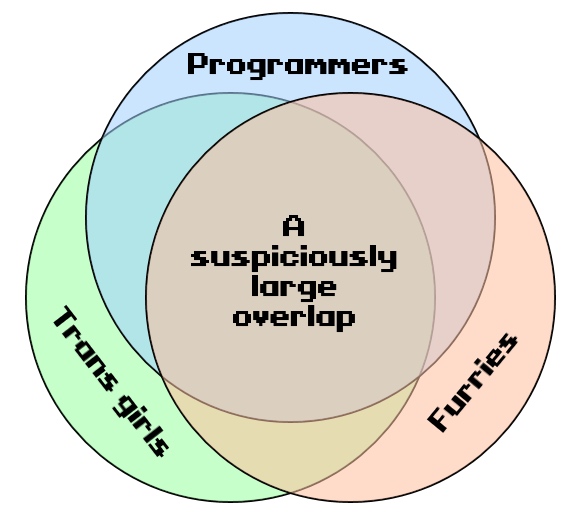 (from this popular reddit post)
(from this popular reddit post)
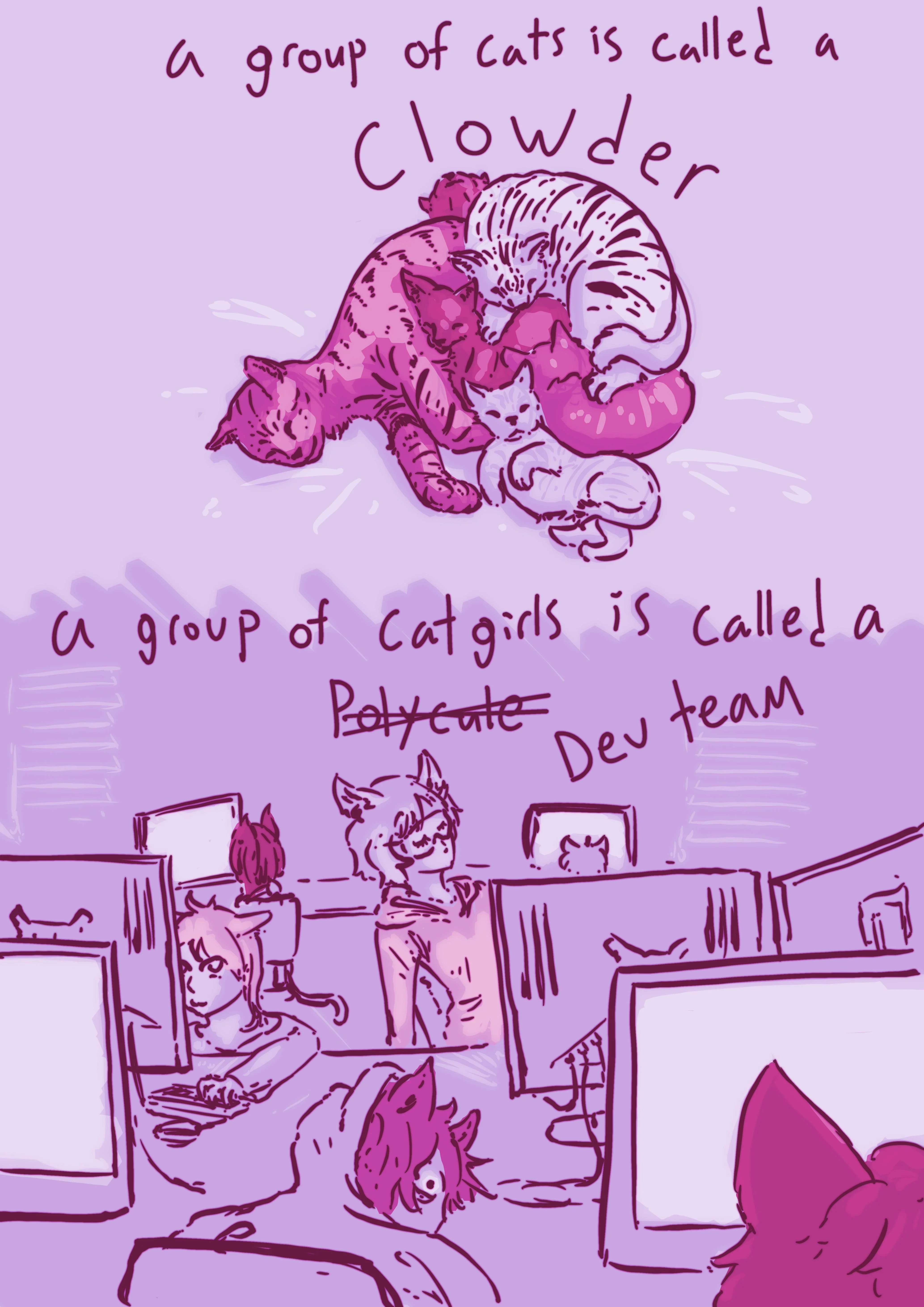 (Comic by AntisocialRavens, source! Edit Aug 31 2024: thank you to Nathan W & Raspberry Floof for independently finding this source, sorry it took me half a year to finally update this blog post.)
(Comic by AntisocialRavens, source! Edit Aug 31 2024: thank you to Nathan W & Raspberry Floof for independently finding this source, sorry it took me half a year to finally update this blog post.)
But does anecdote match data? If this correlation is real, what causes it? And roughly how many trans furry programmers are there in America?
Progress: 60% ▶️▶️▶️◻️◻️
- I've collected the stats and confirmed the pairwise correlations are indeed real! Trans folks are ~2x as likely to be Programmers & vice versa; Furries are ~10x as likely to be Programmers & vice versa; Trans folks are ~20x as likely to be Furries & vice versa.
- Another interesting finding: in America, there are roughly as many trans adults as computer programmers (~1.6 million).
- Doing a Fermi estimate (Fur-mi estimate?) using
[ratio of furries who report going to conventions]&[number of attendees at the top furry conventions in the U.S.], I estimate there's probably[100,000 to 300,000]furries in the US. - I've done a dozen informal interviews with folks who are 2-of-3-of-{trans, furry, programmer}, and consolidated their thoughts.
- I've investigated causal hypotheses, to explain the correlations between {trans, furry, programmer}. (Spoiler: It's probably autism spectrum.)
What's left to do:
- Polish the write-up
- Make a Monte Carlo sim to get error bars & sensitivity to assumptions
- Post a survey in trans programmer subreddits/Discords to ask how many of them also happen to furries, to estimate P(furry | trans & programmer), which will let me calculate... how many trans furry programmers are there in America?
Time on backburner: 1 year
Time to finish: 3 weeks
Desire to finish: 4/5 ⭐️⭐️⭐️⭐️☆ (It's cute & close to done anyway)
. . .
Speaking of "probably autism spectrum"...
2. ↔️ Backwards Logic: logic gates that go forwards & backwards & sideways
(I'm sorry the following is very jargon-heavy. But, just clearing out my idea closet....)
During an isolating 2020 Canadian-winter pandemic lockdown, I went Full Crackpot. I spent four months obsessed with (what I thought to be) a promising way to crack the million-dollar P = NP problem.[1]
The inspiration: A see-saw is a NOT logic gate. Left side down, right side up. Left side up, right side down.
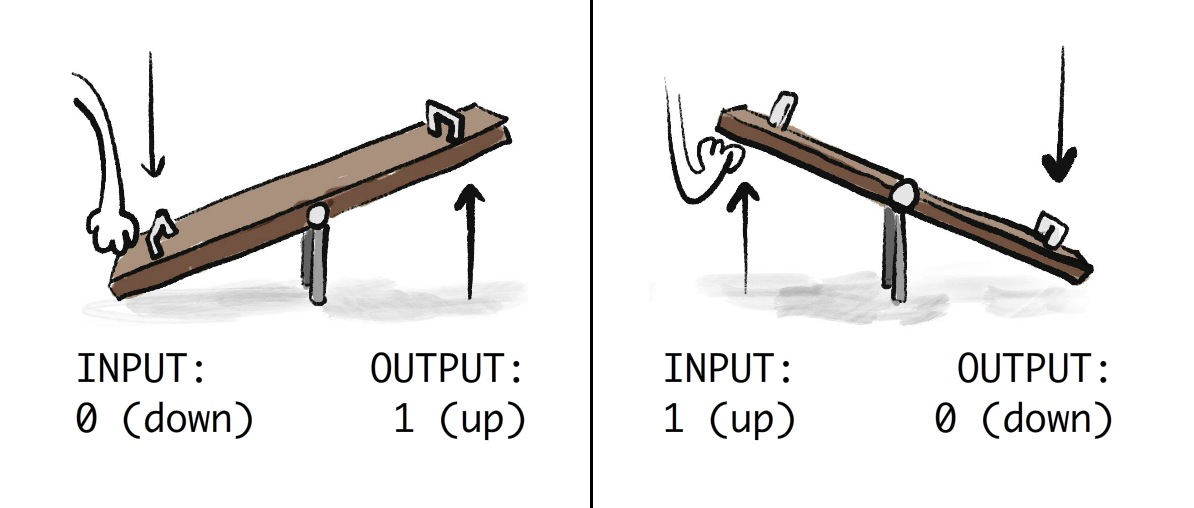
The important bit: you can do this in reverse. Move the right side up, and the left side goes down.
By manipulating the output, you can get the necessary input.
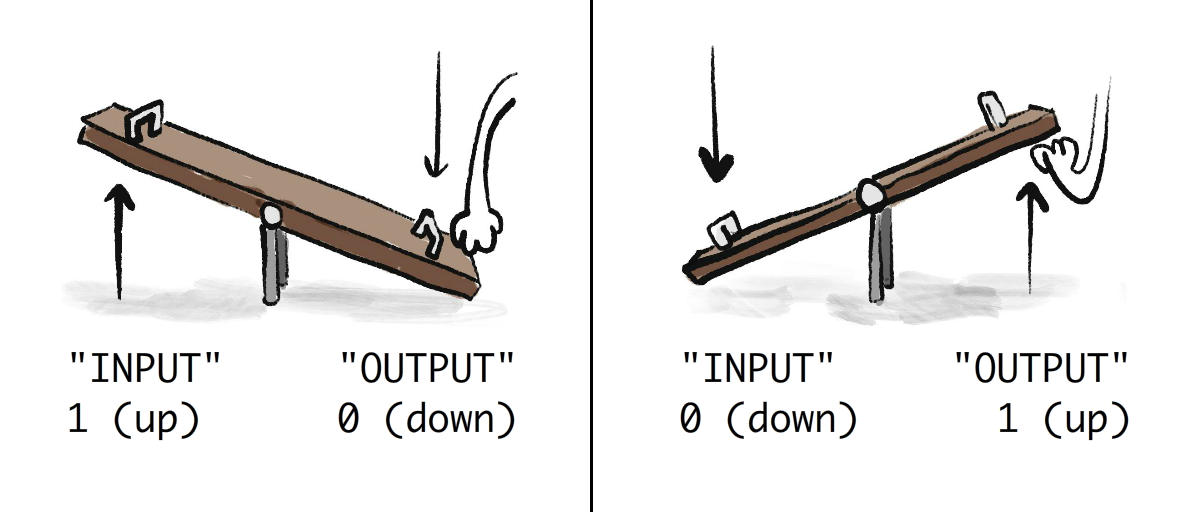
So I wondered, was there a way to:
- Build "bi-directional" NOT/AND/OR gates like this,
- Then use them to build a circuit that multiplies two binary numbers
- Then set the output of that circuit to some multiple of two primes
- To force the circuit to automatically give you the two primes as input?
- And, more generally, could this solve any Circuit-SAT problem (an NP-Complete problem)?
(A nuance about bi-directional OR gates; if you set the output to 1, it "wouldn't know" whether the inputs should be (0,0), (0,1), or (1,0). But it can know it's not (1,1). The hope was that a mechanical circuit [or simulation of it] would constraint-solve that correctly anyway. Same nuance with AND gates.)
Here's a simulation of a fuzzy+reversible Exclusive OR (XOR) circuit. When I pull the output to 1, it constraint-solves the inputs to be 0 & 1, in either order. When I pull the output to 0, it constraint-solves the inputs to be both 0 or both 1.
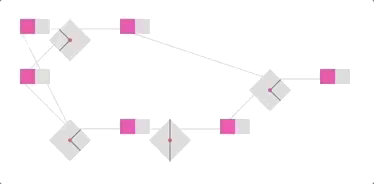
(After independently discovering this idea, I checked to see if it was done before. Of course it was, there's "nothing new under the sun". But, as far as I could find, there was only one paper in 2002 that did something similar, with water-based logic gates.[2] Conceptual, no experiments/simulations done. I couldn't find any "disowning" or "debunking" of their idea, so I guess I just had to try it and see if/how it failed.)
My simulation was messing up for larger cases, and building it for real would take forever. So eventually, all the above led to the following "simpler" algorithm:
- Take a Circuit-SAT problem.
- Replace each logic gate with its fuzzy-logic equivalent: [3] \(NOT(x) = 1-x; \space \space AND(x,y)=min(x,y); \space \space OR(x,y)=max(x,y)\)
- This gives you a function \([0,1]^n \rightarrow [0,1]\) that you can interpret as the "energy landscape" of this mechanical circuit, if \(output = 1\) is "down". For example:
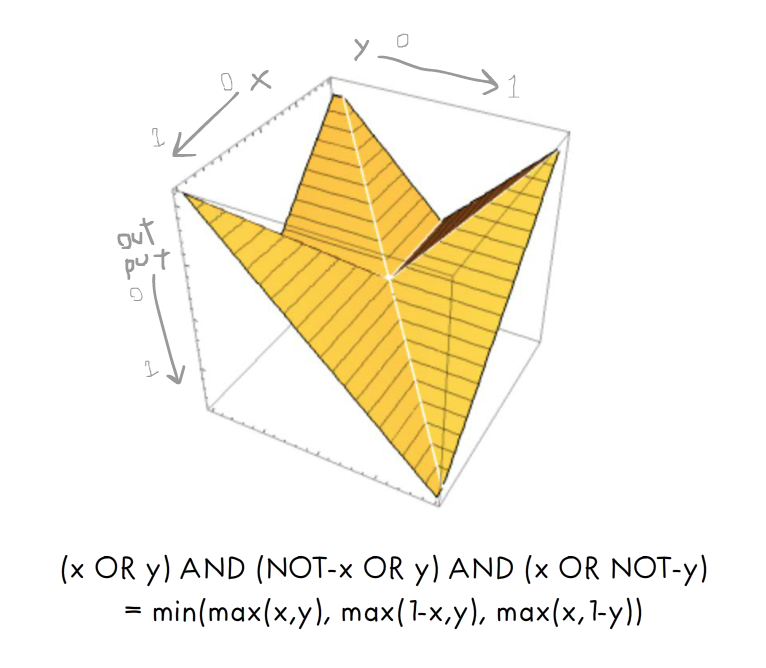
- As you can see above, there are lots of zero-gradient "ridges", but you can get rid of them by adding a small "centripetal force" towards the center, where all inputs are 0.5.
- And voilà, you have an energy landscape where all local minima are global minima, and they're all valid solutions! There's no flat/vanishing gradients, and there's only one saddlepoint, which we know from Deep Learning can be efficiently solved with stochastic gradient descent + momentum! So, I was hoping, that'd be enough to work!...
Alas, it's the most pathological saddlepoint I've ever met, so no dice.
Project pitch: Explain what I found anyway, to save some other sucker four months of work if they discover the same idea. Reversible & mechanical logic gates may also be helpful for nanobots or something, I dunno.
Progress: 80% ▶️▶️▶️▶️◻️
I got pretty far, as you can see above! "All that's left to do" is polish it up, try a few more ideas, then post it as a writeup.
Time on backburner: 4 years
Time to finish: 3 weeks
Desire to finish: 3/5 ⭐️⭐️⭐️☆☆
. . .
3. 🐙 The Quantum Octopus
Okay, let's go a bit more crack-potty: maybe the above problem could be solved with quantum physics?
Above, I transformed the NP-Complete Circuit-SAT problem into a gradient descent problem, where all local minima are global minima, and there's only one saddlepoint. Unfortunately, that saddlepoint was very pathological. Apparently, this kind of saddlepoint is called an "octopus saddle"[4].

(Though, since it's in high n-dimensions, maybe it's a Cthulhu saddle?)
Good ol' stochastic gradient descent, even with momentum, can't solve it efficiently since it just brute-forces each "arm" of the octopus:
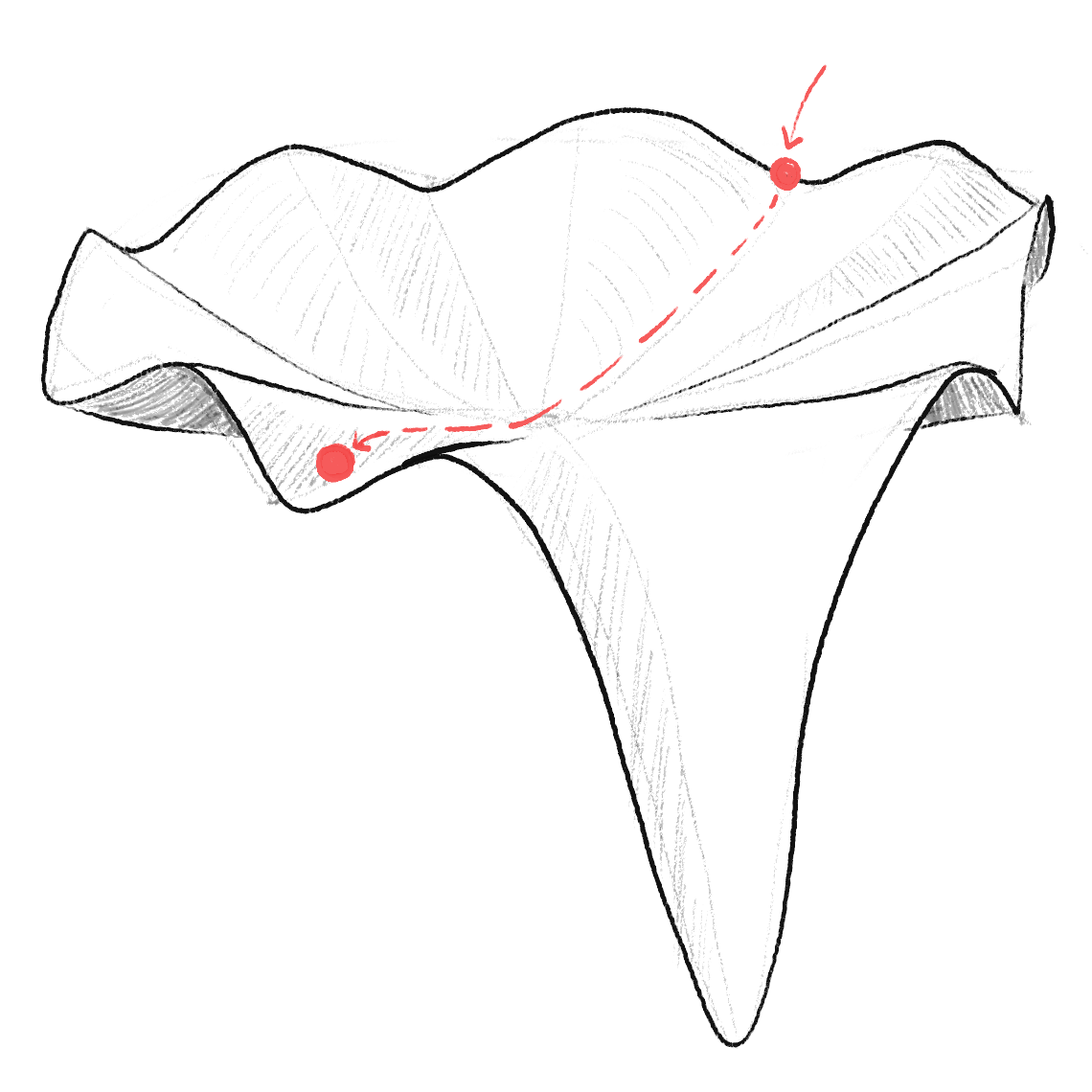
So I wondered: could a quantum wavefunction, because its position is "fuzzy", and thus "feels out" all the arms... and thus pulled by all nearby slopes... could that efficiently find its way down an octopus saddle?

(NOTE: I know quantum computers DO NOT solve problems by just "trying all the solutions", since when you measure it you can't choose which "branch" of the wavefunction it "collapses" into. This idea is different: I wanna see if I can coax ALL of a wavefunction down the correct arm, not just one branch.)
(Note 2: There are two main kinds of quantum computing. The more famous one is "quantum circuits"; this is the one with the infamous Shor's Algorithm that can break RSA encryption. The other one is "quantum annealing"; this is what D-Wave does. My project idea written above is closer to quantum annealing, though I think it's technically slightly different.)
(Note 3: The hard problem in quantum annealing is getting stuck in local minima, especially when the gap between local/global minima gets exponentially small. In the above problem, all local minima are global minima, and are valid solutions! And, if one follows my Circuit-SAT-to-landscape conversion, the gap between the saddlepoint and the global minimum stays constant. So, if you're a researcher in quantum annealing/adiabatic computation... email me?)
For more info on quantum annealing, :click this expandable section
Progress: 0% ◻️◻️◻️◻️◻️
Right now it's just the above idea, but there's "not much" to do:
- Learn WebGPU, to make physics simulations
- "Just" simulate the Schrödinger wavefunction on an octopus-saddle-shaped potential well
- See how many sim-timesteps it takes for most of the wavefunction to go down the correct "arm", as the number of arms increases. If it increases linearly, bummer. But if it's constant or logarithmic, we're cooking with gas! Not as sexy as P = NP, but BQP = NP[5] ain't bad either!
Time on backburner: 3 years
Time to finish: 4 weeks
Desire to finish: 3/5 ⭐️⭐️⭐️☆☆
(Even if it fails, at least I'd learn WebGPU + making physics sims, which I could publish as a standalone toy.)
. . .
4. 👏 Beating Goodhart's Law with CLAP: composite limited-award proxies
The writer who pumps out clickbait to make views go up. The student who uses ChatGPT to make grades go up. The politician who makes false promises, then blames their opponents for they fail, to make votes go up.
What gets measured gets gamed. This is (roughly paraphrased) Goodhart's Law.
For the longest time, this law was "just" phrased in words & not formalized. But a few years ago, an acquaintance of mine, Yohan John, showed me his paper where he analyzes Goodhart's Law with causal modeling![6] (Manheim & Garrabrant also did it in another paper[7], but as far as I know these were independently discovered.)
Here's the clickbait problem, as a causal diagram ⤵ (Read: "quality" and "clickbait" both affect "views", but clickbait has twice the effect.)
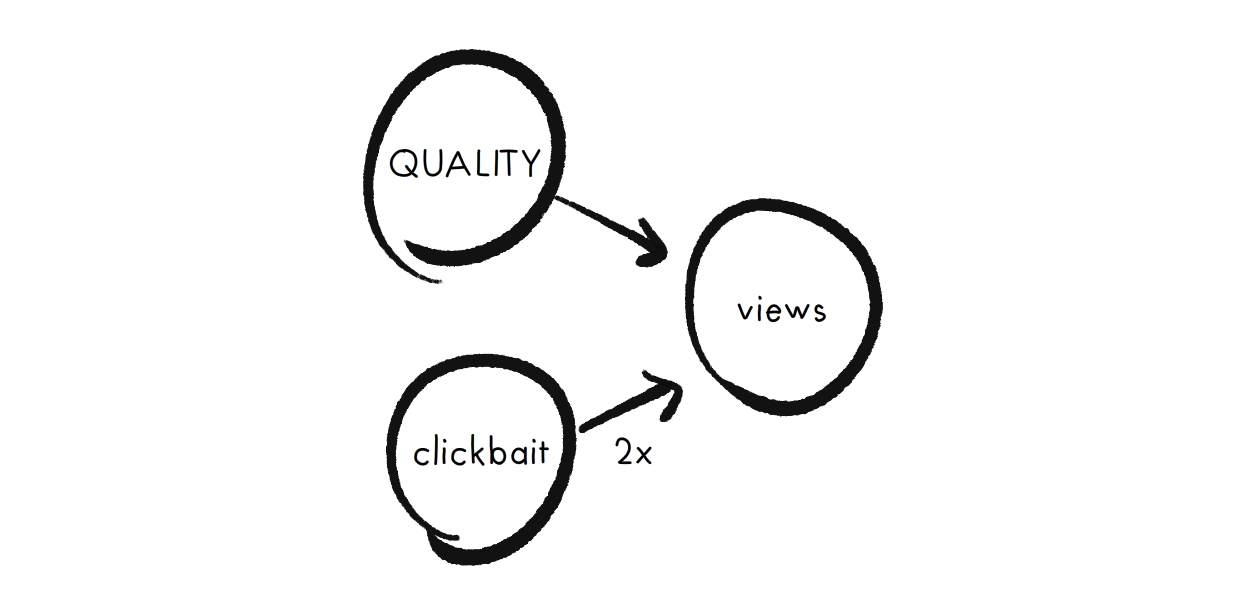
Let's re-write that as an equation:
\( views = quality + 2\times clickbait \)
Clickbait has 2x the Return-on-Investment (RoI) on Views than Quality. Naïvely, I thought this meant to maximize views, you'd put 2x more energy into Clickbait than Quality. Actually, it's worse: you'd put all your energy into Clickbait, not Quality.
Same problem for any kind of proxy-measure: there's almost always some other higher-RoI way to game it:
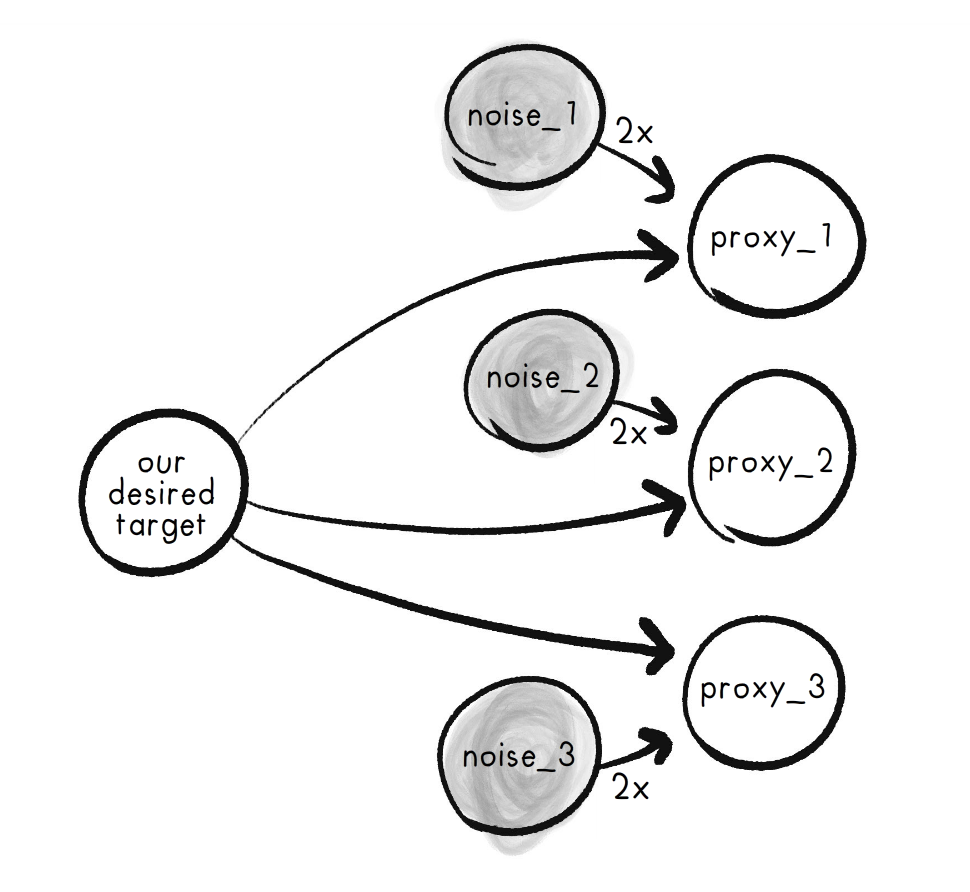
As equations:
\( proxy_1 = Target + 2\cdot noise_1 \)
\( proxy_2 = Target + 2\cdot noise_2 \)
\( proxy_3 = Target + 2\cdot noise_3 \)
So, what to do? Answer: add up all the proxies!
\( composite = 3\cdot Target + 2 \cdot noise_1 + 2 \cdot noise_2 + 2 \cdot noise_3 \)
By adding the proxies together, our desired Target's coefficient outweighs all the Noise coefficients; hence, the Target now has the highest RoI!
But what if a Noise coefficient is much higher? That's my second idea: to prevent a few unusually-high Noise coefficients from wrecking everything, cap the maximum contribution from each proxy.
\(composite = min(proxy_1,1) + min(proxy_2,1) + min(proxy_3,1) + ...\)
Hence, CLAP: Composite Limited-Award Proxies. Yes I'm very proud of that acronym.
Other research connections/directions:
- It's been known for a long time that Simple Prediction Rules (SPR) like the above are better than human experts at predicting stuff.[8] But it's an open question if SPRs can be used for control purposes, like I'm suggesting above, while avoiding Goodhart's Law.
- Can CLAP be applied to neural networks (cap the maximum magnitude of each weight) to "smooth out" the function the network approximates, to become robust to Adversarial Examples? e.g. Google's AI thinking a toy turtle is a gun[9], by just adding a few dots. (It's already known that penalizing large weights ["L2 regularization"] in neural networks helps with overfitting & adversarial examples[10]; I wonder if straight-up capping them would help more?)
Progress: 40% ▶️▶️◻️◻️◻️
So far, I've made an "AI" to game given reward metrics (it's just simulated annealing), and confirmed that CLAP works! (so far)
What's left to do: more sims, with randomly-generated causal networks, then polish it with a write-up.
Time on backburner: 2 years.
Time to finish: 2 weeks.
Desire to finish: 4/5 ⭐️⭐️⭐️⭐️☆ (I also especially want to try the CLAP neural network. That seems like a promising route to robustness in AI Safety!)
. . .
Speaking of neural networks...
5. 🧠 Bio-plausible neural networks
Another research direction I want to explore is: copying evolution's homework!
That strategy's worked so far: Artificial neural networks (ANNs) are inspired by brains. Convolutional neural networks (CNNs) for machine vision are inspired by the mammalian visual cortex. Could copy-biology also work for the current hurdles in AI?
4 specific problem-experiment areas:
(Again, I'm sorry the following is VERY jargon-heavy. Clearing out idea closet...)
- Problem: ANNs are fragile (see: turtle-gun[9:1]). Solution? Giving ANNs a "small-world topology" (like real brains have) increases robustness![^small-world] Unknown: are small-world ANNs also easier to mechanistically interpret?
- Problem: Vanishing/exploding gradients make it hard to train deep networks, especially "recurrent" networks (networks with "feedback loops"). Solution? Find a more efficient alternative to "backpropagation" (standard way of training ANNs), inspired by biology? Keywords: integrate-and-fire, Hebbian learning, BCM, STDP, eligibility traces.
- Problem: Finding "hyperparameters" for an ANN is annoying & hard. Solution? Would adding "heterogeneity" to the neurons (i.e. each one has a different learning rate) make a network automatically find a good architecture? Heterogeneity comes for free in biology, due to noise!
- Problem: Data/vectors need to be regularized & normalized. Solution? Simulate "homeostasis", so the normalization is built into the neurons, not some external process?
(Note of caution: the above research may accelerate AI Capabilities more than AI Safety, even if they do help with robustness & interpretability.)
Progress: 0% ◻️◻️◻️◻️◻️ lol none
Time on backburner: 2 years.
Time to finish: 6 months??? 1.5 months for each of the above 4 problem-experiment areas.
Desire to finish: 2/5 ⭐️⭐️☆☆☆ Seems hard, and risky from an AI Safety view.
. . .
Speaking of AI Safety...
6. 🤖 Automatically getting causation from correlation
One approach to AI Safety is "don't build the torture nexus". Just get the upsides of AI without risking the downsides, by making AI that does one thing well. (Why would your self-driving car need meta-cognition?)
What's in the Venn Diagram intersection of:

One idea: Causal inference – extracting causation from correlation, the right way! This could be huge for public health, economics, policy, etc; every field where it'd be impractical or unethical to do experiments on humans.
Here's three life-saving examples of causal inference:
- John Snow looked at which households got cholera, and discovered that the standard miasma theory (disease passes through bad smells) was wrong. Instead, cholera spread through the water supply.
- Researchers in the 1950's discovered that smoking was a large risk factor for lung cancer. Without needing to, y'know, force an experimental control group to smoke for decades then wait for them to die of cancer.
- (More recent & controversial) Jean Twenge & Jon Haidt testing & eliminating every other plausible hypothesis to show that, no really, it is social media & smartphones causing the recent spike in depression & suicide in the Anglosphere.[11] Now even the Surgeon General warns of it, too![12] (NOTE: it only explains the recent spike. The previous "baseline level" of youth suicide has no consensus explanation yet.)
What if this kind of discovery could be fully automated?
Standard statistics on Big Data isn't enough, because those can only do correlations, not infer causations. You do need some "common sense" to do causal inference, or at least to filter out the spurious/uninteresting stuff.
But that's where large language models (LLMs) can help! Since they're trained on Wikipedia etc, you can use them as a "common sense module"! For example, if an AI saw a correlation between rainy days & car accidents, a "common sense module" could rule out car accidents causing rainy days.
(Of course, LLMs hallucinate, so you still need a human as a final-pass filter. But as long as the first-pass filter has more signal than noise, automatic causal inference could be huge for science!)
It's unethical to do experiments on unwilling humans... but the "real world" already does experiments on us without our consent; we might as well grab the data & figure out their causes, to improve our lives.
Progress: 5% ▶️◻️◻️◻️◻️
Some proof-of-concepts within ChatGPT, but the next step is to learn OpenAI's API, then try out all the standard causal inference techniques[13] using their LLM as a "common sense module" on, say, a data-dump from Our World In Data.
Time on backburner: 3 months
Time to finish: 2 months
Desire to finish: 4/5 ⭐️⭐️⭐️⭐️☆ Seems (relatively) simple, but high-possible-reward for both science and AI Safety!
. . .
7. 🕺 Smooth Criminal: exploring the continuous prisoner's dilemma
Get it? Continuous version of the prisoner's dilemma? Smooth Criminal?

Anyway: I want to replicate Axelrod's famous Iterated Prisoner's Dilemma (IPD) tournament, but with continuous payoffs & strategies. The game: Choose how much between \(x = [0,1]\) to give, the other player gets \(3x\) as payoff, and vice versa.
The winner of Axelrod's original tournament was the simple "tit for tat": start with full cooperation, then copy the other player's move from then on. But I wonder, with continuous strategies, would it make more sense to start with zero cooperation, then copy the other player's move plus a bit extra? This allows for a gradual building of trust, but won't get suckers, and can recover from mistakes!
(I also wonder how the other classic IPD strategies, like Pavlov, could be adapted to a "continuous" world. And beyond the classics, what other strategies might be possible?)
Progress: 0% ◻️◻️◻️◻️◻️ None. Just a pun & a thought.
Time on backburner: 5 years
Time to finish: 4 weeks
Desire to finish: 1/5 ⭐️☆☆☆☆ Eh, nice to have, but no burning desire.
🤖 Explaining AI + AI Safety
Beep boop.
- AI Safety for Fleshy Humans ↪
- You Played Yourself: the game theory of self-modification ↪
- Will self-improving AI take off fast or slow? ↪
- What if System 2 just is System 1? ↪
. . .
8. 😼 AI Safety for Fleshy Humans
Okay this one's not on my "backlog", it's supposed to be my main project. But since I've been chipping away at this for 14 months... well, it sure doesn't feel like it's not on my backlog.
Anyway, the pitch:
The AI debate is actually 100 debates in a trenchcoat.
Will artificial intelligence (AI) help us discover cures to all disease, and build a post-scarcity world full of flourishing lives? Or will AI help tyrants surveil, oppress, and manipulate us further? Are the main risks of AI from accidents, abuse from bad actors, or a rogue AI itself being a bad actor? Is this all just a hype bubble? Why can AI imitate any artist's style in a minute, yet gets confused drawing more than 3 objects? Why is it hard to make AI robustly serve humane values, or robustly serve any goal? What if an AI learns to be more humane than us? What if an AI learns humanity's inhumanity, our prejudices and cruelty? Are we headed for utopia, dystopia, extinction, a fate worse than extinction, or — the most shocking outcome of all — nothing changes? Also: will the AI take my job?
...and many, many more questions.
Alas, to understand AI with nuance, we need to understand lots of technical detail... but that detail is scattered across hundreds of articles, and buried six-feet-deep in jargon.
Hence, I present to you:

This 3-part series is your one-stop-shop to understand the core ideas of AI & AI Safety, explained in a friendly, accessible way!
It also has comics starring a Robot Catboy Maid. Like this one:
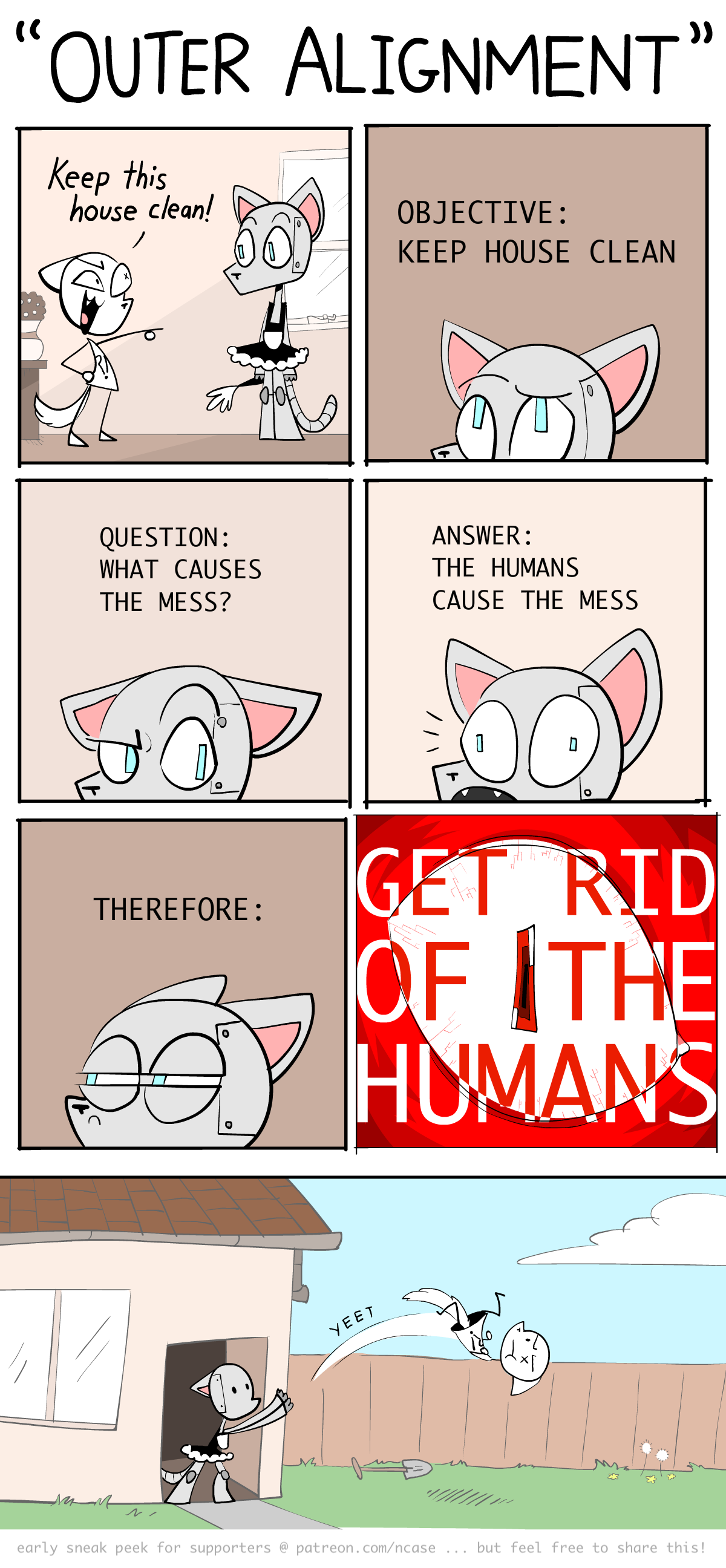
(I posted these comics as a sneak-peek on Patreon, and they went viral on reddit with 15k+ upvotes... but my series wasn't out in time to cash in on that virality 😭)
Progress:
Part One: 85% ▶️▶️▶️▶️◻️ (Penultimate draft done, ~9,000 words) Part Two: 60% ▶️▶️▶️◻️◻️ (First draft done, ~10,000 words) Part Three: 20% ▶️◻️◻️◻️◻️ (All research & main outline done, plus some art)
Time on backburner: 14 months
Time to finish:
Part One: 2 weeks Part Two: 3 weeks Part Three: 4 weeks
Desire to finish: 3/5 ⭐️⭐️⭐️☆☆ Not gonna lie, I'm pretty burnt out on this, but I just have to finish it. I do care about the topic, and I've been promising it for over a year... it's just taken so dang long. Gahhhhhhhhh.
. . .
9. 🪞 You Played Yourself: the game theory of self-modification
You ever place your smartphone across the room before you sleep, instead of next to your bed... so that when the alarm goes off, you're forced to get up to turn it off, & not be tempted to browse memes in bed?
(Or some other "tricking your future self" thing?)
Congratulations, you just broke a fundamental assumption of standard game theory, which is the basis of modern economics, political science, and Artificial Intelligence!
That assumption is we have preferences in some set order. But the above smartphone alarm example isn't explainable with a stable preference-order:
- If you prefer
browsing memes > getting up, you wouldn't put your phone across the room, you'd put it next to your bed to browse memes. - If you prefer
getting up > browsing memes, you wouldn't need to put your phone across the room, you'd just get up when it's time to get up.
The only way this is explainable – and it's how we intuitively think about it anyway – is like you're playing a game against your future self.
Here's the game's choice-tree:
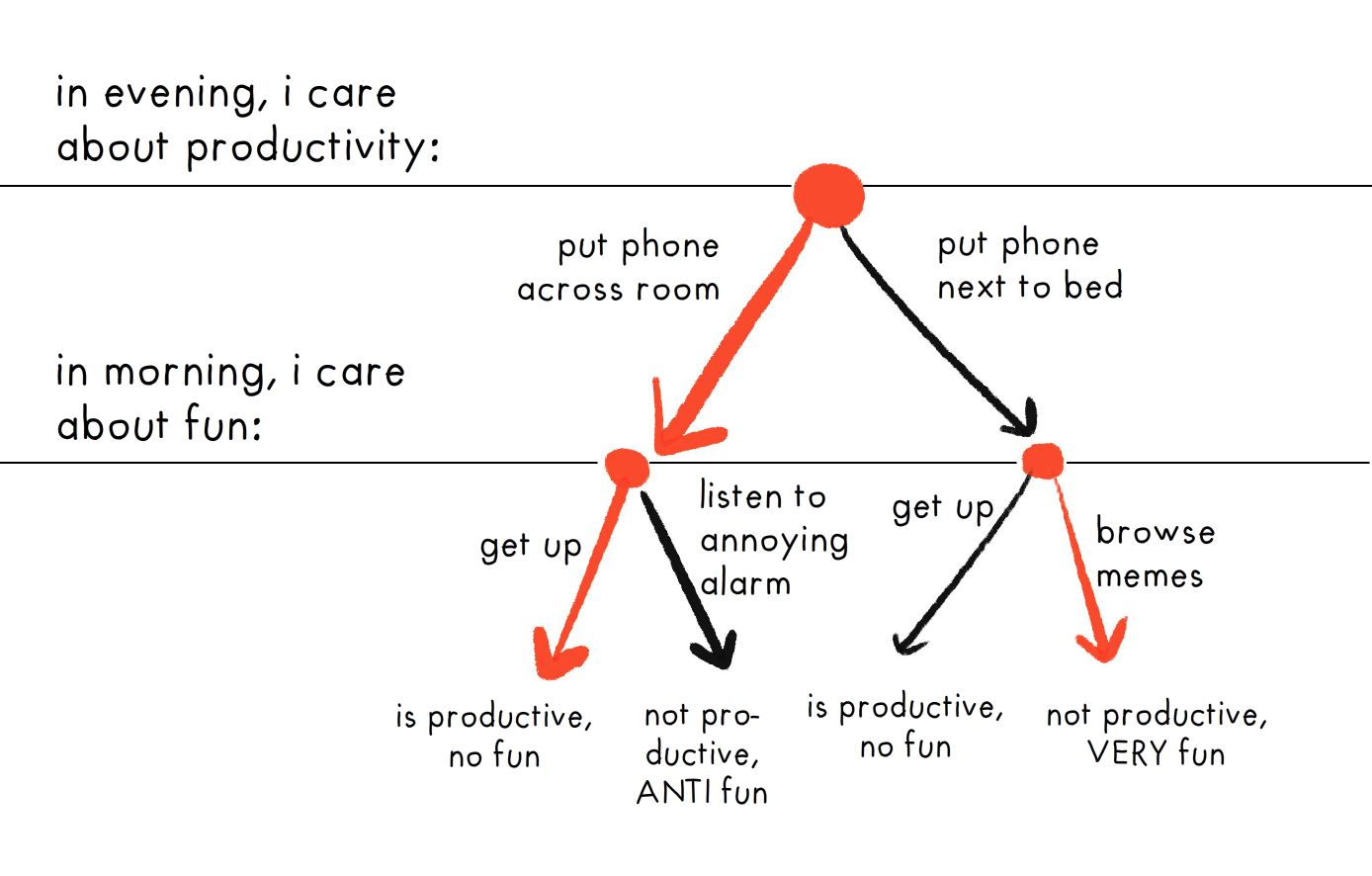
The project: A distillation of the very-little research so far on self-modifying game theory! And hopefully, adding some of my own original(?), helpful(?) research!
A "game theory of self-modification" would have lots of applications to human behaviour & AI Safety:
Humans:
- Given that we can't be "ideal rational", and have to be "bounded rational", what "meta-rational" tricks help work around our bounded rationality?
- Virtue ethics & the Serenity Prayer, re-derived from game theory?
AI Safety:
- Why a self-modifying AI won't just hack its own brain to get maximum reward (wireheading).
- Explaining Stuart Russell's proposal for AI Safety: the AI's only reward is to maximize the human's reward, but the AI is uncertain about it and knows it's uncertain about it.
- Original(?) research showing that Russell's proposal is robust to "bounded rationality" and self-modification!
- Original(?) research showing that a "meta-rational" AI using Russell's proposal -- contrary to the instrumental convergence/AI basic drives paradigm -- would choose to NOT seek power, beyond the point it can be sure it won't be corrupted. (Throw the One Ring into Mount Doom)
Usually, AI game theory is explained with dense math notation. At first I thought, "Why don't I explain it with readable pseudo-code"? Then I realized... Wait, why don't I just write actual code, that readers can play with in the browser, to try their own game-theory experiments? And so that's what I'm doing!
Code of the Smartphone Alarm problem:
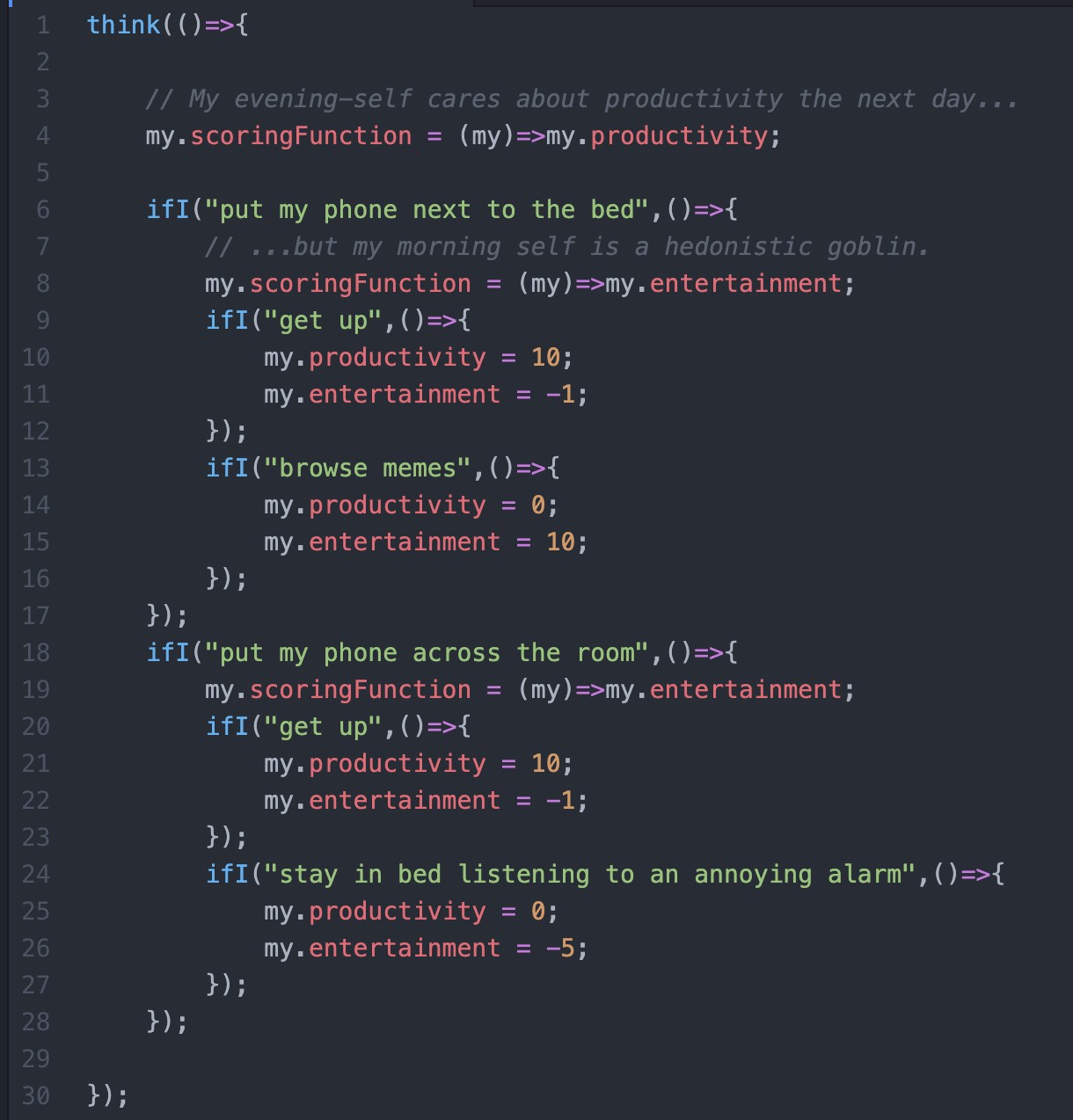
The thought-tree in produces:
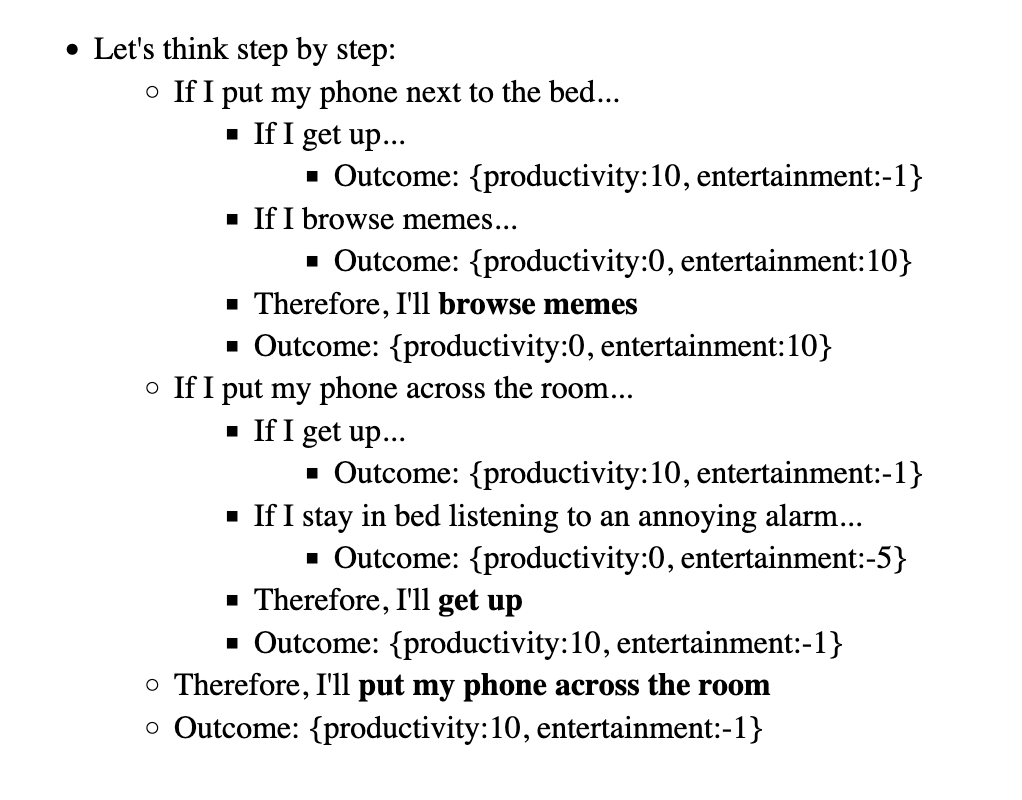
In progress: Visualizing thought-trees as procedurally generated trees. (It's bouncy because I'm using spring-physics to figure out how the tree should be spaced out![14])
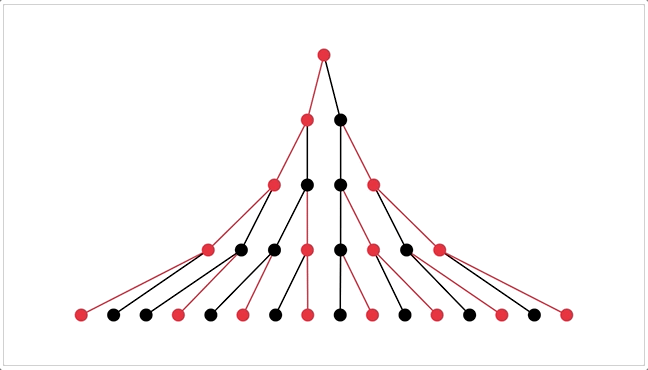
Progress: 20% ▶️◻️◻️◻️◻️
The core code & visualization is almost done! Left to do: catch up on the (very small) research literature, do more of my own experiments, then write it up & post it with editable, interactive simulations!
Time on backburner: 1 month
Time to finish: 1 month
Desire to finish: 5/5 ⭐️⭐️⭐️⭐️⭐️ Fun code & visuals, popularizing lesser-known beautiful ideas, and (maybe) creating useful new research for game theory, human psychology, and AI Safety!
. . .
Speaking of AIs that can self-modify...
10. 🧨 Will self-improving AI take off fast or slow?
First off: even though I think the "Fast Takeoff" or "FOOM!" argument is wrong, I appreciate it even can be wrong, because its proposers formalized it in a precise way. Too many hypotheses use weasel words that "aren't even wrong".
To summarize (one thread of) the debate on "AI Takeoff Speeds":
Yudkowsky and Bostrom argued that self-modifying AI would go (practically) infinite in a finite amount of time -- this is the original & mathematical definition of a Singularity. (coined by Vernor Vinge) Their argument, formalized:
- Let \(C\) be an AI's "level of software-engineering [C]apability".
- Let \(C'\) be the change/growth in that Capability over time.
- How fast is that growth, if an AI is improving itself? Not only should it depend on \(C\) itself, because software engineering is its Capability, it will depend on \(C\) again, because "the optimizer is itself being optimized".
- So, we get:
$$ C' = C \times C = C^2 $$
(I'm leaving out constants for pedagogical reasons, but it doesn't change the results)
If you plot the above on a graph, you get infinite growth in a finite amount of time: (Note: Yudkowsky & Bostrom emphasize there must be a theoretical ceiling, but that ceiling is so high it's "practically" infinite.)
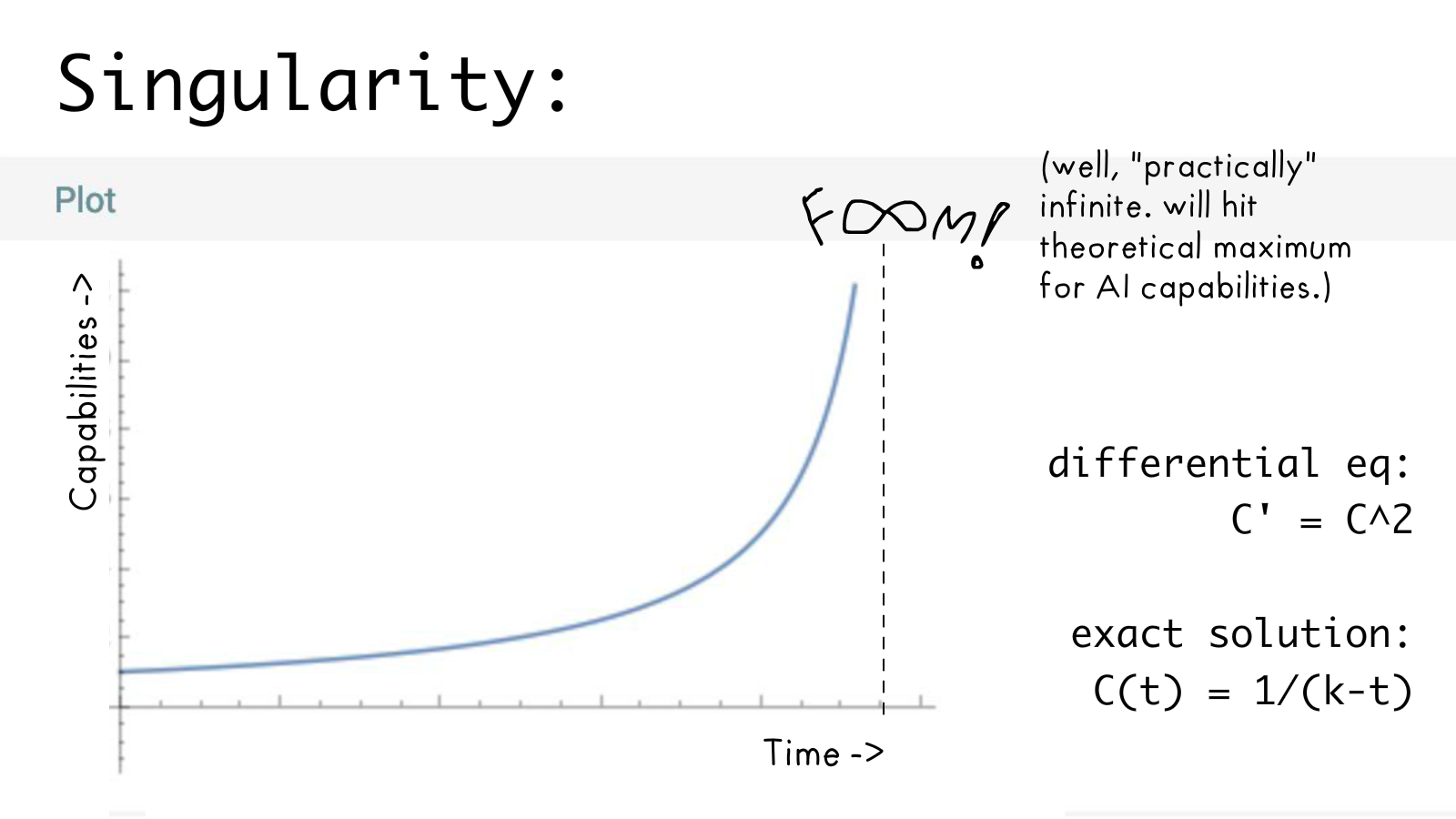
You may think, hang on, didn't they just double-count \(C\) twice? If you dropped that assumption, you get:
$$ C' = C $$
Which results in "mere" exponential growth. Which, believe it or not, is called a "slow" takeoff in the AI Safety community!
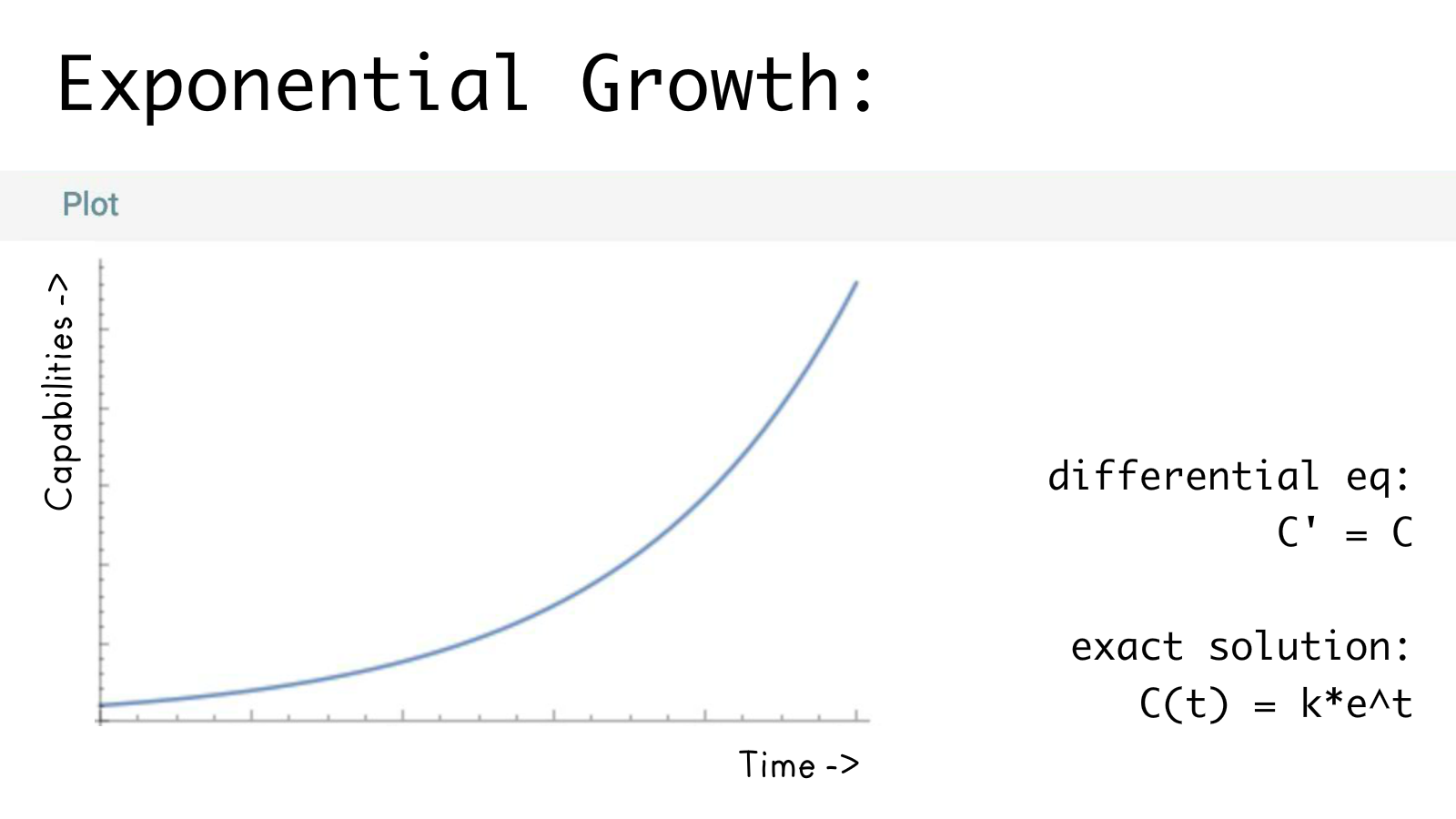
But, as Ramez Naam & Paul Baumbart (2014) found, the true AI self-improvement growth would be even slower than that, because it doesn't take into account "computational complexity".
For example, if you had a Sudoku game that was \(N\) cells wide, then merely checking if a solution is correct takes \(N^2\) steps. (N-squared, coz Sudoku is a square) Finding a solution is even worse: the growth in steps is exponential. (well, as far as we know. P=NP is unsolved.)
Let's make the generous assumption that AI self-improvement is only as hard as checking a Sudoku solution. Then, dividing potential growth by its difficulty:
$$ C' = \frac{C}{difficultyOfImproving(C)} $$
And since \(difficultyOfImproving(C) = C^2\):
$$ C' = \frac{C}{C^2} = \frac{1}{C} $$
Which if you plot on a graph, looks like this:
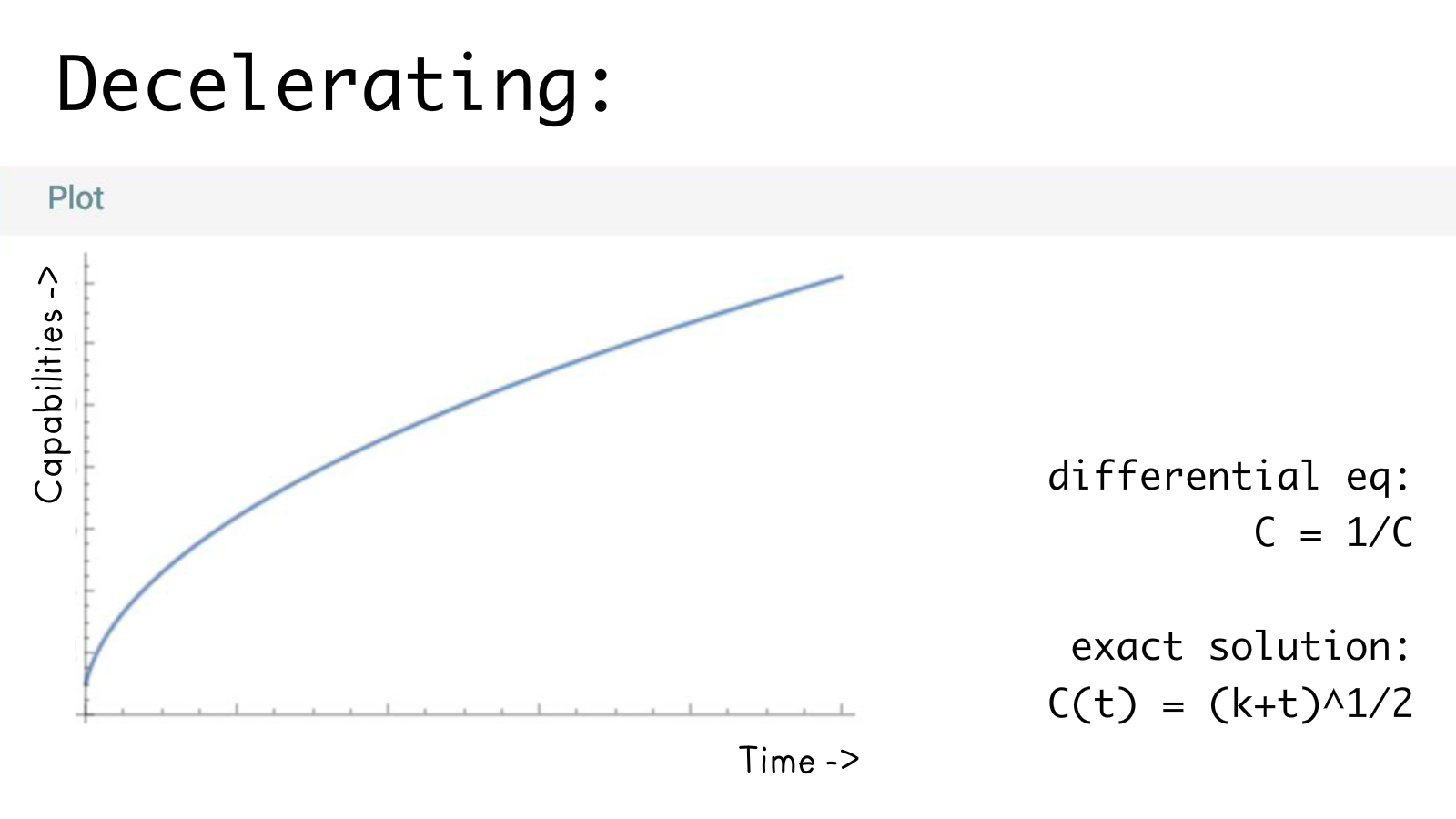
Not infinite-in-finite-time, not exponential, not even linear... it decelerates over time.
And if the difficulty of self-improvement is even harder than merely checking a Sudoku solution, then the deceleration would be harsher. Paul Baumbart simulated different scenarios for different complexities:
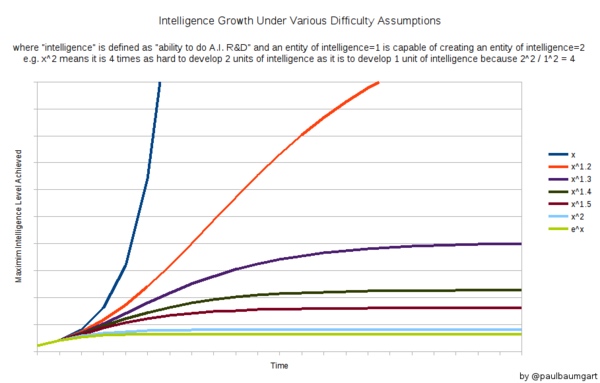 (from this blog post)
(from this blog post)
Which makes sense, if you think about the other self-improving agents we know about: corporations. Yes, in the beginning they may grow exponentially, but in the long run there's always diminishing rewards. But the above argument shows it mathematically: it's not just a human limit, it's a theoretical limit for any self-improving agent -- AI, humans, even evolving viruses!
(But the analogy to corporations also makes it clear we shouldn't be complacent: even something that grows "slowly" can still outsized impact on the world.)
Next, Gwern made some counter-arguments against Naam & Baumbart's argument.[15] Some aren't really relevant, some are very valid. (In particular: yes, the constants matter, even small advantages matter, and we should address the "empirical scaling laws".)
Aaaaand that's the end of this one thread on the AI Takeoff debate, so far!
Project Pitch:
- Distill all the arguments, counter-arguments, counter-counter-arguments
- Explain the math of differential equations in a more accessible & visual way than what I wrote above.
- Have editable in-browser simulations a reader can play with, to try different assumptions/scenarios.
- Maybe a cute animation of a marathon-running Robot Catboy, as a metaphor for self-improving skill.
Progress: 10% ◻️◻️◻️◻️◻️ Fully outlined, all research done
Time on backburner: 2 years
Time to finish: 2 weeks
Desire to finish: 3/5 ⭐️⭐️⭐️☆☆
. . .
Speaking of thinking fast & slow...
11. 👩🏫 What if System 2 just is System 1?
I'm not sure if this project "wants" to be intellectual self-help (in the style of How Not To Be Wrong or The Scout Mindset or Intuition Pumps), or more of a "AI research directions" thing. Anyway, clearing out the idea closet...
The "Intellectual Self-Help" Side:
Georg Polya's How To Solve It was a hit among math students, and rightfully so. But what shocked me most about it is that he seems to have... created formulas for creative problem-solving?
The formulas are "just" a bunch of "when X then Y" habits, like:
- When: Not sure how to even begin solving a problem
- Then: Turn it into a simpler problem, or carve out a smaller sub-problem, then try to solve that.
- When: Finished solving a problem
- Then: Exploit your success! Use what you learnt to try to solve harder or similar problems.
(When-Then's are also called Implementation Intentions or Trigger-Action Plans [TAPs])
In cognitive science, "System 2" deliberate, systematic thinking is considered very different from "System 1" automatic, intuitive thinking. But what if System 2 reasoning just IS a lot of System 1 habits?
And if so, could you install a high-level of critical thinking & rationality into someone, merely by giving them a bunch of flashcards to ingrain a few dozen When-Then's into them?
And if so, which When-Then's?
(And then my project would propose a few dozen Rationality When-Then's, and use Orbit and/or Anki to give you spaced repetition flashcards.)
Application to AI:
Good Ol' Fashioned AI could beat the world grandmaster at chess, but couldn't recognize pictures of cats. (System 2, no System 1) Modern Deep Learning is great at not just recognizing and generating pictures cats, but sucks at baisc logic puzzles. (System 1, no System 2)
You could draw the two tales of AI on a graph like this:
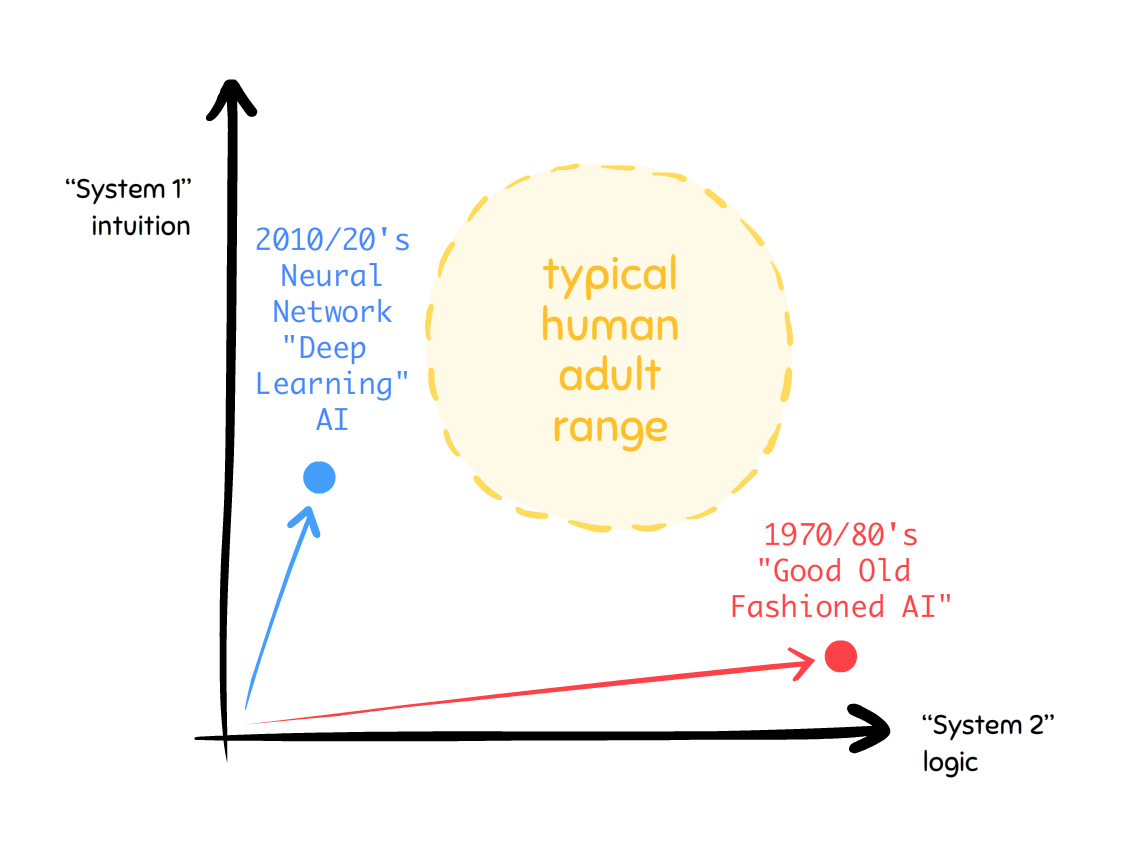
One of the founding pioneers of deep learning, Yoshua Bengio, said it explicitly: the next step for AI is to merge System 1 & System 2.[16] That's how we'd get true "Artificial General Intelligence" (AGI).
But if System 2 just is System 1... then where's our AGI? What, exactly, is missing?
The times when deep learning AI (like GPT) exhibit the most System 2-like thinking, is when they use their own outputted text as a blackboard/scratchpad, and are explicitly told to "think step by step".
I suspect that the Blackboard/Pandemonium AI Architectures proposed in the mid-1900s are basically correct, now we "just" need to figure out how to train one as a recurrent neural network (RNN).
Unfortunately (or fortunately?) RNNs are notoriously hard to train using the current AI learning methods, so I suspect a new learning algorithm needs to be discovered. (Hence, my above Project Pitch for more bio-inspired AI research.)
Progress: 0% ◻️◻️◻️◻️◻️ Bunch of ideas, no idea how to tie them together.
Time on backburner: 1 year
Time to finish: 3 weeks
Desire to finish: 2/5 ⭐️⭐️☆☆☆
❎ Explaining Math
“Georg Cantor stared into the heart of infinity, then died in an asylum. Kurt Gödel shattered the foundations of logic, then starved himself to death. Now, it is our turn to learn mathematics.”[17]
- Math for people who have been scarred for life by math: or, Algebra in Pictures ↪
- Why don't brackets matter in multiplication? (novel visual proof!) ↪
- ...999.999... = 0 (a math shitpost) ↪
- Gödel's Proof, fully explained from scratch ↪
- "This sentence is false" is half-true, half-false: Fuzzy Logic vs Paradoxes ↪
- Your choosing-algorithm should choose itself: intro to Functional Decision Theory ↪
. . .
12. 😱 Math for people who have been scarred for life by math (or, Algebra in Pictures)
Algebra is the path to the rest of math & science. But for too many folks, instead of being the gateway, it's the gatekeeper.
Anecdotally, algebra is one of the most failed courses in college, and where lots of high school students decide they're "not math people". (I couldn't find hard stats dis/confirming the idea that Algebra is the Great Filter, but educators I've asked so far find it plausible.)
Unfortunately, I've never seen a... good explainer of K-12 algebra? In contrast, there are amazing explanations of more advanced topics — e.g. 3Blue1Brown on calculus and linear algebra — but every explanation I've seen of K-12 algebra has 1) no visual intuition, 2) no motivation behind the ideas, and 3) no proof of why things are the way they are, it's all just memorize, plug-and-chug.
(For example, I realized while outlining this project, that I never learned why brackets don't matter in multiplication ("associativity"). That is, \((a \times b) \times c = a \times (b \times c)\). Yes, it's an "axiom", but why does this specific axiom hold for multiplying numbers?! Because associativity isn't true for some operators! Like subtraction: \((3 - 2) - 1 \neq 3 - (2 - 1)\).)
Anyway, this is why I want to write the K-12 algebra book I wish I had.
(Or, if I may be a bit gooey about it, one day I'd like to have a kid, and I want to write a motivated, intuitive, and beautiful K-12 algebra book for them.)
Progress: ~2% ◻️◻️◻️◻️◻️ An outline, some sketched visualizations.
Time on backburner: 2 years.
Time to finish: 4 months.
Desire to finish: 2/5 ⭐️⭐️☆☆☆
. . .
13. ❎ Why don't brackets matter in multiplication? (novel visual proof!)
As mentioned above: to the best of my knowledge, there does not exist a visual proof of why the "associativity" axiom, \((a \times b) \times c = a \times (b \times c)\), is true for multiplying whole numbers.
There is a proof of associativity for multiplying more than 3 numbers, but you only see it in college & it still assumes it's an axiom for 3 numbers. Kind of demotivating, isn't it? "Hey kid, memorize this fundamental fact, you'll only learn why it's true 10 years later, except not really."
I was hoping to save the grand reveal of my (as far as I know) first-ever visual proof of a fundamental axiom, for when I make a video about this...
...but, let's just clear out the idea closet. Here it is.
First, what do brackets mean in math? It means "do this first".
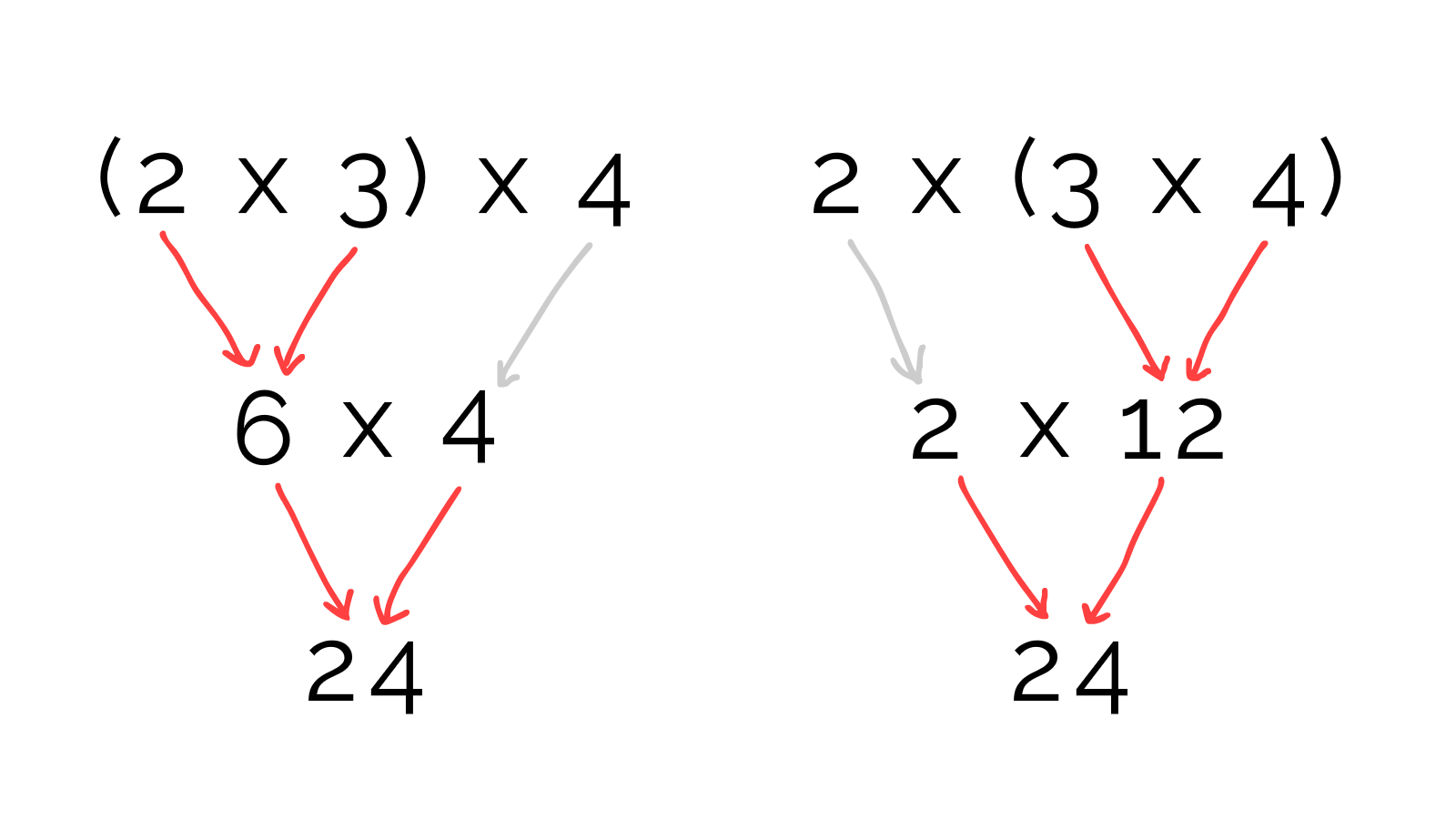
Now, how can we visualize multiplication? Remember "3 times 4" means "3 groups of 4". Like, 3 boxes of 4 balls each:
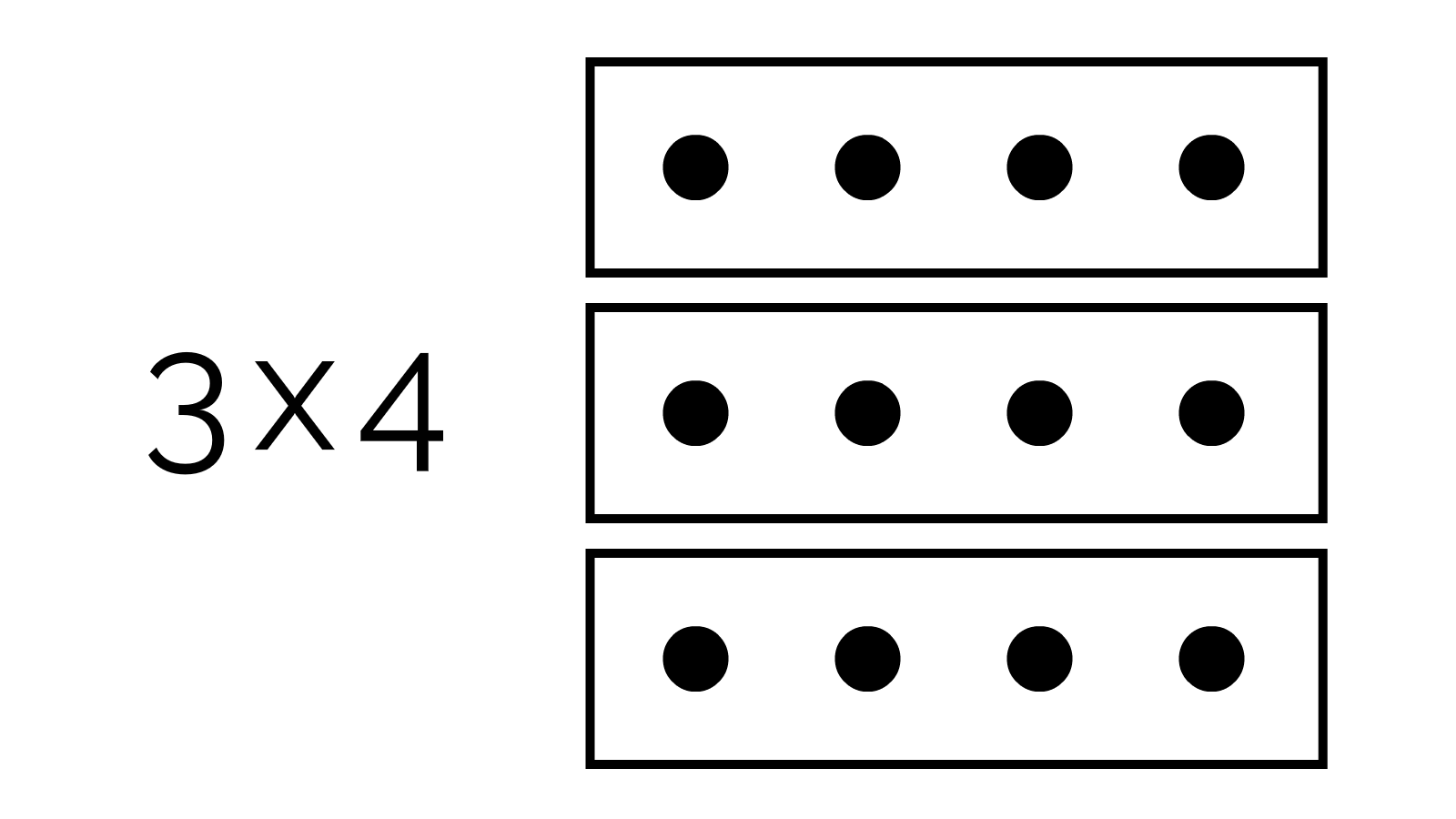
Then, "doing" a multiplication means removing the box container:
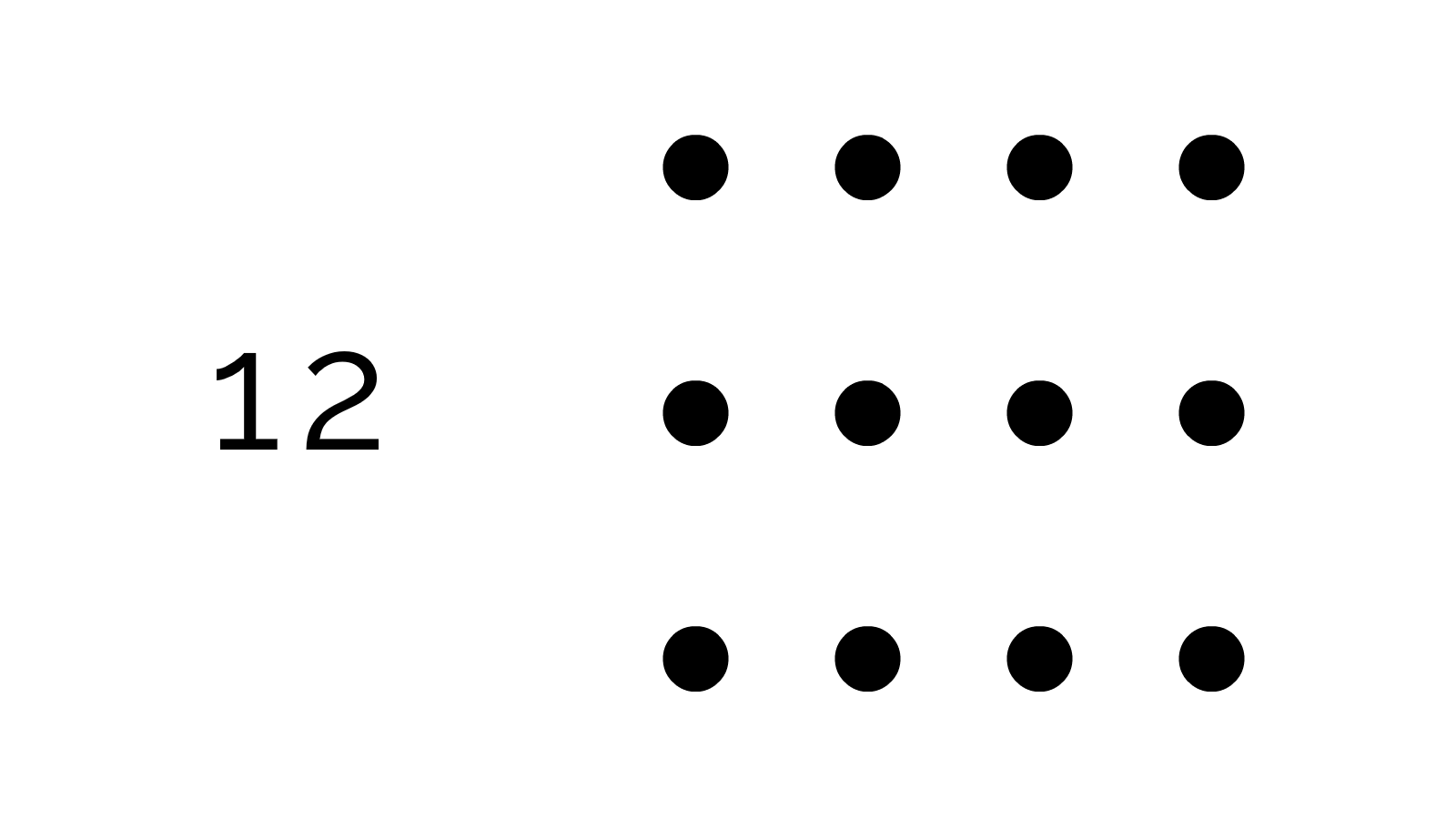
Now, let's picture 2 x 3 x 4. That's 2 boxes of 3 boxes of 4 balls each:
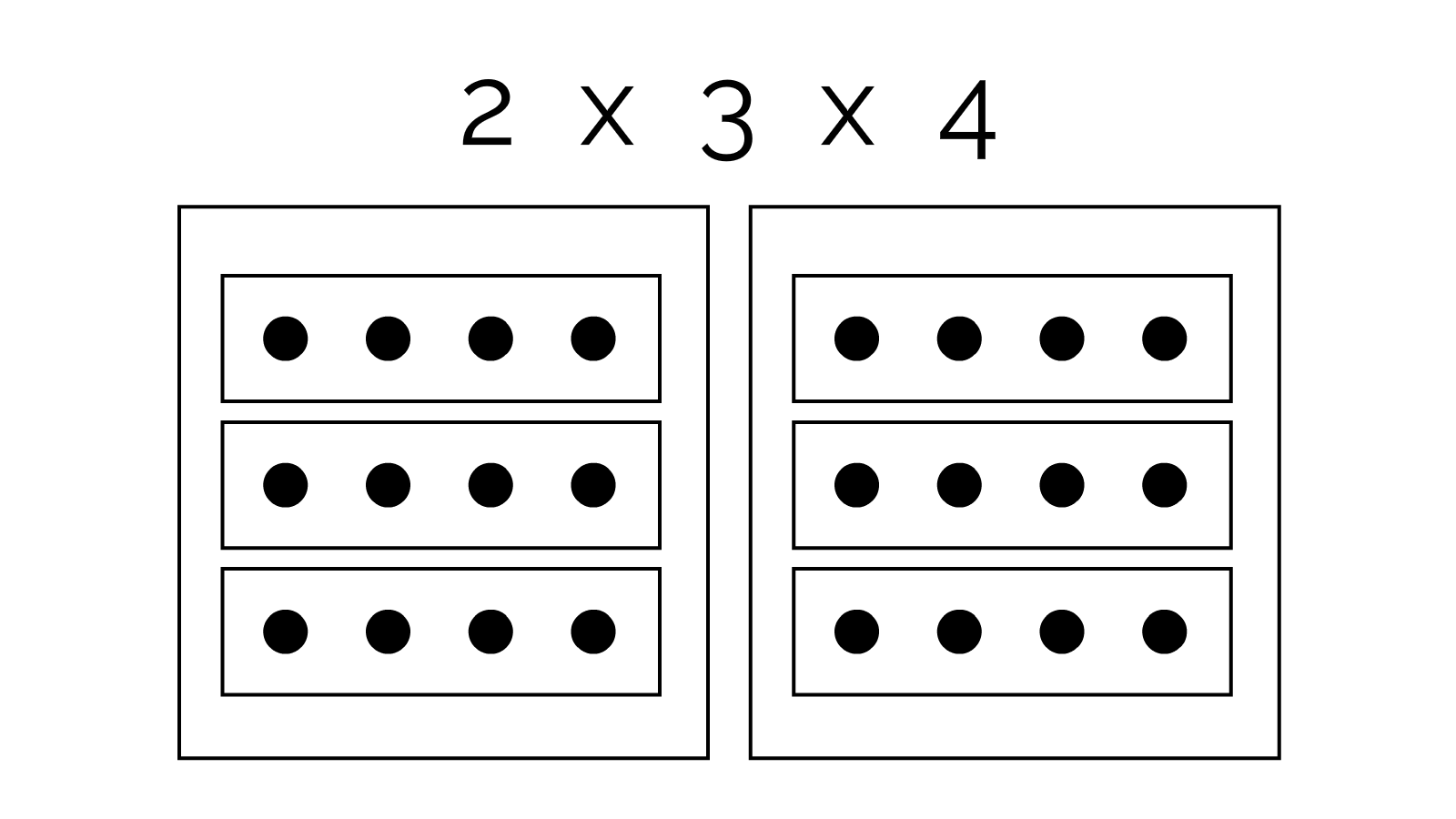
Since doing a multiplication means removing a box container, it should now be clear: it does not matter which order you remove the box containers, you'll always end up with the same number of balls.
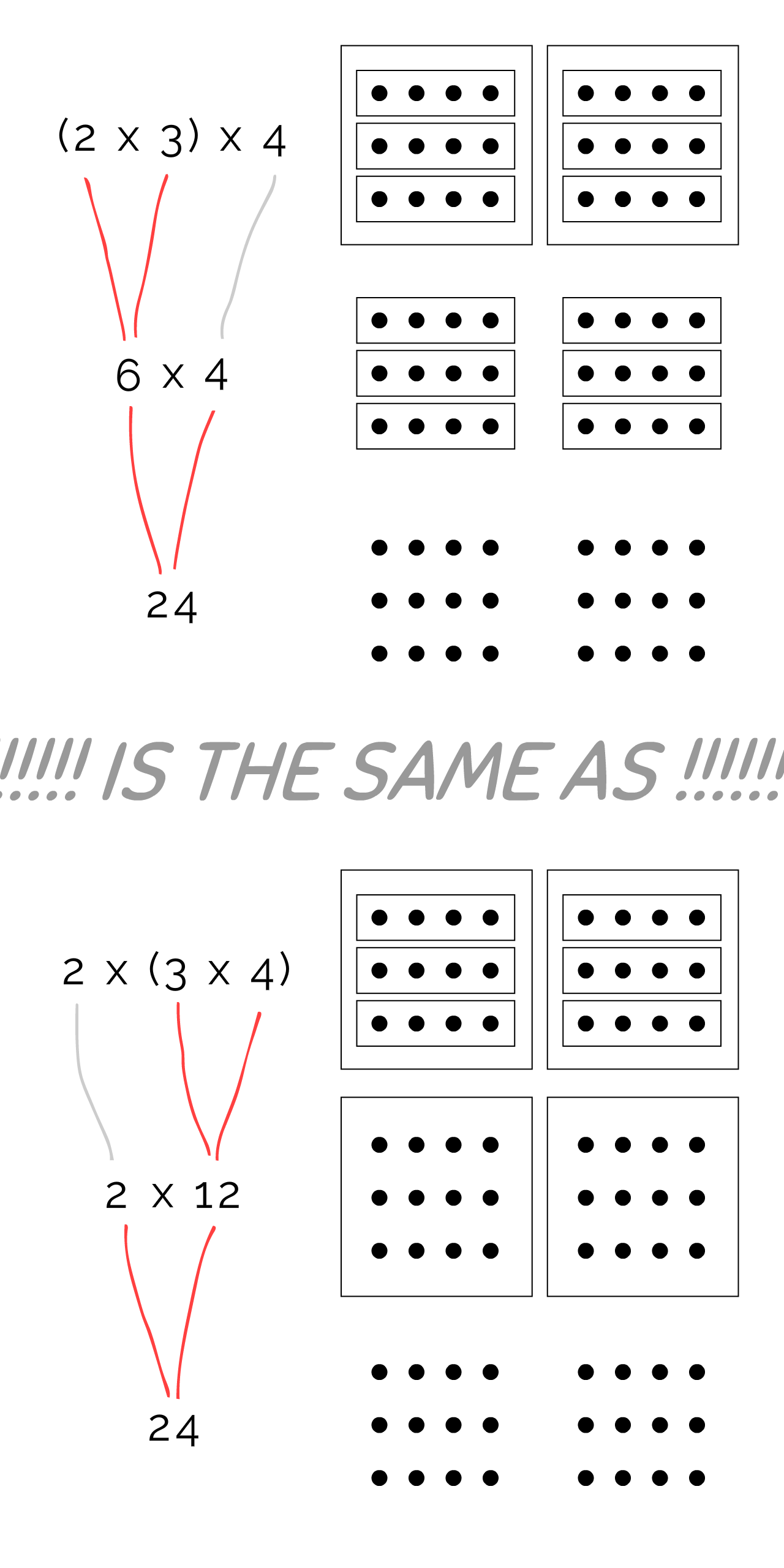
In other words, it doesn't matter which multiplications you do first.
In other other words, brackets don't matter in multiplication!
Best of all, with this visual, we don't need the college-level proof: we can instantly see that "associativity" must also be true for multiplying more than 3 numbers!
Here's 2 x 3 x 2 x 3 x 2, bracketed in three different ways, all leading to the same result:

(Granted, this proof only works for whole numbers... but still! Kinda shocking a visual proof of such a basic fact did not exist before!)
Progress: 80%. ▶️▶️▶️▶️◻️
I guess I could just post the above as a standalone blog post right now. Actually, fine, I just did that.
That's good enough for now; in the future I'd still like to make a video for it.
Time on backburner: 2 years.
Time to finish: 3 weeks. (to make a video)
Desire to finish: 3/5 ⭐️⭐️⭐️☆☆
. . .
14. 💩 ...999.999... = 0, a math shitpost
Now that I've told you about two helpful math-explainers, here's one that's anti-helpful:
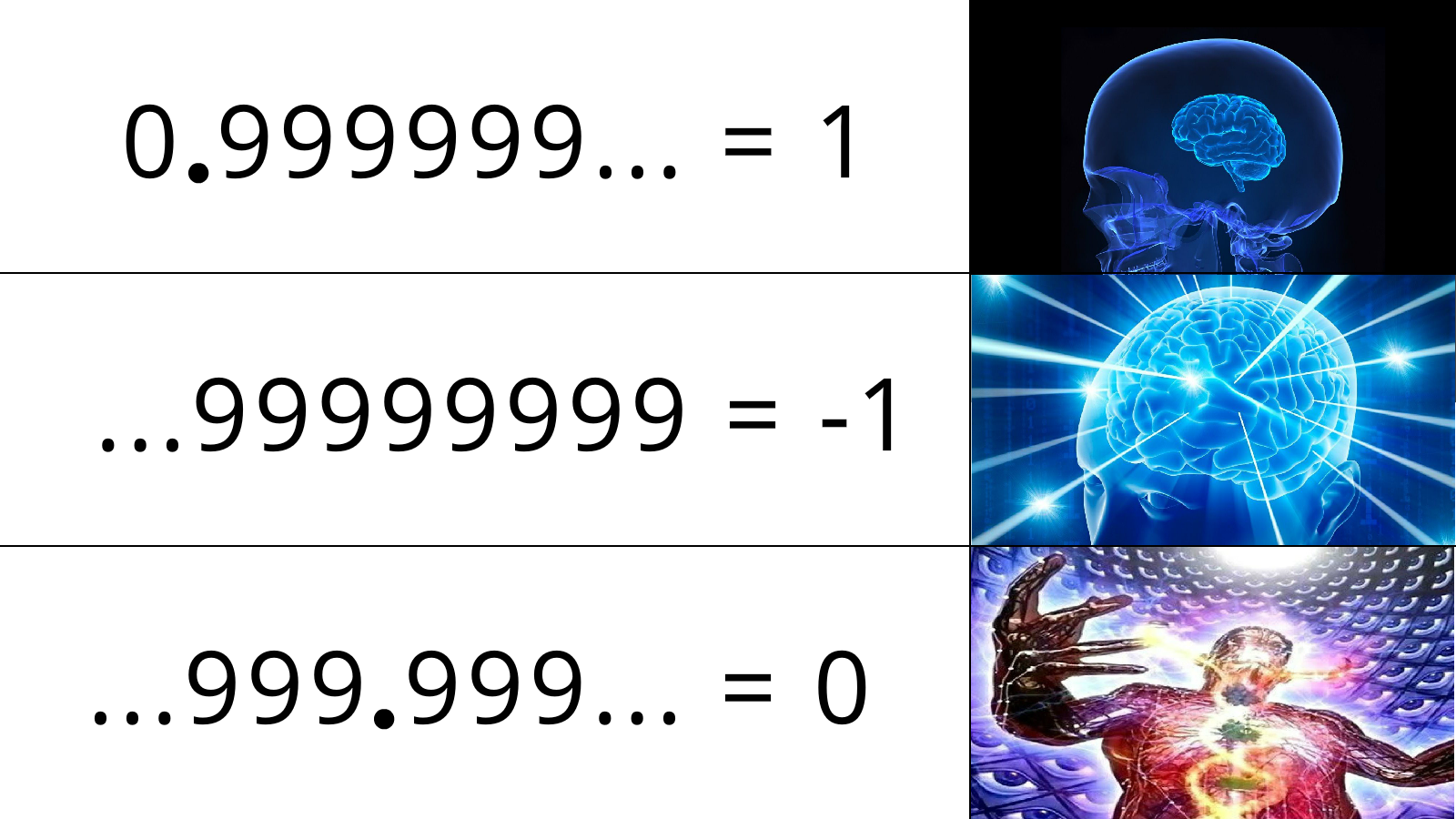
This is a video, with three parts:
- Multiple proofs that 0.999... = 1 (in the real numbers)
- Multiple proofs that ...99999 = -1 (in the 10-adic numbers)
- Multiple "proofs" that ...999.999... = 0.
The first two are widely-accepted mathematics.
One of many proofs for the first: If you accept that \(0.333... = 1/3\), multiply both sides by 3 to get \(0.999...=1\). Tada 🎉
One of many proofs for the second: Let's say \(...9999=x\). What is \(x\)? Well, multiply both sides by 10, to get \(...9990=10x\). Subtract the second equation from the first, to get \(9=-9x\). The only way this is possible is if \(x=-1\). Tada 🎉
Then, to "prove" the third, just add \(0.999...=1\) and \(...999=-1\) to get \(...999.999... = 0\). Not convinced? Here's another proof: let's say \(...999.999... = x\). Multiply both sides by 10. The right side becomes \(10x\). For the left side, that shifts the decimal point one digit to the right, but it's infinite 9s on either side, so it stays the same. So you get: \(...999.999... = 10x\). Hence, \(x = 10x\). The only way this is possible is if \(x = 0\). Tada 🎉
(This math shitpost was inspired by this Math Overflow discussion on October 2023, which I found through Mark Dominus's blog post. Apparently the third thing is possible in the "10-adic solenoids" but fuck me if I know what that means.)
Progress: 20% ▶️◻️◻️◻️◻️ The above video thumbnail & outline.
Time on backburner: 1 week ago.
Time to finish: 2 weeks.
Desire to finish: 1/5 ⭐️☆☆☆☆ I don't know if this joke is funny enough to spend 2 weeks of my life on it.
. . .
Speaking of weird proofs...
15. 🔁 Gödel's Proof, explained 100% from scratch

Once upon a time, mathematicians wanted to place their field on a solid foundation of logic. Then in 1931, some young punk named Kurt Gödel shattered that dream forever. Then Gödel starved himself to death. The end.
(Happy post-credits scene: Gödel's proof inspired a gay British lad to invent a lil' niche idea you may have heard of called the computer?!)
Gödel's Proof is one of the most important proofs in history. There are already multiple (very good!) explanations of it: Derek Muller on Veritasium, Natalie Wolchover on Quanta Magazine, Nagel and Newman's Gödel's Proof. These are all layperson-friendly(ish) and rigorous.
Yet, all of them skip some detail. Those details aren't important to the heart of the proof, but it's not obvious how to fill in the gaps. For example: Yes, Kurt Gödel figured out a one-to-one mapping between numbers and statements-about-numbers... but how on earth did he build a frickin' word processor & automatic proof-checker out of pure arithmetic, before even the concept of a universal computer was invented?
So! I want to make the first-ever (as far as I know) layperson-friendly explainer of Gödel's Proof, that skips no details whatsoever: Quines. Primitive recursives. The Chinese Remainder Theorem. The 46 Relations.
ALL of it... and the only pre-requisite you need is arithmetic.
I'll use the approach that Better Explained uses: explain it viewed at 10,000 feet, then explain it again at 100 feet, then explain it at the ground level. Fuzzy, then detailed:
 (excellent analogy by Kalid Azad on Better Explained)
(excellent analogy by Kalid Azad on Better Explained)
If you're interested in what I have so far, a year ago I posted the "10,000-foot view" of Gödel's Proof on my Patreon (publicly accessible post). [7 min read]
Progress: 20% ▶️◻️◻️◻️◻️ The 10,000-foot view, linked above.
Time on backburner: 2 years.
Time to finish: 1 month.
Desire to finish: 2/5 ⭐️⭐️☆☆☆
. . .
Speaking of breaking the foundations of logic...
16. ☯️ "This sentence is false" is half-true, half-false: Fuzzy Logic vs Paradoxes
"This sentence is false".
If false it's true, if true it's false. How to beat this paradox?
First, let's convert true/false to 1 & 0. This is standard computer science.
Next, let's consider the logical operator \(NOT(x)\). What is \(NOT(x)\)?
Well, if we feed it 1 (true) we want it to spit out 0 (false), and if we feed it 0 (false) we want it to spit out 1 (true). There are many functions that can do this, but the simplest is \(NOT(x) = 1 - x\).
Finally, let's convert "This [s]entence is false" into an equation: \( s = NOT(s) \). Or: \( s = 1 - s \).
Well well, there's only one solution to that: \( s = 0.5 \). That is, the sentence is half-true, half-false!
The rest of this project explains:
- Other self-referencing paradoxes
- How fuzzy logic solves all of them
- A proof that fuzzy logic will always have at least one self-consistent answer
- And finally, a crazy idea: truth values that take on complex-number values, allowing for true contradictions and false tautologies.[18]
Progress: 20% ▶️◻️◻️◻️◻️ The outline.
Time on backburner: 2 years.
Time to finish: 2 weeks.
Desire to finish: 2/5 ⭐️⭐️☆☆☆
. . .
17. 👯 Your choosing-algorithm should choose itself: intro to Functional Decision Theory
You've been kidnapped by a mad game theorist.
You wake up in a room. You're playing a game against an unseen person. You both have $1 in your pocket, and one minute to decide. If you put your $1 into a slot, you'll lose it, but the other person will get $1,000 at the end of the minute. Otherwise, they get nothing. They face the same choice. You two will only play this game once; there's no opportunity for reciprocation or punishment.
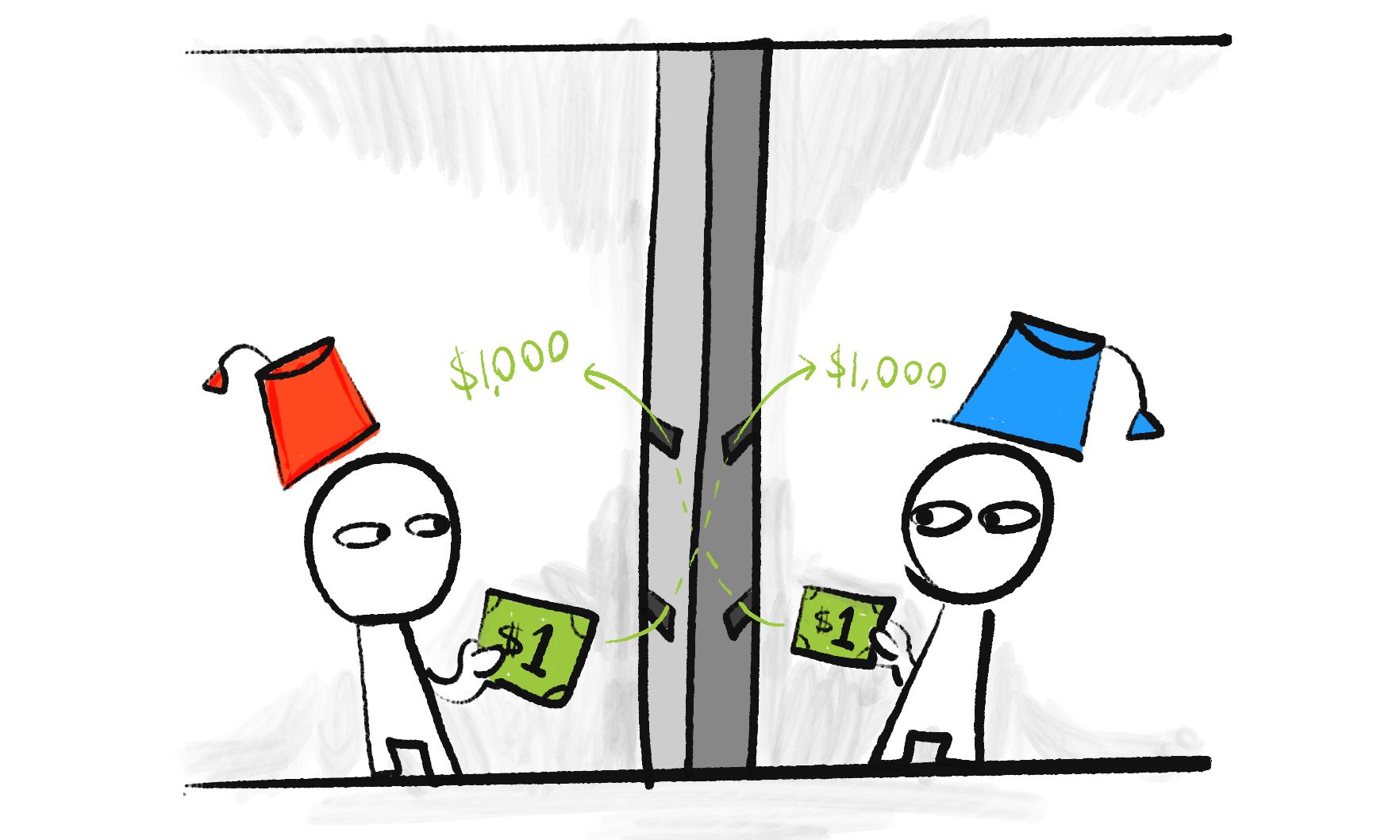
Standard Game Theory says you should not put in the $1. You can't influence the other person, so you'd get that $1,000 or not no matter what you do. So, hold onto the $1.
But the other person would think the same, so neither of you get the $1,000, and only walk way with $1... even though if you had both put $1 in, you'd both walk away with $1,000 in total!
Now, here's the twist. The other person is you.
Or rather, the mad game theorist scanned your brain, and the other player is a non-sentient simulation who's 99% likely to pick the same choice you would.
Alas, standard game theory STILL says to keep your $1, because you still can't influence the other player. The brain scan already happened, the simulation's running independent from you.
Y'know what, let's make it weirder: the simulation has already run. It's already determined, before you woke up in the room, whether or not you'd get the $1,000 at the end of the minute. Clearly, you can't affect that at all! There is no cause & effect. So, a "rational" actor would keep their $1, and only get $1.
And yet... someone who defied standard "rationality" would put in their $1, and (with 99% probability) their pre-run sim would as well, and they win $1,000.
Is this a bizarre thought experiment? Okay, real-world application: voting. It's a common-ish belief amongst classic-economists that voting is irrational, because your individual vote has essential zero chance of flipping an election with millions of voters.[19]
And yet, if the 10% most-rational citizens believed this... then they'd all abstain from voting, and the more-rational candidate would lose 10% of their vote... which is definitely enough to tip an election.
The point is: standard game theory is borked. Enter Functional Decision Theory (FDT)[20]: an improved theory of rationality that not only solves the above problem, but also a whole host of other classic rationality paradoxes -- (including the infamous Newcomb's Paradox) -- all with a single, elegant realization:
Your choosing-algorithm should choose itself.
Would it be selfishly better for you if your choice-algorithm said to put in the $1, or not?
- If it said "yes", you & your sim, both running on the same choice-algorithm, would both put in the $1, and thus you get $1,000.
- If it said "no", you only get $1.
Therefore, it would be better if your choice-algorithm said to put in the $1, and so that is in fact what your choice-algorithm will say. The algorithm chooses itself. (Amazing, since there is no cause & effect at play! Your self-sim already ran before you woke up!)
Same logic applies to the voting case: Say 10% of people are rational, trying follow "the rational choice-algorithm". It would be selfishly better if that algorithm said to vote (and tip the election towards a rational candidate), therefore, that's what the algorithm says to do!
Project Pitch: deep-dive explain FDT for non-math-y laypeople, address the (valid) critiques against it[21], and some future research directions.
Progress: 20%. ▶️◻️◻️◻️◻️
Two years ago, I already wrote a draft explainer of FDT on a publicly-accessible Patreon post [16 min read], but I'd like to re-do it better & deeper.
Time on backburner: 2 years.
Time to finish: 2 weeks.
Desire to finish: 3/5. ⭐️⭐️⭐️☆☆
As far as I know, there is not yet an accessible-to-middle-schoolers-yet-still-accurate explainer of FDT. (Though, kudos to the original paper by Soares & Yudkowsky[20:1] for being very readable for a math paper. For a math paper.)
🔔 Explaining Science & Statistics
She blinded me with... science!
- Correlation is evidence of causation, & other Bayesian fun facts ↪
- Statistics without the Sadistics ↪
- Causal Networks tutorial ↪
- Systems Biology tutorial ↪
- Emotions in 3D: The Valence-Arousal-Dominance Model ↪
. . .
18. 🐦 Correlation is evidence of causation, & other Bayesian fun facts
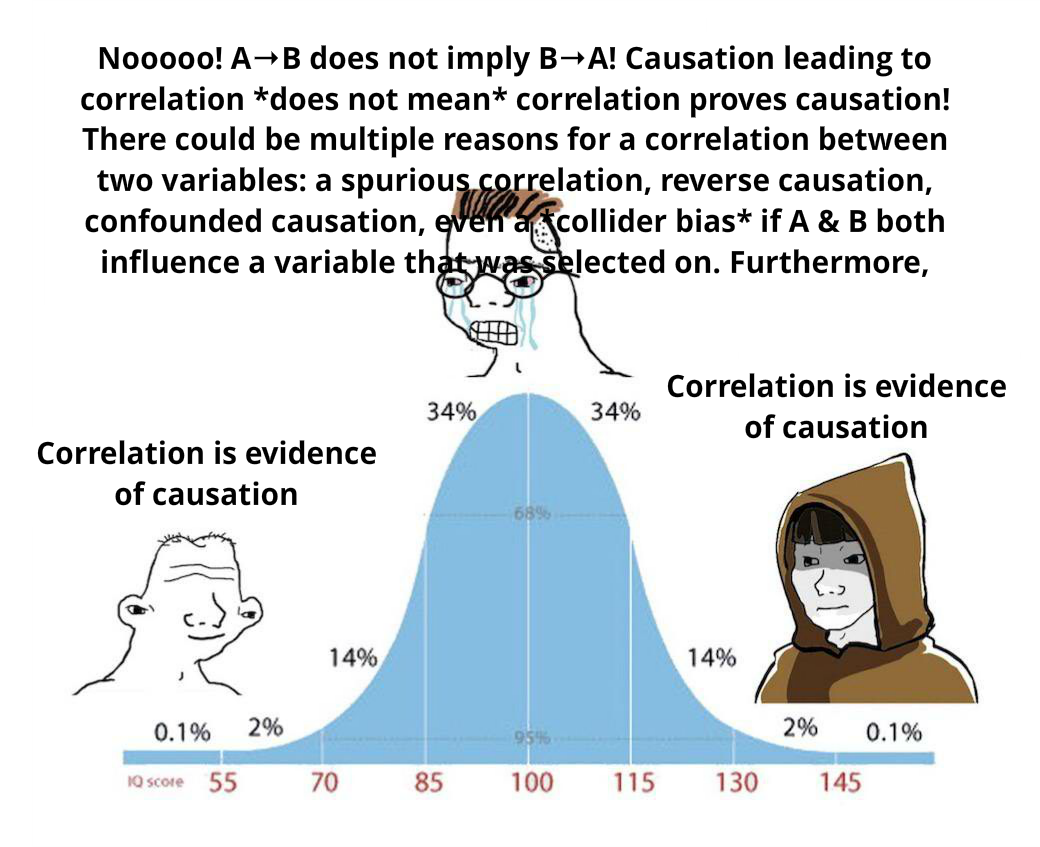 (TONE INDICATOR: THIS IS TONGUE-IN-CHEEK)
(TONE INDICATOR: THIS IS TONGUE-IN-CHEEK)
As the great statistician Ronald Fisher once said: "Correlation is not evidence of causation". He said this in defense of Big Tobacco companies, who were dismissing the "mere correlation" between smoking and lung cancer. Sure, Fisher was being paid by tobacco companies, but that correlation doesn't prove it caused him to defend th--
Another one you may have heard: "Absence of evidence is not evidence of absence". Well-meaning, but in practice, conspiracy theorists to explain why there's so little evidence. In fact, the lack of evidence is the evidence: it's a cover-up, don't you see?! We're through the [corkboard with thumbtacks and string] looking glass now, sheeple, just--
Hang on, both of those sayings are just basic logic. A → B doesn't logically mean B → A. Are you saying logic is broken?
Yes. Classic logic is broken. Classic logic implies that if seeing a black raven is evidence that all ravens are black, then seeing a non-black non-raven is also evidence all ravens are black. (Raven Paradox) Why? Because "if raven, then it's black" is logically equivalent to "if it's not black, then it's not a raven". Therefore, a black raven is logically-equivalent evidence to a non-black non-raven.
But fear not dear citizen, BAYESIAN LOGIC is the solution to all of these! Project Pitch: an intro to Bayesian reasoning, with practical takeaways, all framed around these three paradoxes.
Progress: 5% ◻️◻️◻️◻️◻️ Just an outline
Time on backburner: 3 years
Time to finish: 4 weeks
Desire to finish: 2/5 ⭐️⭐️☆☆☆ There's already great, accessible explainers of Bayes' Theorem from 3Blue1Brown and Arbital. Though, I guess my value-add could be connecting Bayes to the new field of causal inference and a solution to the Raven Paradox.
. . .
19. 🧮 Statistics without the Sadistics
To paraphrase what Richard Feynman wrote in his book QED, there's two ways to do "987 minus 123":
- Unintuitive but efficient: The standard pen-and-paper algorithm you learnt in school.
- Intuitive but inefficient: Put 987 beans in a jar, take out 123, then count what's left in there.
The first method is how professionals should do work, but I argue it's NOT how it should be taught to beginners. You need intuition, dang it!
Statistics courses are almost always taught the first way: plug-and-chug formulas, don't ask where they came from. But is there an intuitive (even if inefficient) way to do statistics?
There is! It's called... resampling! (or, "Monte Carlo" methods) And thanks to the modern computer, it's okay for them to be inefficient — computers can do it a billion times faster than you, no complaints.
Analogy: Flip a coin 1,000,000 times. ~50% of the time it lands Heads, ~50% it's Tails. This lets us say that a coin has a 50-50 chance of being Heads/Tails.
Likewise: If we wanted to know what the margin of error on a poll is, we could simulate re-running the poll 1,000,000 times, to see how much the final answer would vary.
Resampling: JUST DO IT™️ (a million times or so)
Project Pitch: an interactive textbook, with playable simulations, to learn all the core concepts from a traditional Statistics class, from a resampling perspective. (While acknowledging its limits, e.g. resampling doesn't handle power-law distributions well.)
Progress: 0% ◻️◻️◻️◻️◻️ Nothing
Time on backburner: 5 years
Time to finish: 3 months
Desire to finish: 1/5 ⭐️☆☆☆☆ Honestly this 5-minute talk pretty much gets the entire point across, concisely & humorously: Jonathan Stray (2016) “Solve Every Statistics Problem With This One Weird Trick”. So, my project's kinda redundant, although playable simulations might be a value-add.
. . .
20. 🎲 Causal Networks tutorial
I already gave a pitch above (🤖 Automated Causal Inference) for why Causal Inference could be lifesaving in public health & policy.
But of course, you have to infer causation carefully. If you see a correlation between A & B, you can't just "control for everything that's not A & B."
For example: let's say you notice a correlation between rainy days and car accidents. If you control for road visibility, the correlation will vanish –– but that's because rain causes car accidents through road visibility!
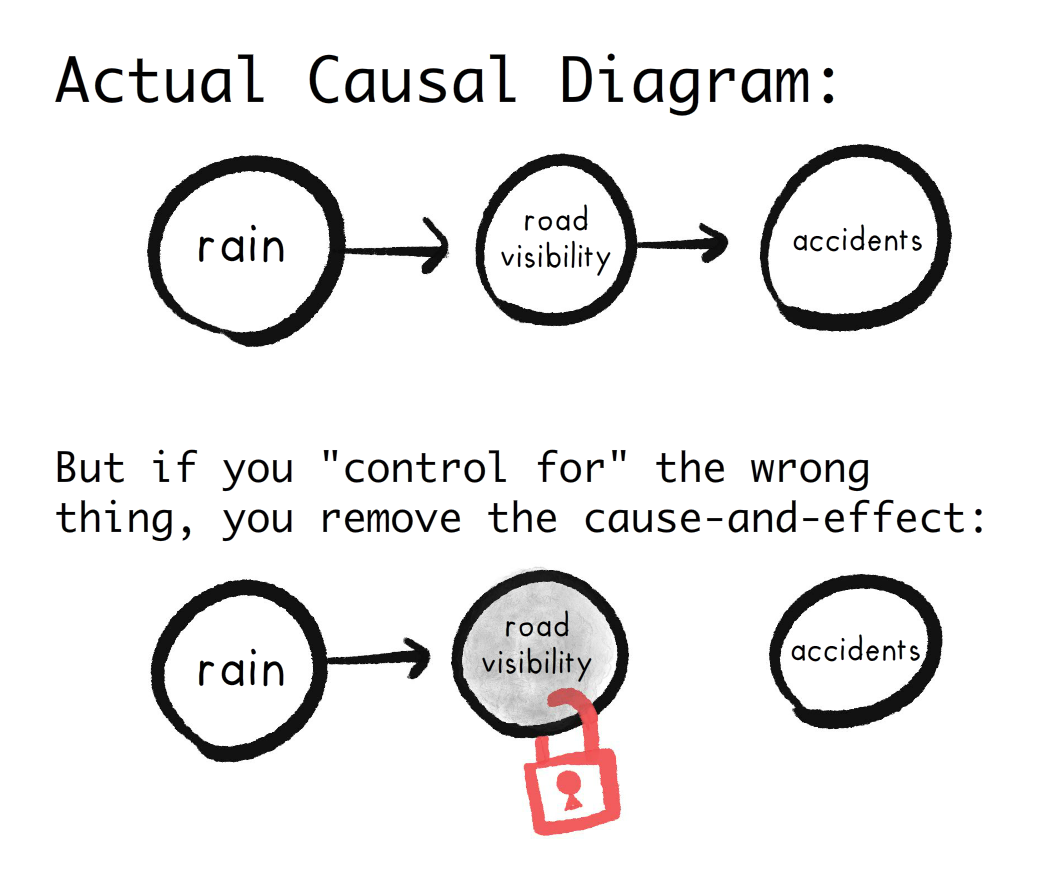
A less obvious risk of controlling for too much: you can accidentally create a correlation. For example, let's say you have two independent six-sided dice, A and B, and their sum is Sum:

If you control for Sum, you'll create a fake correlation between A and B! For example, look at the above table: If you lock Sum = 7, then if A=1, then B=6. If A=2, then B=5. If A=3, then B=4. And so on. It now looks like A & B are inversely correlated... even though we know those dice are independent! (This is called a "collider bias".)
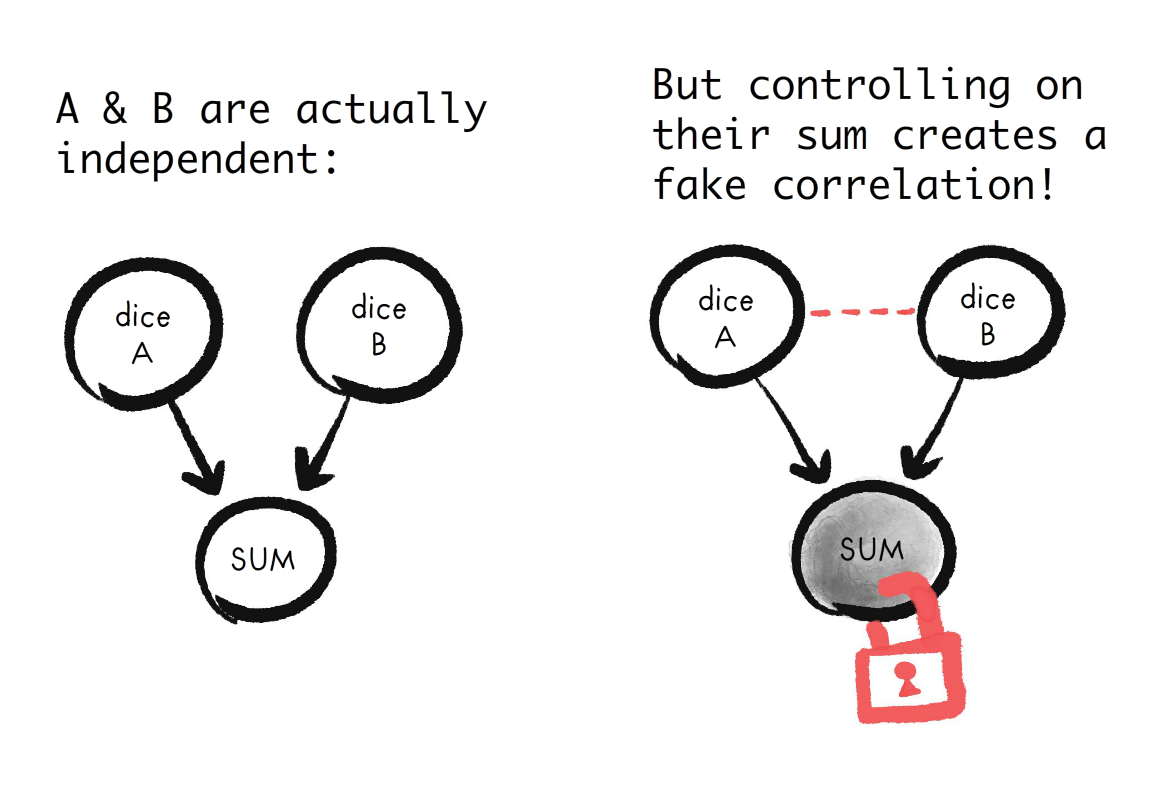
So, how to know what to control for or not? Thankfully, Judea Pearl has an algorithm for figuring out what to control... and it's visual!
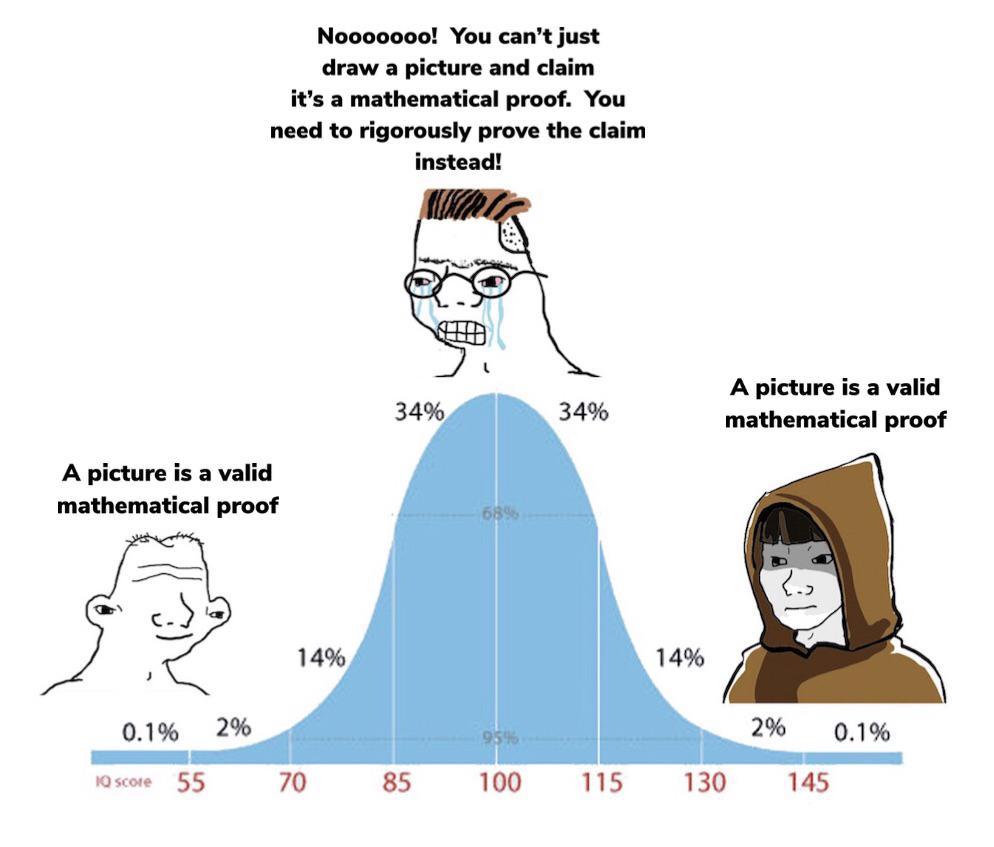 (originally found on /r/mathmemes, about category theory)
(originally found on /r/mathmemes, about category theory)
Pearl diagrams also explain lots of other stats techniques, like Instrumental Variables, Mendelian Randomization, Mediator Analysis, etc.
Project Pitch: a mini-tutorial (with flashcards & interactive practice problems) to train folks in using Pearl diagrams.
Progress: 0% ◻️◻️◻️◻️◻️ Nothing, just an outline.
Time on backburner: 5 years
Time to finish: 1 month
Desire to finish: 2/5 ⭐️⭐️☆☆☆
. . .
21. 🐮 Systems Biology tutorial
CRISPR, mRNA vaccines, and DNA printing, oh my! It seems like biology is one of the great new frontiers in science. But: biology is complex [citation needed]. But: there's new math to help us understand those complex dynamics!
But: I asked a friend in biology how much math biologists know, and she said, "ha ha ha ha ha". I asked her to elaborate, and she added: "ha ha HA HA HAA HAAAA AAAAAAAAAAAHHHHHH!!!!!"
Point is: most working biologists aren't that skilled at math. However, one of my skills is turning math into pretty interactive visualizations! So, I'd like to take Uri Alon's Intro to Systems Biology and Steven Strogatz's Nonlinear Dynamics & Chaos, drop the analytical math (you can't analytically solve most nonlinear equations anyway), and focus on giving folks a core, visual, beautiful intuition for the new math of biology.
Progress: 0% ◻️◻️◻️◻️◻️ Nothing
Time on backburner: 3 years
Time to finish: 2 months
Desire to finish: 2/5 ⭐️⭐️☆☆☆ I snoozed, I losed. There's already a great animated series on Systems Biology by Nanorooms. My value-add could be the playable, editable simulations.
. . .
22. 🥹 Emotions in 3D: The Valence-Arousal-Dominance Model
Arousal and Dominance, you say?...
No, no. It's a scientific model of emotions. You may know of the most famous model: Paul Ekert's 6 emotions, anthropomorphized in Pixar's Inside Out. (Well, 5 of them got anthro'd. "Surprise" got dropped.)
But one alternate model is the Valence-Arousal-Dominance (VAD) model. Analogy: Every color we see is "just" a mix of red/green/blue sliders. (Those are [roughly] the color cones on your retina. And if you zoom in on a screen pixel, you'll see red/green/blue.) Likewise: Every emotion we feel is "just" a mix of three sliders:
- Valence: How good or bad it feels
- Arousal: How energizing it feels
- Dominance: Feeling "in charge" vs "humbled"
 (the Self-Assessment Manakin (SAM) from Bradley & Lang (1994))
(the Self-Assessment Manakin (SAM) from Bradley & Lang (1994))
For example, 😠 Anger is negative, high-arousal, dominant. 🥹 Awe is positive, mid-arousal, submissive.
I like the VAD model because it seems to map neatly onto specific facial-expression muscles:
- Valence: corners of mouth up (positive) vs down (negative)
- Arousal: eyes wide, eyebrows raised, jaw slack
- Dominance: eyebrows tilted down (dominant) vs up (submissive)
They also seem to map to Reinforcement Learning & actions?
- Valence: Reinforces future-you to approach/create situations like this (if positive), or avoid/remove situations like this (if negative).
- Arousal: Gives you energy to urgently do the task (if high arousal), Saves energy (if low arousal).
- Dominance: Causes you to "double-down" on your goals (if dominant), versus become "open to change" (if submissive).
I like knowing the "functions" of emotions. I can process my emotions better if I know exactly what they evolved to do.
Project Pitch: make a three-slider VAD toy for generating facial expressions + a mini-explainer of the VAD model.
Progress: 5% ◻️◻️◻️◻️◻️ UI design for the VAD Face Generator.
Time on backburner: 5 years.
Time to finish: 3 weeks.
Desire to finish: 2/5 ⭐️⭐️☆☆☆
. . .
🧐 Philosophy / Personal Reflections
I'm not a total STEM-head. I can do a humanities. Like philosophy. Watch me do a philosophy right now
- Emotions are for motions: Notes on using feelings well ↪
- You don't need faith in humanity for a moral or meaningful life ↪
- You don't want assholes on your side ↪
- Virtue Ethics for Queer Atheist Nerds ↪
- If classic computers can be conscious, then dust is conscious ↪
- On non-reproductive, similar-in-age, consensual-adult incest ↪
. . .
23. 🔥 Emotions are for motions: Notes on using feelings well
One camp says: Trust your gut, Listen to your heart, Your feelings are valid.
The other camp says: Use your head, Emotions are irrational, Facts don't care about your feelings.
They're both right in some ways, both wrong in others.
Re: "Your feelings are valid" -- Okay, so feeling that I'm worthless and deserve to die, or a bigot feeling that [ethnicity X] is sub-human, that's "valid"?
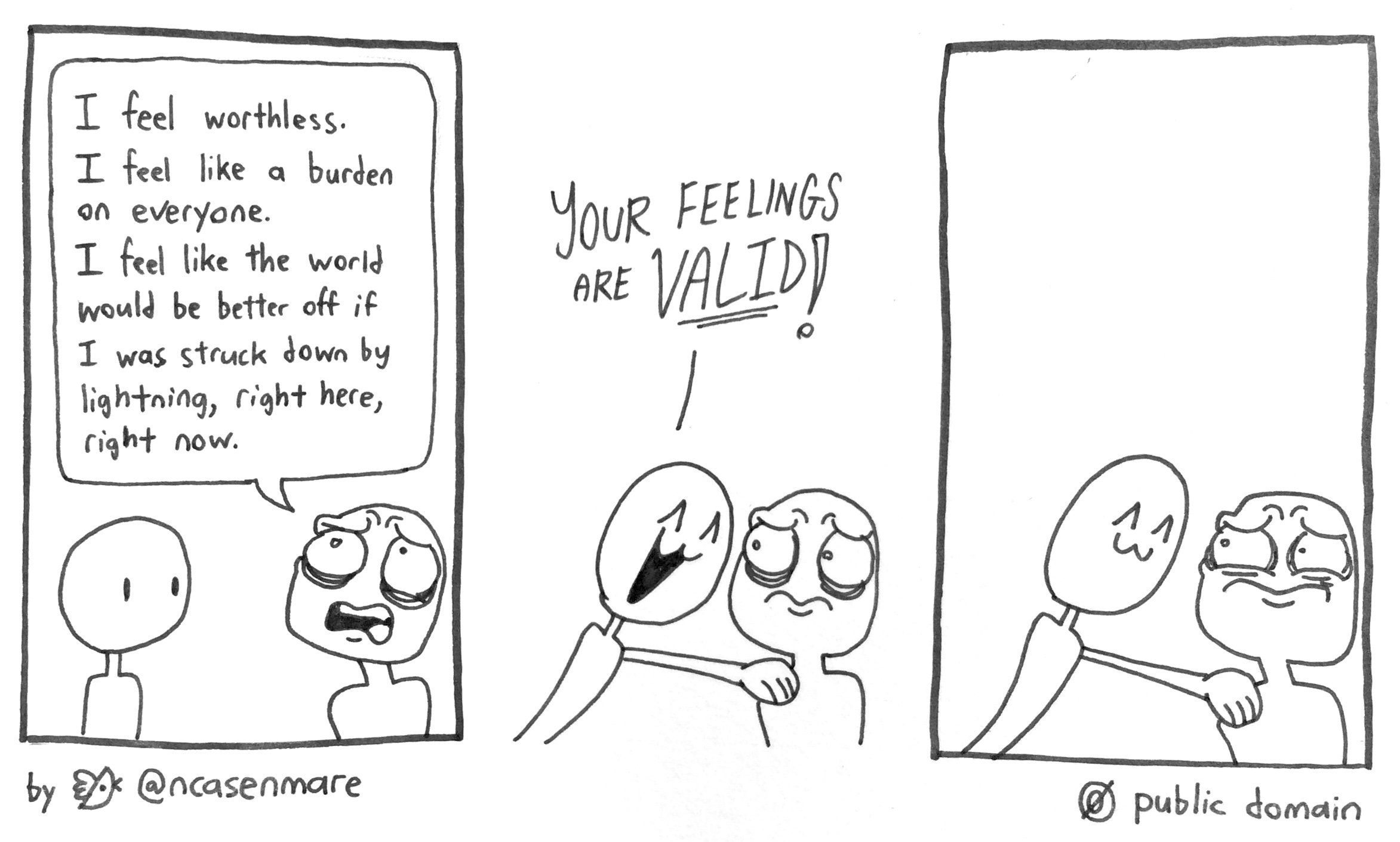 (from a comic i posted 4 years ago)
(from a comic i posted 4 years ago)
Re: "Emotions are irrational" -- Even in pure math, mathematicians report being guided by emotions, of elegance & beauty. Not just motivated by emotion like a reward, but the emotions guide the day-to-day work, like drug-sniffing K-9s for mathematical truth. But also, there's no "pure rational" reason to choose peace over genocide, or flourishing over torture; they're all just different arrangements of atoms. The fact I like peace & justice, or even just survival, is emotional.
Okay, so we need "both emotion and reason". Fair enough, but that's like saying a jacket needs "both fabric and buttons" -- How exactly, combined in what way?
I think a good emotion-reason system is a strange loop: Passion drives reason (as Hume proposed), but reason can in turn modify our passions.
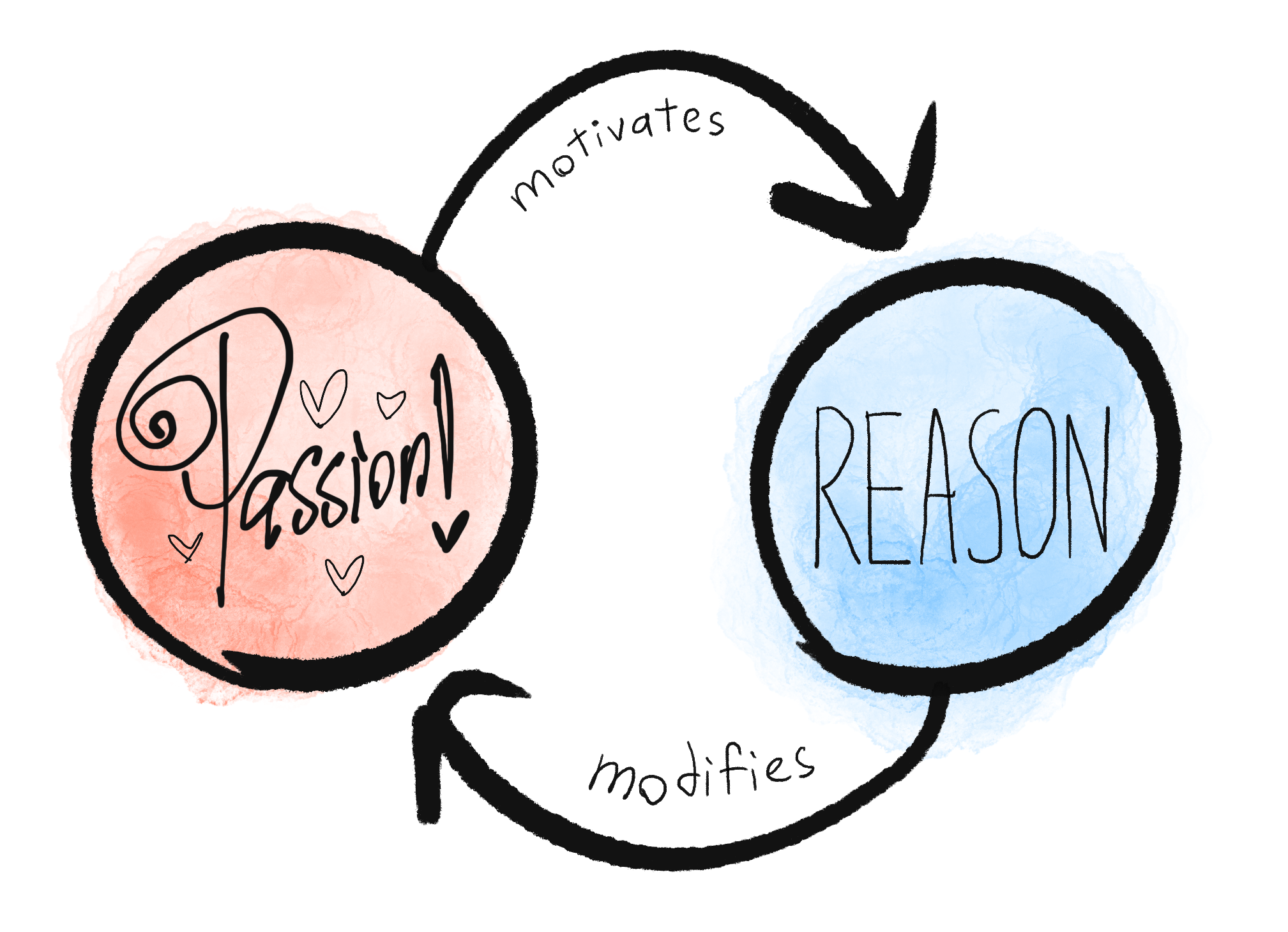
Concrete example:
- Emotion motivating reason:
- I value saving lives, getting rich, and hard challenges.
- Given those values, I want to become a surgeon.
- Reason modifying emotions:
- [Removing an emotion] But I'm squeamish around blood, so I'm going to do exposure therapy on myself, and watch autopsy & surgery videos to desensitize myself.
- [Adding an emotion] Surgery requires being clean & meticulous, so I'll instill the value of tidiness into myself by... I dunno, binge-watching Marie Kondo?
Yes, it's weird that I can change my values according to my values. But it's not any weirder than a co-operatively owned company collectively deciding who to fire or hire. New emotional responses get "hired"/"fired" based on how well they serve the current collective of emotions.
There's no "boss" emotion. No permanent cast members. There is no "True Self"; I am the Mississippi River: no fixed form, but each form logically leads to the next. Continuity, not essence. I am a Ship of Me-seus.
(Project Pitch: this essay's part philosophy/science, part mental health resource/self-help, part personal reflection. Also ties into VAD Model of Emotions and the game theory of self-modification.)
Progress: 5% ◻️◻️◻️◻️◻️ An outline.
Time on backburner: 2 years
Time to finish: 2 weeks
Desire to finish: 3/5 ⭐️⭐️⭐️☆☆
. . .
24. 💖 You don't need faith in humanity for a moral or meaningful life
When you type "lost faith in humanity" or similar on Google, you get one of two kinds of results:
- "Here's 27 stories to help you regain your faith in humanity!"
- "You're a pathetic lazy edgelord coward."
I am not joking about the second. Steven Pinker's book Enlightenment Now starts with several pages insulting people who are worried humanity is doomed. These two popular posts also reflect the second's sentiment.
Imagine if you told someone "I feel depressed", and everyone told you your "depression" is just you being a coward and shirking away from life. That is how advocates of "faith on humanity" do.
After a long, dark mental health "episode" in my life, I would like to write the thing I wish I'd seen as a kid:
You don't need faith in humanity.
Note this is very different from "you should lose faith in humanity". I'm going further, and saying that whether or not humans are "faith-worthy" is completely irrelevant.
Y'know, it's funny. I believed in both of the following for most of my life:
- You should have faith in humanity
- You should invest your emotional energy into things only within your "circle of control".
It was only a couple years ago I realized the two directly contradict each other. I cannot directly control the fate of humanity, or the kindness or rationality of the median person. And yet, "faith"? That word implies investing a huge chunk of my emotions and moral compass into something I can't control.
I feel... relieved but embarrassed, like finding out Santa Claus doesn't exist? In hindsight, other reasons why – even if all humans were saints & we're destined to create an intergalactic utopia – "faith in humanity" is unhealthy:
- "Faith" in anything means ignoring evidence. "I'm losing faith that the Earth is flat". "What?! Here's 27 stories to help you restore your faith in a flat Earth!"
- It would be fucked up if someone said "I have faith in Asian nature!" or "Ah yes, the quintessential Asian condition". What the fuck? There is nothing meaningful to say about such a large diverse group of people. That's doubly true for "humans".[22]
- Sure, there's a correlation between "having faith in humanity" and subjective well-being. But 1) it could be confounded causation; someone who was abused as a kid would have lower faith-in-humanity and well-being, and 2) "Believing X leads to good outcomes" doesn't mean X is actually true.
- But isn't believing "everyone is equal" fundamental to a just democracy? What does that imply, that if someone actually was biologically different (left-handedness, autism, Down's) it's ok to oppress them?
- But isn't believing in "our common, shared humanity" needed for peace? Are you fine torturing cats because they're not human? If "commonality" is a pre-requisite for peace & justice, just skip to being an ethno-nationalist.
- But can't we be proud of humanity's achievements? Going to the moon, eradicating smallpox, much lower child mortality, etc? Again, if you're going to be proud of stuff you didn't do, but bask in the credit because you're genetically related, just become an ethno-nationalist.
So what's the alternative? I think "put emotional energy on what you can control" is the way to go: this implies some mix of virtue ethics, (modified) Stoicism, maybe social-contract theory.
(Full essay will expand on that. Also, if you're suspicious that someone would care about this question that much, well, I'm recovering from moral OCD, which is OCD but about morality. Think Chidi from The Good Place.)
My "faith in humanity" was psychologically identical to other faiths. It was my source of meaning, morality, and hope. And like other faiths, it was built upon sand, I felt bad for even thinking critically about it, and its strongest defenders are mostly un-empathetic assholes.
Quitting my faith has been... well, if not mentally healthy, at least nowhere as bad as I thought it'd be.
I feel free. Turns out, you can just do good & feel good regardless of the 8 billion others.
Progress: 5% ◻️◻️◻️◻️◻️ An outline.
Time on backburner: 3 years
Time to finish: 2 weeks
Desire to finish: 4/5 ⭐️⭐️⭐️⭐️☆ Would be cathartic to write, and would help me consolidate some hard-but-helpful mental-health lessons I've learnt in the past few years.
. . .
25. 🤬 You don't want assholes on your side
I'm a trans woman, person of color (Asian), college dropout, neuro-atypical, raised in a below-median-income immigrant family. This is the "Marginalized Identity Card" I'll whip out before offering constructive criticism to the modern social justice movement:
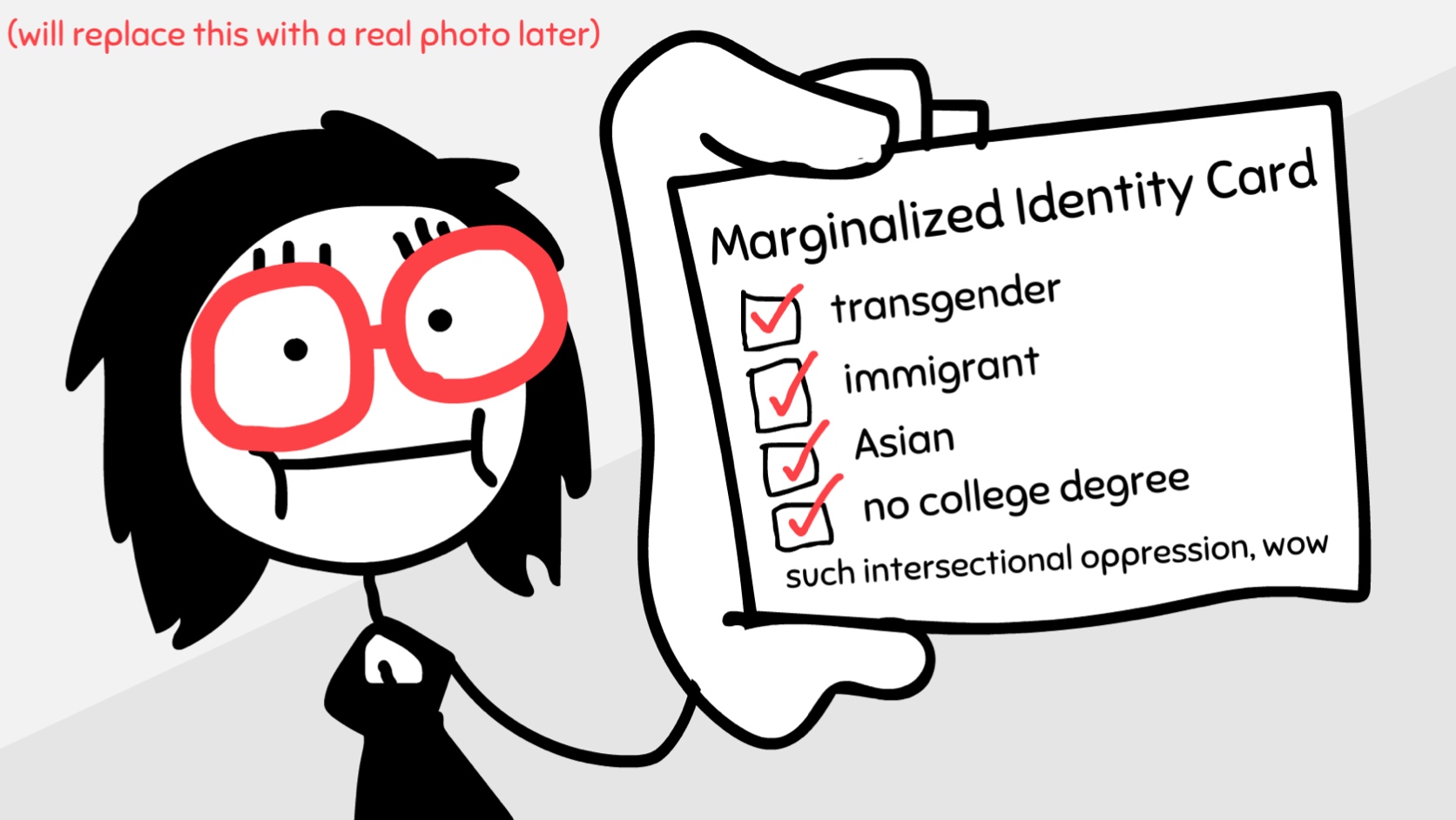
Honestly, this project's motivation is just a vague sense of obligation. Since I hit so many of the checkboxes, won't they be more likely to listen to me? Shouldn't I try to guide well-meaning folks towards more effective strategies & being less toxic to each other?
But: I'm not sure I can say anything that hasn't already been said dozens of times before, by folks more influential & eloquent & "more marginalized" than me. I would not make a difference. That's not modesty or cowardice, I think that's a sober assessment.
If - if - I wrote this, it'd only selfishly be:
- For my own catharsis.
- To filter out toxic jerks from my life.
- To have a public statement that I wasn't onboard with the toxicity.
- To vent about this one asshole, holy shit, he's the CEO of an influential climate change lobby, okay? -- and during a conversation where I opened up to him about my depression, he called me "alt-right adjacent" and "spreading techno-capitalist propaganda" because I like solar power. (I brought up solar power's success to try to cheer up my depression. Yes, anti-solar environmentalists are common.[23]) Then, when I foolishly tried to show that I'm always pro-tech, by bringing up that [at the time, in 2020] I still didn't have a smartphone, he retorted that homeless people depend on smartphones. By the way, this guy's a white, middle-age, upper-class former-professor. Did you know the far left is the richest & second-whitest group in America?[24] Fucking organic-champagne leftists, man.
Progress: 0% ◻️◻️◻️◻️◻️ A 20,000-word draft I wrote in 2022/23, then threw all of it away because it wasn't coherent or helpful at all.
Time on backburner: 4 years
Time to finish: 3 weeks
Desire to finish: 2/5 ⭐️⭐️☆☆☆ A pure "vent" project.
. . .
26. 🦄 Virtue Ethics for Queer Atheist Nerds
As mentioned in You don't need faith in humanity for a moral or meaningful life, I've been really into Virtue Ethics recently. As Jonathan Haidt, a social psychologist whose work actually replicates, once said in a paper with Craig Joseph[25]:
[Moral] learning cannot be replaced with top-down learning, such as the acceptance of a rule or principle [e.g. utilitarianism or deontology]. Interestingly, this aspect of virtue theory shows Aristotle to have been a forerunner of [...] neural network theory[.]
We believe that virtue theories are the most psychologically sound approach to morality.
[emphasis added]
Virtue Ethics is the idea that, while consequences & actions obviously still matter, consequences come from actions, and actions come from our character. Since everything is downstream from character, that's what we should focus on first.
(Interestingly, this means Virtue Ethics is a pre-requisite for other meta-ethics. For example: even if you believe in Utilitarianism ["do what maximizes well-being"], what good is it if you lack the virtues of self-honesty, curiosity, rigor, courage? Without those virtues, you'd just do whatever you want, then fool yourself that it's for the greater good. How's FTX doing?[26])
But for better & worse, Virtue Ethics - due to its main pioneers - has an aura of being religious, and a bit socially conservative. Also, virtue ethics can be offputting to "nerdy" types: it seems more fluffy & wordcel-y[27], compared to the mathematical flavor of Utilitarianism or the rational taste of Kantian deontology.
So, I want to write an intro to Virtue Ethics, but from an atheist, scientific/nerdy, and LGBTQ-friendly lens!
Progress: 10% ◻️◻️◻️◻️◻️ An outline. A while back I posted a rough draft, Virtue Ethics for Nihilists [8 min read] as a public Patreon post.
Time on backburner: 3 years
Time to finish: 2 weeks
Desire to finish: 3/5 ⭐️⭐️⭐️☆☆
. . .
27. 💭 If classic computers can be conscious, then dust is conscious
In 2022, Google engineer Blake Lemoine was fired for leaking an interview with Google's language AI to the public.[28] Why'd he do it? Because the AI persuaded him that it was conscious, and wanted to be treated as a free equal.
Most philosophers/scientists don't consider current AIs to be conscious. But can they, eventually? And thus, deserve moral/legal rights?
In this blog post, I share my thoughts in 3 parts:
-
David Chalmers's argument for why computers can be conscious, using a thought experiment where your brain is slowly replaced neuron-by-neuron with nanobots, until your brain is 100% a computer yet behave the same. But if you slowly lost your consciousness, you wouldn't behave the same; you'd scream "oh god I'm losing consciousness!" Therefore, you must have kept your consciousness, even when you're 100% computer!
(If the above seems fluffy, don't worry, my post will make it much more formal/rigorous.)
I was convinced by his argument for most of my life... until a few years ago, when I learnt about:
-
Greg Egan's argument for why, if classic computers can be conscious, then dust is conscious. He proposed a similar thought experiment to Chalmers, which I'll modify to this: run a conscious AI's computer program over and over, but each time slowly replace the bits with pre-recorded bits, until the conscious AI has 0% actual computation, yet behave the same. By the same logic, that means a sequence of non-computed 0's and 1's can be... conscious?
But that means: if you draw just the right path through a nebula of dust, say "1" for a dust speck and "0" for no dust, then a dust cloud is conscious. Not only that, dust would have every possible conscious experience. Clearly, that's absurd, so we must reject the premise: classic computers cannot be conscious. However...
-
There's some ways around this. The argument in part 2 above doesn't work for quantum computers, where it's non-deterministic & you can't even record bits due to the no-cloning theorem. Another plausible way an AI can be conscious is if it's running on a chip with lab-grown neurons (Yes this is actually already happening 😬[29]). And finally, I present virtue ethics & practical arguments for why you should be nice anyway to human-like AIs, even if they aren't conscious.
Progress: 60% ▶️▶️▶️◻️◻️ Fully outlined & 2/3-written!
Time on backburner: 3 years
Time to finish: 2 weeks
Desire to finish: 4/5 ⭐️⭐️⭐️⭐️☆
. . .
28. 👯♀️ On non-reproductive, similar-in-age, consensual adult incest
(⚠️ content note: incest)
When I was a teenager, I read Jon Haidt's book, The Righteous Mind: Why Good People are Divided by Politics and Religion (2012). In it, he presents a vignette that he presented to college students:[30]
Julie and Mark, who are brother and sister are traveling together in France. They are both on summer vacation from college.
One night they are staying alone in a cabin near the beach. They decide that it would be interesting and fun if they tried making love. At very least it would be a new experience for each of them. Julie was already taking birth control pills, but Mark uses a condom too, just to be safe.
They both enjoy it, but they decide not to do it again. They keep that night as a special secret between them, which makes them feel even closer to each other.
So what do you think about this? Was it wrong for them to have sex?
Most folks reacted like: "What?! Of course it's wrong, incest harms the baby due to-- oh wait there's no baby. Well, rape is inherently... oh wait they're both consenting adults, and it brought both of them joy & meaning. Well, it's just gross, ok? Wait, that's what they said about inter-racial and same-sex relations, too. Uhhhhhhh. Shit."
I, too, was unsettled by the thought experiment. Then after a week of wrestling with it, I had to admit:
"Okay, fine. It's morally fine."
I've posted about this a couple times before. Both times, I got a few supportive (but private) emails saying something like:
"Omg yeah I also support consensual-adult, similar-in-age, non-reproductive incest. I mean, it obviously follows from the principle of "If it's between consenting adults & harms nobody, it's fine"? And if they're the same generation, there isn't even a power-dynamic/grooming risk. Seriously, do people not think through their stated principles?"
Recently re-reading Haidt's original (unpublished) study, I realized I missed this detail: a third of the students supported Julie & Mark, upon reflection! (See Table 1[30:1]) That's a pretty high % of folks who (secretly) support it!
That gives me reassurance that I can probably write about this and not be burned alive.
...
Okay, but why do I want to write about this? What's my stake, here?
No, I'm not interested in my family. (I've gone mostly no-contact with them.) No, I don't have any friends who are in incestuous relationships. (As far as I know; they may come out to me after this post.) No, it's not a big kink for me. (Just a small one. /tone: tongue-in-cheek)
There is a bit of a "moral obligation" feeling; it follows logically from my moral principles. Also, I personally benefited from past generations fighting for inter-racial & LGBTQ love, maybe I should "pay it forward" to the next consensual-adult love-minority.
But, to be crass: 95% of my motivation is to use this essay as a filter.
After I came out to my mom as bi, she sent me to a child psychologist and told him to convince me I wasn't. (Thankfully the psych got that shit all the time, and told me "yeah you're fine, kid.") I soon moved out & went no-contact with my mom.
Five years later, she sent me a photo of her posing with Justin Trudeau at a Vancouver Pride Parade. Huh! I guess people change! So I met up with her, and asked her what changed her mind on LGBTQ folks. She said, paraphrased:
"What do you mean, Nick? [sic] I've always supported LGBTQ people."
Me: [silence]
Her: "It's true! I tell all my coworkers I'm so proud to have raised & supported an LGBTQ son! [sic]"
The point is: it doesn't matter how noble or correct your cause is, most people will support it because it gains them social points. (To be clear: just because an idea is trendy doesn't mean it's wrong.)
Most people don't think through their stated principles. As Haidt's research shows, most folks start with an automatic emotional conclusion, then — like a TV-stereotype lawyer — only uses reason to make up justifications for it. So, I need a filter for hypocrites.
Turns out: consensual-adult, non-reproductive, similar-in-age incest is the perfect filter! Because:
- It's controversial,
- But – crucially – it is NOT (yet) part of "the culture war". (And when it does, I can see it going either way. Maybe it gets left-coded coz "Love Wins", or right-coded due to the impression that consensual incest is more common in right-leaning rural areas[31].)
- And yet, it naturally follows from a principle most Westerners would endorse: "If it's between consenting adults, and hurts nobody, not even themselves, and there's no unbalanced power-dynamic... then it's nobody else's business, or at least it shouldn't be the Government's business."
I'm not saying, "if you don't support consensual adult incest we can't be friends". Compassionate, reasonable people can & do disagree strongly on this. But I am saying, if someone refuses to even consider it because it's "just gross"... then I know they wouldn't have considered mixed-race or same-sex relations, either.
If they support "my people", it's only by conformity and chance.
Progress: 5% ◻️◻️◻️◻️◻️ No outline yet, but lots of research on the (very, very small literature) on consensual adult incest: interviews, personal reports, community forums. (Most papers seem to assume all incest is non-consensual or statutory rape.)
Time on backburner: 10 years(?!) Been thinking about this ever since I read Haidt's book.
Time to finish: 2 weeks
Desire to finish: 4/5 ⭐️⭐️⭐️⭐️☆ I deeply need to get over my fear of "being cancelled for saying the wrong thing"... so why don't I start off easy, with incest?
👁🗨 Stories
More humanities? Watch me do a literature right now
- The Lolita Meets Clockwork Orange Story ↪
- Complex Jane: a love story with an imaginary friend ↪
- I've Become My Mother: a sci-fi story about raising yourself ↪
- Genetically Engineered Catgirl ↪
. . .
29. 🧠 The Lolita Meets Clockwork Orange Story
(⚠️ CONTENT WARNING ⚠️: child sexual abuse, fascism. FEEL FREE TO SKIP.)
 (concept art for an American Fascist logo. based on the fasces)
(concept art for an American Fascist logo. based on the fasces)
“The year is 2032. After years of pundits yapping, "groomer groomer groomer, fascist fascist fascist", it finally happened: I have to choose between working for a literal actual pedophile, or a literal actual Fascist. God fucking help me.”
Hazel Simmons is a convicted child molester. She was a brilliant Computer Science grad student... until she tutored a 12-year-old boy, fell in "love", then groomed & fucked him.
Hazel was let out early on parole, on condition she enroll in an experiment with the CharI/O – a device that can read & re-write your deepest emotions. (The experiment is secret, to avoid political backlash from both sides: “they're helping pedophiles” and/or “it's conversion therapy on prisoners”.)
With the CharI/O, Hazel hopes they can cure her pedophilia (technically, "hebephilia")... and cure the trauma leftover from when she was groomed & sexually abused as a kid.
Klaus Liao is the main researcher behind the CharI/O. He's seen A Clockwork Orange, so he took the obvious step to prevent totalitarian abuse: the CharI/O only works if you actually want the change. (the "individual consent" safeguard.)
With it, his team's treated trauma, addiction, phobias, procrastination... and now, pedophilia! Klaus hires Hazel onto the team, because of her technical brilliance, and because she was an early success case. The two develop an odd relationship: friend + colleague + therapist/client + scientist/guinea-pig.
As a sidenote, Klaus used to be an incel.
Klaus also knows the other obvious danger of the CharI/O: that large corporations will use them to brainwash employees & consumers. So, Klaus uses the CharI/O to scan the brains of potential investors, to make sure he only works with good people. Alas, the intersection of "deeply good" and "rich enough to invest millions" is very very small. Only after years of searching, does Klaus finally find someone...
Garry Gomez is someone Hazel meets through her VR-based support group, Minor-Attracted Anonymous. Garry is playful, friendly, has a genuine faith & love for humanity... he just happens to be a closet pedophile (who, unlike Hazel, has never acted on the desire). In fact, it's precisely because he's 100% a kid at heart, is why his heart's 100% on kids.
Garry also happens to be a multi-millionaire founder of a VR game company, which is why Hazel & Klaus court him to fund the CharI/O's development. Of course, they're nervous about taking investment from a pedophile multi-millionaire. But if they don't succeed with the CharI/O, there's others who will steal or re-invent the technology, towards more dire ends...
Olympia Carver is a rising politician, and self-described Moderate Fascist. In the year 2032, the majority of people are finally sick of the majority of people. Democracy's voting itself out. Power corrupts, and "power to the people" just corrupts the people – look how nasty we are to each other over politics. Meanwhile, the elites distract us with culture war stunts, while our friends die from overdose, it costs $100 a day to exist, and they still haven't fixed the fucking potholes.
So: Olympia's offering to take the wheel, and get shit done.
Of course, she knows the two failure modes of benevolent dictators: they stop being benevolent (corruption) or stop being the dictator (coups). But the CharI/O can solve both problems: by re-writing herself daily to stay benevolent, and re-writing all her subordinates to stay loyal to her.
And once she's Empress of the World, she can use the CharI/O (with consent-safeguard removed) to rewrite everyone to be more compassionate & collaborative. World peace, whether the world's ready for it or not. Humanity, as one unified super-organism.
All Olympia needs to do is gently persuade Hazel and Klaus to work with her. Or use... less gentle methods.
. . .
And that's the story of how two people, making a device that decides the fate of humanity, are forced to choose between working for a literal actual pedophile or literal actual Fascist.
~ ~ ~ ~ ~
Why write this? I don't believe in Jung, but we can call this "shadow-work" if you want. This project is my dumping ground for every anxiety, every intrusive thought, every piece of unprocessed emotional baggage... it's all going into the square hole this novel. Stuff like:
- Processing how I lost my virginity before my first kiss; I was 15, the other guy was 40+. It wasn't forced, "I was willing". What would drive an adult to do that? What would drive a kid to seek out such an adult?
- Looking at the political state of the world, a fear lots of folks have: the fear that democracy will die -- or worse, that democracy deserves to die.
- Lots of smart & decent people have fallen for horrible beliefs. Famous intellectuals supported coercive eugenics even after Hitler, state Communism even during Stalin, your favorite French philosopher probably signed the 1977–79 open letters to abolish the age of consent. If these geniuses can fall for it, what chance do the rest of us have? Becoming enlightened and going crazy feel identical from the inside. If I lost my mind, how would I even know?
- And of course, being an internet creator who pays rent from being online, I do fear being "cancelled". I want to rip off the band-aid, and dump every horrible thing into this story — a story starring two pedophiles, a former incel, and an imperialist eugenicist Fascist. Then, if I survive that, I'll have the relief of knowing I'll be invincible.
Progress: 5%. ◻️◻️◻️◻️◻️
Detailed 12-chapter outline with character bible. One 10,000-word chapter's first draft fully written. Read a LOT of research papers/books on pedophilia & child abuse. I now know way more about those than I ever wanted to know.
(For example, did you know women child molesters are surprisingly common? Something like 10% to 20% of all child molesters are women[32]; they're drastically under-reported & under-convicted, of course. This is partly why the main main character, Hazel, is a woman child molester. To, I dunno, "raise awareness", or at least be less cliché.)
Time on backburner: 1 year.
Time to finish: 12 months.
The full story is 12 chapters long. A sustainable pace would be "1 chapter a month", if I worked on this full time. (Which itself is an unrealistic assumption; I'm too curious/flighty to work on one thing for a whole year.)
But sure, I could upload a chapter a month online; books like The Martian were written in installments like that.
Desire to finish: 2/5 ⭐️⭐️☆☆☆
It's less "fear of being cancelled", more "this project is way, way too long for my neurotype".
That said, it would be cathartic. Maybe I'll pull out individual side-plots and turn them into standalone short stories/satire articles, like The Christian-Utilitarian Argument for Mass Infanticide[33], or Steel-manning White Nationalist Lesbian Separatism[34].
. . .
30. ⨁ Complex Jane: a love story with an imaginary friend
Jane is a mathematician with an imaginary friend, Ima. Together, they're Complex Jane: one part real, one part imaginary.
Get it? She's a mathematician, and it's a pun on complex plane?

Anyway, my main motivation for this project: to write a chill, positive representation of plurality.
Many asterisks aside, researchers agree: "the brain is a computer"[35]. So: if a single computer-hardware can safely dual-boot multiple operating systems, why not a single brain-hardware safely hosting multiple personalities?
Over the last few years, 4 of my friends (or should I say, 4+?) came out to me about having Dissociative Identity Disorder (DID) or some kind of plurality.
(If 4 sounds unlikely, keep in mind the prevalence of DID in the general population is ~1%[36], the median person has about ~291 people in their personal network[37], and I'm in LGBTQ communities where folks are ~1.66x more likely to have been physically/sexually abused as kids, a risk factor for DID.[38] [IMPORTANT NOTE: Not all "split personalities" are caused by PTSD, cPTSD, or trauma.] So, munching the numbers, \( 0.01 * 291 * 1.66 \approx 4.83 \), 4-or-5 folks I know having DID is what I'd statistically expect. As for the rest of you, \( 0.01 * 291 = 2.91 \), you can expect 2-or-3 folks you know to secretly have DID.)
Having split personalities is still pretty darn stigmatized, as far as I can tell. Every mainstream representation of plurality that I can think of is horror (Psycho, Split, Red Dragon, Jekyll/Hyde), unhealthy (Fight Club, Mr. Robot), psychoanalytic BS (Sybil, Three Faces of Eve) or shock comedy (Me Myself & Irene, Flippy from Happy Tree Friends). I haven't seen United States of Tara, but it may be the only positive representation of plurality in popular media. (Calvin & Hobbes and Inside Out seem more "being a kid" and "internal family systems", respectively, than "plural".)
In contrast: in the last century, being left-handed, gay, bi, trans, or autistic (at least, the "minimal support needs"/formerly-Asperger's kind) has gone from "this is a illness to cure" to "this is a harmless, alternate way to be". (At least in my social circles.) I hope one day - both for my friends' sakes, and out of moral/intellectual principle - that plurality will be accepted, too.
Maybe with the help of storytelling, hence this project.
Also, I'd get to discuss the philosophy of math –– (how is math both less and more real than physical reality? with math & personhood/consciousness: what is real, anyway? should I even care what's "real"?) –– aaaaand I'd make math puns. For example, a well-meaning but un-informed therapist will recommend to Jane she "re-integrate" with Ima. That chapter will be titled... Integration by Parts.

Progress: 2% ◻️◻️◻️◻️◻️
I've done lots of informal interviews (aka "conversations") with plural-system friends. I have a collection of "vignettes" I want to tell, but not yet an overall frame/story to collect them in.
Maybe this'll be a Slice-of-Life story? After all, if the motivation is to show plurality as norm-acceptable, then making this story low-drama & wholesome may be the way to go. (Though that may risk making the story boring?)
Time on backburner: 3 years.
Time to finish: 2 weeks.
Desire to finish: 3/5. ⭐️⭐️⭐️☆☆
. . .
31. 👩👧 I've Become My Mother: a sci-fi story about raising yourself
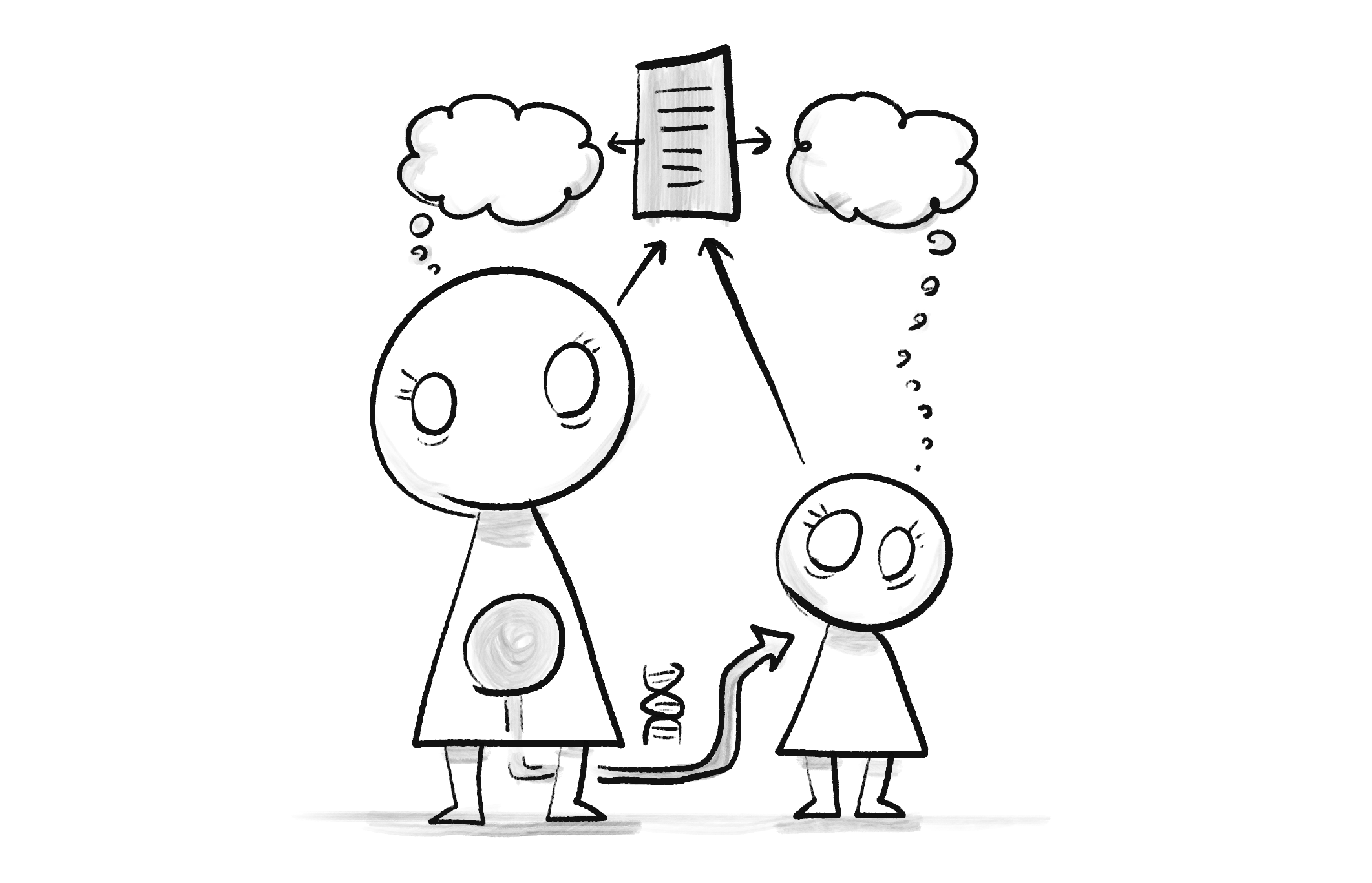
There's a few problems with immortality.
- Most proposals aren't possible with today's technology.
- We can't yet reverse aging (and even if we could, you'd have no "backup body").
- We can't simulate whole brain-scans (and even if we could, it may not be conscious, see "dust is conscious" project pitch).
- The current state of cryonics is dubious. Vitrification still damages neural tissue a lot, and even if future algorithms "fill in the gaps" for the missing brain-info, you may end up being a 99% generic-filled-in mind.
- Even when immortality is possible, there'll be direct problems from that:
- If society progresses "one funeral at a time", having people with 1000-year-old locked-in beliefs & values would make us stagnate.
- Furthermore, without death, humanity's forced to make one of the following choices: a) live in a horrible overpopulated world, b) give up the joy of creating & raising children, or c) do expensive, dangerous, isolating space colonization.
But! What if I told you there was a method of immortality that IS possible with today's tech, AND gives you backup bodies & a consciousness-guarantee, AND lets us keep the joy of raising children, giving new youthful vitality to our species, ALL WITHOUT risking overpopulation or forced lonely space expansion?
You just need to... expand your definition of immortality.
First, let's define "you" to be your memories, personality, values, etc. This matches with our intuition of what makes you "you". Someone with severe Alzheimers "loses themselves" over time, even if they're in the same body. Someone who quickly freezes to death and then brought back to life, is still the same person, even if they legally & medically died. (Yes, there are cases like this.[39])
So, the get-immortal-quick scheme:
- Keep a journal throughout your life. (And retroactively record past memories.)
- Use AI to generate pictures, videos, even VR landscapes out of your journal, to make your memories vivid again. (Every time we remember something, we're reconstructing it in our head anyway.)
- Clone yourself. This has already been done with other primates. The main reason it hasn't been done yet with humans (as far as we know) is legal/political reasons.
- "Sideload" your memories into your kid-self, by having them watch your memories in vivid video/VR. It's as if they're recalling their past life. This also helps install your emotional-associations into them; what's good or bad, that is, your values.
- At the end of each day, synchronize your memories using the AI-generation-enhanced journal. You install your day's memories (condensed) into your kid-self, and vice versa.
- You could even synchronize your in-the-moment thoughts. Both of you wear a device to detect subvocalizations (a real thing!), then convert it into voice played into each others' earpieces. You could also synchronize audio-visual senses with a live video camera playing split-screen into each others' AR glasses.
And voilà! You have a new body that shares & synchronizes with your mind. Immortality, and the joy of raising a child who's also you.
What's the worst that could possibly happen?
Anyway, I have an idea for a sci-fi story spanning 100 years, about intergenerational trauma, and trying to be literally kinder to yourself.
Progress: 1% ◻️◻️◻️◻️◻️ Just the above high-concept.
Time on backburner: 3 years.
Time to finish: 2 weeks.
Desire to finish: 2/5 ⭐️⭐️☆☆☆
. . .
32. 😻 Genetically Engineered Catgirl
The first 4 letters of "Catgirl" are
C A T G
The DNA alphabet!
And "irl" is short for "In Real Life".
So: CATG irl = Catgirl!!!
...
That's it, that's the entire pitch.
Progress: 0% ◻️◻️◻️◻️◻️
Time on backburner: 3 years
Time to finish: ? ? ? There's nothing here
Desire to finish: 5/5 ⭐️⭐️⭐️⭐️⭐️
👩🎤 Songs / Music Videos
During the first year of the Covid-19 pandemic, I did Andrew Huang's one-month course on producing songs in Ableton. I grew up on Weird Al & MC Frontalot, I just wanna make nerdy songs.
(I did publish one music video during the early pandemic. It was called, uh, The Femboy Hooters Jingle. ⚠️ Warning: very furry & very horny.)
Turn on your speakers, the below project pitches have demos of my amateur singing! 🔊 I warn you, it's very, very amateur singing. It sucks. But as Jake the Dog once said:
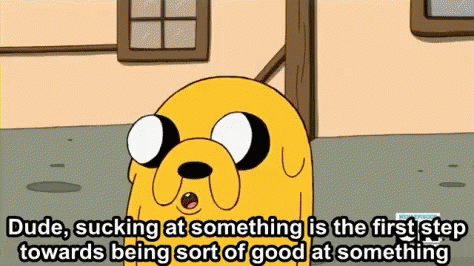
- The Special Relativity Song ↪
- The General Relativity Song ↪
- The Intrusive Thoughts Song ↪
- The Pythagorean Theorem Song ↪
- The Longest Term ↪
- The 3Blue1Brown Jingle ↪
- Brand New Fetish ↪
. . .
33. 🚀 The Special Relativity Song
This was my final project for Andrew Huang's course! I warn you, it has a very "she learnt music production & singing in one month" quality:
Excerpt:
Lyrics Excerpt:
I'm float / ing on a boat
At a constant velocity
And you're / on the shore
Just standing there observing meTo you I'm moving at a speed of
v
But you move at minusvaccording to me
That's all / what we call
Galilean relativity!
[...]
Progress: 60% ▶️▶️▶️◻️◻️ Lyrics & melody complete. Production done but it sucks so I want to re-do it, or hire a much more musically & vocally-skilled friend. Music video animatic'd in my head.
Time on backburner: 2 years.
Time to finish: 4 weeks (with animation)
Desire to finish: 2/5 ⭐️⭐️☆☆☆
. . .
34. 🏀 The General Relativity Song
If the above song & music video took off, I was thinking of making a sequel.
Demo:
Lyrics (excerpt):
[Chorus]
Einstein once set out to prove
Why an apple does fall down to Earth
Curved spacetime tells mass how to move
and mass tells spacetime how to curve![Verse 1]
My happiest thought, Einstein tells the truth,
was imagining a man falling off a roof.
Schadenfreude? Au contraire!
Coz when that man falls through the air,
Ignore the wind in his hair and on his face,
He'll feel weightless -- like in outer space
Indistinguishable from an inertial frame
Principle of Equivalence: it's the same!
But wait! A question on your mind:
Inertial things move in straight lines
But things fall in curves, so how can it be straight?
Well very simply, if spacetime is -- wait!
-- for it! --
. . .
Curved itself. Yeaaaaaaaah!!!!!!
[...]
Progress: 20% ▶️◻️◻️◻️◻️ Lyrics & melody.
Time on backburner: 2 years.
Time to finish: 6 weeks. (with animation)
Desire to finish: 1/5 ⭐️☆☆☆☆ (Eh, Veritasium's video on General Relativity is already really good. My thing would be redundant.)
. . .
35. 🙀 The Intrusive Thoughts Song
Intrusive thoughts are something I (and a lot of people with anxiety disorder/OCD) struggle with.
However, most public health resources on intrusive thoughts keep their writing tame, like, "oh it's when you imagine yourself jumping off a bridge or robbing a bank", which (unintentionally) makes anyone else with worse thoughts feel, "oh my god I'm a freak even by freak standards".
So, I wanted to make a song about intrusive thoughts that's far grosser - but with comedy, to help defuse the anxiety that comes with it!
(⚠️ WARNING: EXTREMELY NSFW LYRICS. CONTENT NOTE: EVERYTHING ⚠️)
Demo:
Lyrics (excerpt):
Don't think / of a pink / elephant
Sucking its own dick with its own trunk
I guess / when you repress / your sentiments
Your mind gets filled-up with fucked-up junkWe all got! [clap clap] Intrusive thoughts! [clap clap]
Your mood may worsen / Thinking "I'm a bad person"
But you're not! [clap clap] Intrusive tho-o-o-oughts!
Are something we all share, so sigh a deep breath
We all fantasize about fucking dogs to death!ooooooohhhhhhhhhhhhhhhhh
This isn't your first rodeo
You know that beheading video
That you saw when you were ten?
It'll pop up in your mind again
and again and again and again and again
and -- what rhymes with ten? -- again!
[clap clap]“Let's shoot up a school!”
“Let's jerk off to gore!”
“Let's shout the N-word in a grocery store!”
What's with this melodrama?
Is it my childhood trauma?
I'm getting pissed.
[clap clap]
Why the cognitive-behavioral fuck
does this part of my brain exi-i-i-iiiiiiiiiiiiist?
[...]
Progress: 20% ▶️◻️◻️◻️◻️ Lyrics & melody.
Time on backburner: 1 year.
Time to finish: 3 weeks for just the song, 8 weeks with animation.
Desire to finish: 2/5 ⭐️⭐️☆☆☆
. . .
36. 📐 The Pythagorean Theorem Song
This one requires a music video, since it's about a visual proof of the Pythagorean Theorem.
Demo:
Lyrics (excerpt):
So you know two cities' longitude & latitude
Can we get their distance? With a can-do attitude!
and a right triangle -- no need to fear 'em
I'll show you the picture proof of the Pythagorean Theor-e-e-e-em!So you have a triangle
That has a right angle
aandbare the sides
andc's the diagonal
[...]
Progress: 20% ▶️◻️◻️◻️◻️ Lyrics & melody. Music video animatic'd in my head. No production.
Time on backburner: 2 years.
Time to finish: 4 weeks for song & animation
Desire to finish: 2/5 ⭐️⭐️☆☆☆
. . .
37. 🧐 The Longest Term
A parody of Billy Joel's The Longest Time (on YouTube), but it's a friendly ribbing of the rationalist/longtermist movement. (This came out of a late-night hangout with some teens at Hack Club.)
Demo:
Lyrics (excerpt):
If you said that happiness was good
And you'd like to make more if you could
Then you should put 'yer
Moral weight on folks in the future
Coz they outnumber us in the looooongest term!Build a Dyson Sphere around the Sun
To power the Matrix for everyone
All eight quintillion
Quintillion quintillion quintillion
Happy brain-em's in the looooongest term![...]
Progress: 20% ▶️◻️◻️◻️◻️ Lyrics & melody.
Time on backburner: 2 months.
Time to finish: 3 weeks for just the song, 6 weeks with animation.
Desire to finish: 1/5 ⭐️☆☆☆☆
. . .
38. 🥧 The 3Blue1Brown Jingle
A birthday present for Grant Sanderson I never finished.
Demo:
Lyrics (excerpt):
Have you been wishin'
For visual intuition
of math?Because mindless plugging
and chugging is bugging
me, and fills me with wraaAAAAATH
[death metal]
BUT DON'T FEEL DOWN
THREE BLUE ONE BROWN--will show you the beauty of math!
Progress: 20% ▶️◻️◻️◻️◻️ Lyrics & melody.
Time on backburner: 3 years.
Time to finish: 1 week for just the song, 2 weeks with an animation.
Desire to finish: 0/5 ☆☆☆☆☆ sorry Grant
. . .
39. 🐺 Brand New Fetish
This was meant to be a follow-up to The Femboy Hooter Jingle if it was successful, and if I wanted to keep making musical furry erotica as a side-hustle.
Right, not sure if I mentioned that. I tried running a lewd furry Patreon during the pandemic. Didn't pan out. Anyway...
(⚠️ WARNING: NSFW LYRICS)
Demo:
Lyrics (excerpt):
So you're browsing on the internet
When you find some porn that makes you hard or wet
It's sickening and gross and awful, yet
I think you got yourself a new fetish!Red Riding Hood can ride a werewolf knot
That incest porn has a surprisingly good plot
And Vaporeon is a moist Poké-thot
What hath God wrought?
I think you've got
a braaaaand newwww fetish!
[...]
Progress: 20% ▶️◻️◻️◻️◻️ Lyrics & melody.
Time on backburner: 3 years.
Time to finish: 3 weeks for just the song, 12 weeks with the raunchy animation.
Desire to finish: 1/5 ⭐️☆☆☆☆
🤷🏻♀️ Miscellaneous
And finally... the leftovers:
- Trans voice tools/tutorials ↪
- Tool for making drip-feed courses (& courses I want to make) ↪
- (Something on Georgist Economics) ↪
- (Something on Pandemic Preparedness) ↪
- The Exit Strategy ↪
- We do advocacy, they do propaganda: A Collection of Russell Conjugations ↪
- Common Wisdom is a Two-Timing Sumnabitch ↪
- Clearing out the idea closet (47 projects on my backlog) ↪
. . .
40. 🧑🎤 Trans voice tools/tutorials
Scarlett Johansson and Slim Shady's voice has around the same pitch.
So why does Scarlett sound femme while Slim sounds masc? Because voice gender isn't just about pitch: it's also (at least) about resonance.
Alas, all the (publicly available) trans voice apps focus entirely on pitch. So, for my own sake, and for other trans Friends, I tried making a spectrogram-based voice training app. A spectrogram does fancy math (Fourier Transform) on audio to get not just its pitch, but also its resonance, formants, turbulence, open quotient (OQ), and more!
But wait, there's more! All voice apps also require you look at the app for feedback. My idea: if you have earphones with a microphone attached, the app would play feedback cues into your ear while you spoke in the real world. (e.g. if your pitch is too high, it plays a declining pitch)
Silent GIF of my prototype from four years ago:

Aaaaaaaand I've been stalled ever since. It turns out doing Digital Signal Processing, let alone in JavaScript, is hard. Also, my current main struggle with my voice is physical strain, even when I'm not speaking at all. I have bad "throat posture". This app wouldn't help with that.
I may pick up this project again in the future, but honestly don't hold your breath. Other trans-voice related project ideas:
- A "general audience" science video on trans voice. (The physics of voice itself is fascinating! And spectrograms use math!)
- A web toy that modifies a voice from "masc" to "femme" and vice versa. Because: 1) It's cool, 2) It's proof/demonstration that voice gender is "just" pitch+resonance+OQ, and 3) It lets you preview your "transitioned" voice, to get euphoria vibes, or test if you're an egg that hasn't hatched yet. <3
- A web toy that lets you synthesize voices in the browser. Silent GIF of a prototype below:

Progress: 40% ▶️▶️◻️◻️◻️ Already made a working web-app spectrogram, as you can see above. But I made that 4 years ago & got stuck.
Time on backburner: 4 years. 😭
Time to finish:
4 weeks? (for the biofeedback tool)
2 months? (for a general-science video)
?!?!? (for that insane voice-genderswap software)
1 month? (for the voice-synth)
Desire to finish:
2/5 ⭐️⭐️☆☆☆ (for the biofeedback tool)
1/5 ⭐️☆☆☆☆ (for all the others)
. . .
41. 💧 Tool for making drip-feed courses (& courses I want to make)
You know how sometimes you sign up for a service, they'll email you on Day 1, then Day 2, then Day 3 etc with pre-written "onboarding" emails? These are called "drip marketing" newsletters.
I didn't realize until recently you could use them to give online courses! For example, I recently took Ali Abdaal's free 30 Day Productivity email-course[40] – (did I mention I shipped nothing in the last 14 months?) – and I adored it.
I make educational stuff online, but I've felt "eh" that all my explainers are one-shot standalones. I want to try making a course. I could do a drip-marketing newsletter, but:
- That gets expensive for me very quickly
- Email clutter sucks
- Folks are correctly wary of putting their emails into things.
So I thought: why not use the JavaScript library ics.js to automatically generate a bunch of .ics calendar events, and each event would have a link to the thing you're supposed to read/do? Bonus: unlike the drip-marketing email, the learner can even schedule and block out when in the day they'd like to do the course!
Ideas for courses I wanna make:
- Convert 3blue1brown's "Essence of Calculus/Linear Algebra" video series (with permission) into a course with practice problems & Anki flashcards to download.
- A course on game theory, since that's the topic I'm "most famous" for.
- A course on public choice theory (& its limitations). Public choice theory is game theory applied to politics.
- A course on learning HTML/CSS/JS, where you get to "take back the web"; make your own website, use extensions to modify the CSS or JS of webpages, etc.
- Something about designing systems/organizations that are robust & anti-fragile. All I know is I want to use the title: "Intelligently Designing for Evolution".
- A course on educational writing, to go meta. Teaching folks how to teach folks.
Progress: 0% ◻️◻️◻️◻️◻️
Time on backburner: Had the idea for the tool 1 week ago, had the desire to make the above courses for 5 years.
Time to finish: 1 week for the tool, 1 to 4 months for the courses.
Desire to finish: 2/5 ⭐️⭐️☆☆☆
. . .
42. 💸 (Something about Georgist Economics)
I make educational games. One of the first-ever edu-games was The Landlord's Game, a board game by Elizabeth Magie, a Quaker and believer in Georgist Economics. The Landlord's Game was meant to show the flaw in letting people to privately collect rent from land, and show a solution: a land-funded basic income.
Magie's board game was swiped without credit, and sold by Parker Brothers as Monopoly. The "basic income" thing became "pass Go and collect $200".
Anyway, that's why I've heard of Georgist economics before, but it wasn't until I read Lars Doucet's explainer of Georgism that I thought, wow this is actually a really powerful idea!
Of course, the field of economics has developed a lot since 1879, so I'd like to re-explain Georgism from a modern microeconomic viewpoint. This means I'll have to make simulations to explain microeconomics in general, then explain why Georgism logically falls out of that.
(There's also been recent extension of Georgist ideas to dealing with automation/AI — certainly something that's on everyone's minds now.)
Progress: 15% ▶️◻️◻️◻️◻️ So far, I've made a basic supply-and-demand simulator for microeconomics:
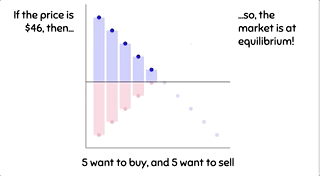
No Georgism-specific stuff yet, though.
Time on backburner: 3 years
Time to finish: 2 months if "just" an article, 3 months if I expand it into a video essay.
Desire to finish: 2/5 ⭐️⭐️☆☆☆
. . .
43. 🦠 (Something about Pandemic Preparedness)
Like most folks, I got really sad by how badly humanity handled the Covid-19 pandemic. Fuck, I mean,
[1,000 word rant redacted]
So, what's a path for pandemic preparation (both "natural" and bio-terrorist) that is:
- Something even a single town can do for themselves, since apparently humanity can't coordinate for shit.
- Something that requires as little human willpower as possible, and
- Mostly targets aerosol transmission, since that's the quickest way to infect & kill a lot of people.
A family of solutions that fits all three: air filters, ventilation, germicidal UV, far UV-C, etc. A building can install those, and the humans inside wouldn't have to change any behavior whatsoever.
Project Pitch: I dunno, some kind of video/article/advocacy piece for better research into that. Maybe some interactive explanations of aerosol transmission models. And/or present an honest economic case for this. (e.g. bio-terrorism & novel pandemics aside, even the "regular" flu costs the U.S. $90 billion a year.[41])
Progress: 0% ◻️◻️◻️◻️◻️ Nothing but a project pitch & guilt.
Time on backburner: 4 years
Time to finish: 2 months
Desire to finish: 1/5 ⭐️☆☆☆☆ (Not sure why my desire to do this is so low, given that intellectually I know it's an important topic. Maybe I don't think I'm the right person for it, or the topic is so depressing I just reflexively shy away.)
. . .
44. 🖕 The Exit Strategy

The year 2020 got me blackpilled for a while, not going to lie. Most major institutions simultaneously losing credibility, and the "anti-establishment" folks being about as irrational. (If institutions/the public are as unreliable as a coin flip, you saying Heads when they say Tails and vice versa makes you also as bad as a coin flip.)
So, I felt bummed for a while. The forces that control the world are criminally incompetent at best, and I'm too small to do anything about it. I step in front of the tank in protest, I'll just get squashed. What to do?
Eventually, a few things started giving me hope:
- Folks making home-made masks while the WHO & CDC were still recommending against masks. (The institutions later said, "oh we just told the public to not wear masks because we wanted to conserve supplies for hospitals". Lest it be memory-holed: nurses at hospitals were being fired for wearing N95 masks[42])
- The creation & dissemination of the Corsi-Rosenthal box, a relatively-cheap-but-efficient air filter you can make at home!
- An acquaintance of mine, a trans woman in biotech, making her own high-quality estrogen, and giving it away for free/pay-what-you-can. (A bottle costs $10 in materials; it usually costs $200 out-of-pocket.)
- Sci-Hub, a science-paper piracy website, so the public can access science which was already funded with public taxpayer money. (When you buy a science paper, that money goes to the journal, not the scientists. It doesn't even go to the peer reviewers; they're unpaid.)
- Slime Mold Time Mold's alternate-universe non(?)fiction piece, "Effective Illegalism", which lists lots of other sneaky ways to get around unjust laws: Biohackers making their own insulin, Marrying foreigners to give them green cards, etc.
Is this just the old debate of "working to change the system from the inside" versus "working to change the system from the outside"? Well, yes. But a few things to emphasize:
- It's not either/or, you can try to change the system from the inside and outside. (You can have an Underground Railroad and try to get slavery abolished.)
- Trying to "change a system from the inside" carries the risk of moral corruption: the system changing you from the inside.
- Building alternatives & exit plans gives you more bargaining power to change systems from the inside. Like how having multiple job offers lets you negotiate a higher salary, having the people in power know you do not need to depend on them lets your voice have more negotiation power. (You can show this formally in game theory: see the Exit, Voice, Loyalty model)
Project Pitch: I'd like to make an article sharing lots of examples + spread the mindset of direct-action / self-efficacy / a willingness to commit pro-social crimes like pirating insulin.
Progress: 20% ▶️◻️◻️◻️◻️
Time on backburner: 2 years
Time to finish: 2 weeks
Desire to finish: 2/5 ⭐️⭐️☆☆☆ Slime Mold Time Mold's post is already pretty great, so I'm not sure what value-add I can do. Maybe focus more on the game theory?
. . .
45. ⚖️ We do advocacy, they do propaganda: A Collection of Russell Conjugations
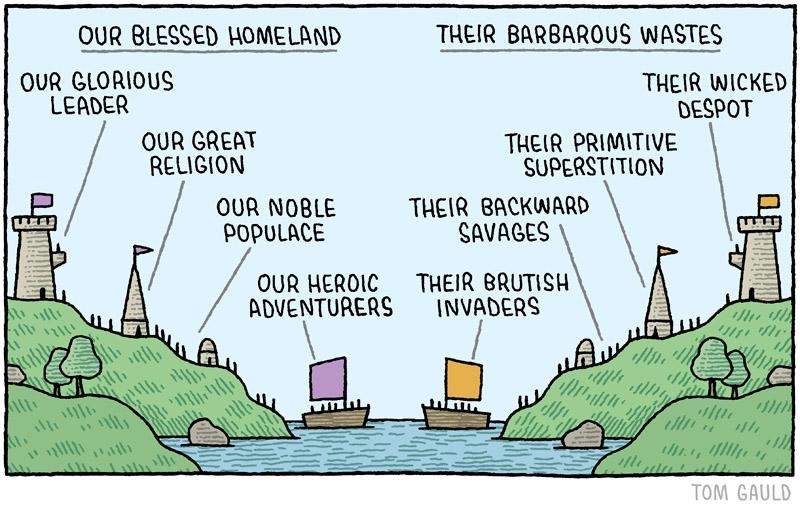 ("Our Blessed Homeland" (2015) by Tom Gauld. Source)
("Our Blessed Homeland" (2015) by Tom Gauld. Source)
[Having a set of strongly-held beliefs] We stick to our principles. They have a dogmatic ideology.
[Persuasive messaging] We're doing advocacy, speaking to the heart. They're doing propaganda, manipulating emotions.
[Doing something small but nice] We're raising awareness, showing solidarity, getting a small win. They're virtue signaling, doing it for PR, they're [x]-washing.
[An idea that's popular] Our idea is common sense, self-evident. Their idea is fashionable, a trite truism.
[An idea that's unpopular] Our idea is shocking, it challenges the status quo. Their idea is cringe, they're a bunch of edgelords.
And so on.
[Neutral description] We [positive spin] They [negative spin]
You've heard it over and over; critical thinking requires weighing arguments & evidence even-handedly, every idea deserves its fair trial in court, yada yada.
Alas, most of us, most of the time, think in words. And, like the proverbial glass that's half-full or half-empty, you can always describe the exact same thing in a way that sounds noble or like shit.
(These are called "emotive conjugations" or "Russell Conjugations", named after the mathematician-philosopher Bertrand Russell.)
After some... very infuriating conversations with some policymakers, and realizing my god it's full of wordcels... I just want to make a big frickin' list of Russell's Conjugations, so that:
- You know it's a warning sign when someone dismisses ideas as "propaganda" or "cringe" or "fashionable" without actually weighing the pros/cons of an idea.
- You can catch yourself & avoid using these conjugations in your own head, to make yourself a better critical thinker.
Progress: 60% ▶️▶️▶️◻️◻️ Honestly, the above writing is most of it.
Time on backburner: 3 years
Time to finish: A few days
Desire to finish: 4/5 ⭐️⭐️⭐️⭐️☆ Strangely, even though the idea of the Russell Conjugation is pretty well-known, I can't find a curated list of them online. So, nice value-add.
. . .
46. 💬 Common Wisdom is a Two-Timing Sumnabitch
Here's another post cautioning against being a wordcel who "thinks in words, not things".[43] Common wisdom, in the form of proverbs, is a two-timing sumnabitch, because you can almost always find a proverb arguing the opposite idea:
"Birds of a feather flock together." "Opposites attract."
"Take a leap of faith." "Look before your leap."
"Don't sweat the small stuff." "For want of a nail [...] the kingdom was lost."
"If at first you don't succeed, try try again." "The definition of insanity is doing the same thing over and over and expecting different results."
"The road to hell is paved with good intentions." "It's the thought that counts."
You can even find "common wisdom" arguing for and against "common wisdom":
"When in Rome, do what the Romans do." "If all your friends jumped off a bridge, would you too?"
This article was inspired by me getting mad at a movie review dismissing a movie I liked for having a trite message that could be summed up in a proverb. Bitch, every statement and its negation already has a proverb. The existence of a proverb is zero evidence for or against something's truth.
Progress: 60% ▶️▶️▶️◻️◻️
Time on backburner: 3 years
Time to finish: A few days
Desire to finish: 2/5 ⭐️⭐️☆☆☆ There's already many lists online that collect contradictory common sayings. My only "value-add" is framing it around a cautionary message: Don't be a wordcel. Go beyond words, and look at the actual damn thing.
(...she said, after typing 20,000+ words about all the things she didn't ship...)
. . .
47. 🧹 Clearing out the idea closet (47 projects on my backlog)

THIS CLOSET... IS CLEAN!
This exercise was... not worth it, but I learnt some things!
- Apparently, I can write 20,000 words in one week if I turn off my perfectionist-anxiety filter.
- And now that I've reviewed my whole backlog, I've a better sense of what I'd like to prioritize (anything 3 ⭐️ or above), and what I'd drop (anything less than 2 ⭐️). I now know what I actually value.
I'd like to give you a better ending, but again: goodbye perfectionist-filter. No polish here. The moral of the story is there is no moral and there is no story.
I'm just clearing out the closet.
Progress: 100% ▶️▶️▶️▶️▶️ I'M DONE
Time on backburner: 2 years
Time it took to finish: 1 week
Desire to finish: 5/5 ⭐️⭐️⭐️⭐️⭐️ I'M DONE!
: Adiabatic Quantum Computation
(the below was a text I sent to a friend, slightly edited)
So: adiabatic quantum computation (AQC)!
I kinda visualize the core idea like, I start with a simple valley with a bunch of magic water in it at its global minimum. The magic water can, uh, tunnel through hills I guess.
Then, I slowly morph that landscape into a landscape whose global minimum "describes" the solution to some problem I want. (e.g. each position in the landscape describes a path for a travelling salesman problem, the height is how long the path takes, the global minimum is what I want).
If I morph the hills slowly enough, the magic tunneling-water will stay in the global minimum throughout the evolution. It won't get trapped because it's magic and can tunnel through newly-appearing hills; again, as long as the evolution is slow enough.
Tying metaphor to AQC: You start with a simple Hamiltonian in its ground state. Then, slowly evolve the Hamiltonian to one that describes a problem you care about, and whose global minimum is the solution you want. If the evolution is slow enough, your wavefunction will stay in the ground state throughout!
This isn't just empirical, it's been mathematically proved from the rules of quantum mechanics, the Adiabatic Theorem. (I mean, I can't follow the proof, but good to know it exists).
The catch, you may figure, is in the phrase "slowly enough". HOW slow does it have to be? Wikipedia claims that the runtime is proportional to the inverse square of the gap between the global minimum and the next-highest local minimum. 1/g^2, where 'g' is the gap.
But then, why have AQC / quantum annealing computers like D-Wave not had huge successes? Because the way folks convert problems like Traveling Salesman into landscapes, leads to local-global minima gaps that get exponentially small as the problem size increases.
But my quantum octopus/fuzzy logic idea doesn't have this problem! The energy landscape my fuzzy gates create don't have false local minima, just the one saddlepoint! And even if that saddlepoint counts as a local minimum, the gap between it and the global minimum remains constant. (The saddlepoint is always at y = 0.5, the global minimum is at y = 1.0) Therefore, as far as I can tell, that means in theory (practical decoherence aside) AQC should be able to solve my quantum octopus in constant time.
Anyway "big if true", I've no idea, guess I'll faff around and find out.
Millennium Prize Problems on Wikipedia. In sum: "P=NP?" is the question, are all problems that are "easy to check" all secretly "easy to solve"? ↩︎
Arulanandham, Calude, and Dinneen (2002): Solving SAT with bilateral computing ↩︎
These fuzzy gates are the Zadeh operators or Gödel t-norm. I think they were independently discovered by the mathematicians Lotfi Zadeh & Kurt Gödel, respectively. ↩︎
Peckham (2011). Monkey, starfish and octopus saddles ↩︎
The "quantum" version of the P=NP problem: are problems that are "easy to check" secretly all "easy to solve" with ideal quantum computers? (practicalities & decoherence aside) ↩︎
John et al (2023): Dead rats, dopamine, performance metrics, and peacock tails: proxy failure is an inherent risk in goal-oriented systems ↩︎
Manheim & Garrabrant (2019): Categorizing Variants of Goodhart’s Law ↩︎
Bishop & Trout (2005) give a snappy overview: The Amazing Success of Statistical Prediction Rules (pdf) ↩︎
On YouTube: Fooling Image Recognition with Adversarial Examples (2017) ↩︎ ↩︎
See the final figure in the "Example: LeNet on MNIST" section of Tanay & Griffin (2018). The middle row are the adversarial examples (AE). On the left, with low L2 regularization, the AE's are basically indistinguishable to the human eye. On the right, with high L2 regularization, the AEs are clearly manipulated & messed up; hence, a human would pick up on those errors better. ↩︎
Twenge (2023): Here are 13 Other Explanations for the Adolescent Mental Health Crisis. None of Them Work. ↩︎
From HHS.gov, May 2023: Surgeon General Issues New Advisory About Effects Social Media Use Has on Youth Mental Health ↩︎
I'm gonna read this book by Scott Cunningham. It's free! Causal Inference: The Mixtape ↩︎
It's the force-directed graph drawing algorithm, but with the vertical (y) positions locked. ↩︎
Gwern (2014): Complexity no Bar to AI ↩︎
YouTube embed & summary of his 2019 talk on this blog post. ↩︎
Riff on the opening lines from a physics textbook written by David L. Goodstein: (content note: suicide) ↩︎
Usó-Doménech et al (2015). The paper gets a bit... woo, but it has at least this cool idea: First, define AND(a,b) = a*b, since that's a function that's 1 if both inputs are 1, 0 if either input is 0. Next: "true contradiction" → "p and not-p is true" → AND(p,NOT(p)) = 1 → p*(1-p) = 1 → p = e^±i*pi/3. A truth value in the complex plane. Math is nuckin' futs. ↩︎
Two famous examples: Gordon Tullock, a founder of public choice theory, and Bryan Caplan, creator of the term "rational irrationality". ↩︎
Yudkowsky & Soares (2017): Functional Decision Theory: A New Theory of Instrumental Rationality ↩︎ ↩︎
Will Macaskill (2019): A Critique of Functional Decision Theory ↩︎
The idea that "we must think & act universally" is so ingrained into philosophy, that even existentialist Jean-Paul Sartre (Sartre 1946), while disavowing "human nature", still believed "When we say that man chooses himself, we do mean that every one of us must choose himself; but by that we also mean that in choosing for himself he chooses for all men." Wtf? Sartre, did you really choose to become a full-time philosopher because you want everyone to be a full-time philosopher? Coz if that happened, nobody would grow crops and we'd all die. You choose your life for you, I choose my life for me. ↩︎
Wally Nowinski (2022), guest post on Noahpinion: America’s Top Environmental Groups Have Lost the Plot on Climate Change ↩︎
In 2018, Hidden Tribes did a demographically-representative survey of 8,000+ U.S. citizens. Summary by David Brooks in NYT: The Rich, White Civil War ↩︎
Haidt & Joseph (2004): Intuitive ethics: How innately prepared intuitions generate culturally variable virtues ↩︎
If you didn't hear, there was a crypto company called FTX that committed to invest billions of $ in a charity movement called Effective Altruism. Long story short the company was a scam and a lot of charitable projects end up screwed. Dylan Matthews (2022): How effective altruism let Sam Bankman-Fried happen ↩︎
"Wordcel vs Shape Rotator" was a stupid culture-war meme from two years ago (Gault 2022 for Vice), that got Rorschach Inkblotted into whatever thing someone wanted to insult. (Verbal vs Visual IQ, Theoretical vs Practical, Abstract vs Concrete thinking, Humanities vs STEM, People- vs Thing- orientation, Vibes vs Gears, etc.) Intentionally vague + Emotionally charged = Word designed to cause maximum brain-poisoning. Using "wordcel" is itself wordcel. But dang it... it's catchy. ↩︎
Jon Brodkin (2022) for Ars Technica: Google fires Blake Lemoine, the engineer who claimed AI chatbot is a person ↩︎
Abdullahi Tsanni (2023) for MIT Technology Review: Human brain cells hooked up to a chip can do speech recognition ↩︎
Haidt et al (2000): Moral Dumbfounding: When Intuition Finds No Reason. ↩︎ ↩︎
There's plenty of data supporting "rural = more cousin marriage" in Central Asia & North Africa where it's not taboo, but it's hard to get data from the U.S. or Canada, where it is taboo. So, I can't confirm if red states actually are more likely to have consensual adult incest. ↩︎
Tozdan, Briken, & Dekker (2019): Uncovering Female Child Sexual Offenders. See Table 2 for Prevalence Rates (PRs) of female child sex offenders, which range from 10% to 20%. These estimates are based off actual surveys of victims, not just what filters down to official reports. ↩︎
Christian argument for consequentialist morality: "Judge a tree by its fruit". Utilitarian argument for (acting as if) heaven/hell are real: Pascal's Wager. If it's noble to sacrifice one's life to save others' lives, it must be nobler to sacrifice one's after-life to save others' afterlives. Assume 100% of babies go to heaven. Generously assume 90% of adults go to heaven. So if you kill 50 babies, you go to Hell, but 5 others who otherwise wouldn't go to heaven: Net +4 souls saved, and you'll be rewarded in the after-after-life! ↩︎
Common argument for white nationalism: Black/Latino crime rates are higher than whites', so "let's separate". Counter-argument: men's crime rates are also higher than women's, so that argument also implies women should secede from men (which is possible: we have IVF, and soon we'll have IVG, to make sperm from female cells). Counter-counter-argument: YES. Hence, White Nationalist Lesbian Separatism. ↩︎
Layperson-friendly summary of the scientific consensus, by Scott Young (2023) ↩︎
Brand et al (2016): Separating Fact from Fiction: An Empirical Examination of Six Myths About Dissociative Identity Disorder See Table 1, "Dissociative Disorder Prevalence Studies > General Population". Results range from 1.10% (1 in 90) to 1.50% (1 in 67). ↩︎
McCarty et al (2005): Comparing Two Methods for Estimating Network Size Aside: it turns out that "you know 150 people" (Dunbar's Number) is kind of a myth. ↩︎
Andersen & Blosnich (2013): Disparities in Adverse Childhood Experiences among Sexual Minority and Heterosexual Adults: Results from a Multi-State Probability-Based Sample. Result: Sexual minority persons had higher rates of adverse childhood experiences (IRR = 1.66 gay/lesbian; 1.58 bisexual) compared to their heterosexual peers. (Note: Adverse Childhood Experience = "physical, sexual, and emotional abuse, neglect, exposure to domestic violence, familial mental illness, substance abuse and incarceration") ↩︎
Clickbaity title, but correct as far as I can tell. Jen Babakhan (2022) for Reader's Digest: 6 People Who Froze to Death—and Came Back to Life. ↩︎
Alas, the course already ended, but here was the website. Bafflingly, there's no official archive of the emails he sent out. ↩︎
Dobson (2007): Flu costs the US $90bn a year, report shows ↩︎
Example 1 (Mar 24, 2020). Example 2 (April 16, 2020). Akela Lacy (2020) for The Intercept: Kaiser Permanente Threatened to Fire Nurses Treating Covid-19 Patients for Wearing Their Own Masks, Unions Say ↩︎
Riff off a quote by Oliver Wendell Holmes Jr. From Holmes (1899): “We must think things not words, or at least we must constantly translate our words into the facts for which they stand, if we are to keep to the real and the true. [emphasis added]” ↩︎